Colosseum & Roman Forum Guided Tour
Rome Tours by Gray Line. Day Tours & things to do. > Tours > Colosseum & Roman Forum Guided Tour

Colosseum & Roman Forum Guided Tour

Step back in time on our guided tour of the Colosseum, Roman Forum, and Palatine Hill. Discover the epicenter of Roman power and glory with knowledgeable guides. Immerse yourself in ancient history and marvel at the architectural wonders of the Eternal City. Don't miss out – book your tour today for a journey through the heart of ancient Rome!
- Guided tour of the Colosseum and Roman Forum (visit inside)
- Step back in time into the archaeological wonders in the heart of the Roman Empire and soak in 2000 years of history and battles
- Explore the ruins of the Roman Forum
- Limited to 20 participants
- Guided tour of the Colosseum and of the Archaeological area
- Professional guide
- Wireless audio headsets
- Meeting point option available
- Transportation (if not selected)
- Food and beverages
Please Note
- Customers must adhere to the assigned guide throughout the tour.
- External guides cannot be added to the group after purchase.
- Heightened security may cause delays.
- Guests with pacemakers must present a certificate to bypass security screening.
- Provide first name and surname for all reservations
- You should provide complete names to prevent potential refusal.
- Passport mandatory on the tour day.
- Moderate physical fitness is recommended.
- Wear comfortable shoes and bring sunscreen during summer.
- Bulky bags, trolleys, and glass bottles are not allowed.
- No cloakroom facilities are available.
- The areas are not wheelchair accessible and may pose challenges for individuals with mobility issues.
When would you like to go?
Unavailable, please select:, options selected:, optional extras, price breakdown:.

Pickup points
Not booked your hotel yet? Hotel not listed? Staying with a friend/family?
Don't worry, you can give us that information when you add this item to your cart.
Pickup Info
Meeting point: Arch of Constantine (Piazza dell’Arco di Costantino) 15 minutes before the start of your tour (please look for the I Love Rome logo carried by our staff). Tours with pick-up : our Team will contact you the day before to inform about the pick up from your hotel. Please, be ready in the lobby as per indications. Identification: Please ensure you have valid ID/passport, as it will be mandatory to bring on the day of the tour. Otherwise, you might not be allowed to proceed. Gray Line - I Love Rome office: Via Cavour, 309 (6:30 AM – 6:30 PM 365 days) [email protected] 0039 06 474 2501 / 0039 348 8112027 (Whatsapp only) (November to March, Monday to Saturday, 6:30 AM – 7:00 PM & Sunday 6:30 AM – 8:15 PM April to October, every day, 6:30 AM – 9:00 PM)
You may also like

Combo 24H Bus & Santa Maria Maggiore

Combo 24H Bus & Santa Maria Maggiore Audioguide

UNESCO Jewels: Tivoli and Its Villas

Vatican Museums Guided Tour or Ticket only with reserved access

Your browser does not support iframes

Colosseum, Roman Forum & Palatine Hill
Enter your dates to find available activities
Number one tour

Skip the Line Colosseum Arena Floor & Ancient Rome
- Gladiator Entrance
- Arena Floor
- Duration : 2.5 hours
Best Colosseum Tours

Skip the Line Colosseum, Roman Forum and Palatine Hill Tour
- Small Group
- Skip the line
- Duration : 1 hour
- Priority Access
- Ancient Rome
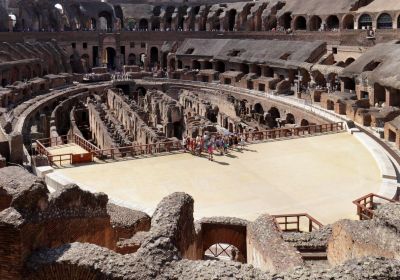
Priority Access Colosseum Underground & Ancient Rome
- Colosseum Underground
- Duration : 3 hours
Free cancellation
About the roman forum.
If you want to visit the heart of Ancient Rome, the Roman Forum Tour is the best way to experience the history of the ancient city. You will walk down the Via Sacra, or Sacred Way, of the Roman Forum, also known as the triumphal road. This is the same path that victorious Roman generals would follow when they returned from abroad. Every stone that lies within the Roman Forum is connected to the great moments from Ancient Rome’s past.
The Roman Forum Tour will also lead you past the triumphal arches. The Arch of Titus is especially well preserved and detailed. The Arch of Constantine is also visible from the 2nd floor balcony of the Colosseum. Only a few of these incredible arches still remain, and even fewer are well preserved.
During the Colosseum and Roman Forum tour your guide will lead you through the once bustling marketplace that was ruled by the shopkeepers and moneylenders. The Roman Forum was the focal point of the Ancient Roman Empire and was home to many religious and political buildings such as the Basilica of Maxentius and the Senate House. Although this was not the Senate House in which Julius Caesar was assassinated, you will find the temple of Julius Caesar in the Roman Forum.
With so many layers of history and architecture in the Ancient City, choosing a Colosseum and Roman Forum tour is an excellent way to experience it all. You will walk the ancient roman roads with a local guide who is an expert in their field. Not only will you visit Rome’s most famous monument, you will learn the history as well. When you walk past the broken pieces of marble strewn about the valley and past ancient temples, it is hard to believe that this area was once a vast swampland.
About the Palatine Hill
An exploration of ancient Rome would not be complete without a Palatine Hill Tour. Learn about the legend of the twin brothers, Romulus and Remus , and see where their battle for the city took place. Archaeologists are always finding something new on the Palatine Hill, in 2007 an underground chamber was found that is thought to have been the Lupercal, the chamber where legend says that Romulus and Remus were suckled by a she-wolf. Of course this seems like a far-fetched idea today, but the ancient Romans truly believed it.
The Palatine Hill is one of the famous seven hills of Rome and eventually became the site of the imperial palaces.The hill was inhabited by wealthy citizens who used it to escape the heat, noise and smells of the crowded city. It eventually became the home of the emperors after Domitian built an expansive palatial complex. During the Palatine Hill Tour you will get to see what remains of this massive palace as your guide describes its ingenious design.
From the height of the Palatine you will enjoy wonderful views of Rome’s skyline . You can look down over the Circus Maximus and imagine the emperors watching the chariot races taking place down below without the need to leave their palace. From the other side of the hill you get an amazing view of the Roman Forum spreading out before you. Having a guide with you during the Palatine Hill tour makes the experience much more interesting and enjoyable.
Don’t miss the chance to explore the Palatine hill and see one of the oldest parts of the city . Having a guide makes all the difference when it comes to ancient history and architecture. Rome’s incredible history will be brought to life and your guide will transport you back to ancient roman times.
About the Colosseum, Roman Forum and Palatine Hill
There is no better way to experience Ancient Rome than by taking a Colosseum, Roman Forum and Palatine Hill Tour. Exploring what remains of the Ancient Roman empire with an official guide is an exciting and interesting way to spend your time in Rome. There is so much history and so many hidden details that you will never find without the knowledge and experience of a professional guide.
During the Colosseum tour you will have a chance to inspect its magnificent facade and check out the roman numerals above the arches. Your guide will describe why the Colosseum’s walls are covered with holes and the differences between the columns. The intrigue only grows as you enter the monument and hear about the drama and gore of the gladiator battles.
You will go back in time as you walk through the Ancient City during the Roman Forum and Palatine Hill guided tour. It is easy to imagine a bustling city center and marketplace as your guide describes what life was like in Rome during ancient times. As you walk through Roman Forum your guide will lead you past the Temple of Julius Caesar as well as the Basilica of Maxentius. Strolling up the Palatine Hill you will pass by the Arch of Titus and appreciate the intricate artistry and craftsmanship of the reliefs. The tall umbrella pine trees that are so iconic to Rome create a lovely atmosphere as your guide describes the incredible palaces that once reigned over the city. With a gorgeous view unfolding in front of you and your tour guide sharing their expertise, the history of Ancient Rome has never been more engaging .
The tour of the Colosseum as well as the Roman Forum and Palatine Hill tour combine to create an immersive and unforgettable experience of Rome’s fascinating history.
Travel Tips
Make sure to arrive at least 15 minutes before your scheduled start time, this will ensure you have enough time to find your meeting point for the Roman Forum and Palatine Hill guided tour.
While there are a few on-site toilets at the Colosseum, the waiting time can take a while. So be prepared!
You won’t find any luggage facilities, restaurants or cafes on-site.
All of the entrances to the Colosseum, Roman Forum and Palatine Hill have a mandatory security check. This check cannot be avoided and is necessary for the safety of all visitors.
Only small bags are allowed inside the Colosseum. No luggage or bags with wheels are allowed.
The people with reduced mobility can easily access the Colosseum as paths at all the available routes are marked. Some tours may not be wheelchair accessible, so be sure to check the tour details or opt for a private Colosseum tour.
It is highly recommended to get your tickets ahead of time online and set aside the majority of your day to properly enjoy the Colosseum visit.
The Colosseum tour prices vary and can cost anywhere from 30€ up to 100€, or more. The type of tour you choose - express, underground, arena - will be reflected in the price and duration of the tour.
- It is highly recommended to get your tickets ahead of time online and set aside the majority of your day to properly enjoy the Roman Forum and Palatine visit.
- The Roman Forum and Palatine Hill tour prices vary and can cost anywhere from 30€ up to 100€, or more. The type of tour you choose will be reflected in the price and duration of the tour.
Know Before You Go
Covid Safety measures:
All the areas that customers come in contact with are frequently cleaned
In order to reduce crowds, the number of visitors is limited
Customers are required to bring and wear face masks
There is a mandatory temperature check for customers
Social distancing standards must be maintained inside the monument
What to bring:
Weather-appropriate clothing
Comfortable shoes
Passport or ID card
Arena entrance & Reduced price tickets:
As the Colosseum Arena Floor is a restricted area, visitors will have to provide details such as their full name, date of birth, and a valid ID card as they’re entering the monument.
People who have booked tickets at the reduced price for ages 2 to 15 years old will also be required to show an ID.
Things that are not allowed:
Aerosol sprays
Any kind of weapons or sharp objects.
Luggage or large bags. Even smaller bags with wheels are not allowed.
Getting There
- Metro: The Colosseum metro stop is located on the B line of Rome’s metro. Check the map at your local station.
- Regional Train - Take the underground line B from the Termini Station and get off at the Colosseum stop.
- Bus - There are many public buses that stop in front of the Amphitheatre on your Colosseum tour: 75, 81, 85, 87, 117, 118.
- Car: There are paid parking spots available in the neighbourhoods surrounding the Colosseum.
- Tram: Tram #3 passes the Colosseum
- Bicycle: The Colosseum is accessible by bike, just make sure to lock your bike in an appropriate place. Bikes that are locked to the railings in archaeological areas could be taken by the police.
Note: The Imperial Forum Road is closed to car and bus traffic on Sundays, which means it’s the perfect time to go for rental bikes or take a nice walk along via Fori Imperiali towards the Colosseum. Some bus routes are deviated on Sundays, so be sure to allow extra time to arrive.
Top Categories

Search activities
Visiting the Roman Forum: all you need to know + best things to see and tips
All you need to know to plan a visit to the Roman Forum. Where to get the best tickets, the best things to see in the Roman Forum and the Palatine Hill, practical tips. Updated June 2021.
The Roman Forum is the heart of Ancient Rome and, nowadays, one of the most important archaeological sites in Rome and in the world.
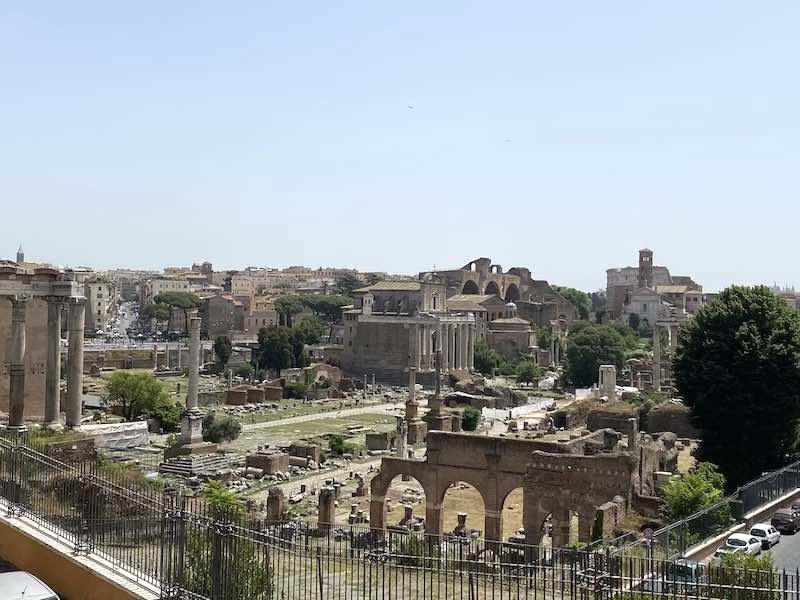
The ancient Rome Forum sits inside what is now the modern city and it is nestled between the Colosseum on one side, the Campidoglio Hill on the other, and the Palatine Hill, where the Palaces of the Emperors lie.
It is one of the most beautiful places in Rome however, it is also a place that attracts less attention than the nearby Colosseum.
While the Colosseum is on the bucket list of pretty much any Rome visitor, it is not unusual to find people wondering if the Roman Forum is worth visiting at all and I think the question is worth a proper answer.
While I believe the Roman Forum is stunning and a must-see for everybody I also believe that it is important to go there being prepared to what the forum is, what it isn’t, what to expect and how to tackle it at best.
This is my guide to visiting the Roman Forum.
Good to know . As well as being born and raised in Rome, I am a classics graduate and my dissertation was on Ancient Rome. So you can say I am biased when it comes to the Forum: I do love it! For the longest time, the Forum didn’t have good explanation panels and my recommendation was to get a guide to make the most of your visit. While I believe a guide is still worth it, the free app ‘Parco Colosseo’ now exists and operated almost as an audio guide. A good, budget-friendly option to see the Roman Forum!
Table of Contents
All you need to know to plan a visit to the Roman Forum
The Roman Forum is the area of Ancient Rome where public and religious life used to take place.
The Forum is now an archaeological site and, in a way, you can say that the Roman Forum is Ancient Rome.
Unlike the Colosseum or the Baths of Caracalla, that are two ancient stand-alone buildings, the Roman Forum is a large area where you literally walk along ancient Roman streets.
The area is large and mostly outdoors. Being prepared for the weather and for the uneven terrain is a must: I share all my tips on how to dress and what to bring to the Roman forum later in this guide.
The best things to see in the Roman Forum
The Roman Forum is a rather large area with plenty of things to see.
The Forum Proper is a flat area comprised between the Capitoline Hill and the Palatine Hill, the two most significant of the seven hills of Rome.
The Palatine Hill is immediately above the Forum and it is accessible though it. The Hill is where Romulus, Rome’s founder, set his hut and where the Emperors then built their palaces.
The best things to see in the Roman Forum are both on the Forum Proper and on the Palatine Hill. Let’s have a look at them.
Via Sacra is the Main Street crossing the Roman Forum.
Nowadays, you see is as connecting the Colosseum to the Capitoline Hill but it predates the Colosseum by many centuries.
The tradition reports that the Via Sacra was were Romulus won over Titus Tatius King of Sabina (VIII century BC) and while at the time the road was a little more than a muddy trail, this tells us some form of street here must have been in use from very early on.
The paving of the street as we see it now is made of slabs of basalt and seems to date from Augustan times (I century AD).
In historical times, the road was used for thriumphal procession after successful military campaigns.
The military parade would walk along this road with the prisoners and the flags of the enemy, bringing the victorious general in triumph all the way to the top of the Capitoline Hill, where the temple of Iuppiter Optimum Maximus (Jovis) used to be.
The Via Sacra is now one of the most scenic areas of the Roman Forum, especially close to the Colosseum, where tall columns are still standing, giving a sense of what this road must have looked like at its best.
The triumphal Arch of Titus
The first impressive monument you find on Via Sacra is the fantastic Arch of Titus.
The arch is one of the three triumphal arches in Rome and dates from the I century AD.
This is a celebratory monument build by order of Emperor Domitian, to honour his precedessot Titus.
As the inscription and carvings on the arch show, the arch commemorated Rome’s victory over Jerusalem and the taking to the temple, an event historians describe as happened in 70 AD.
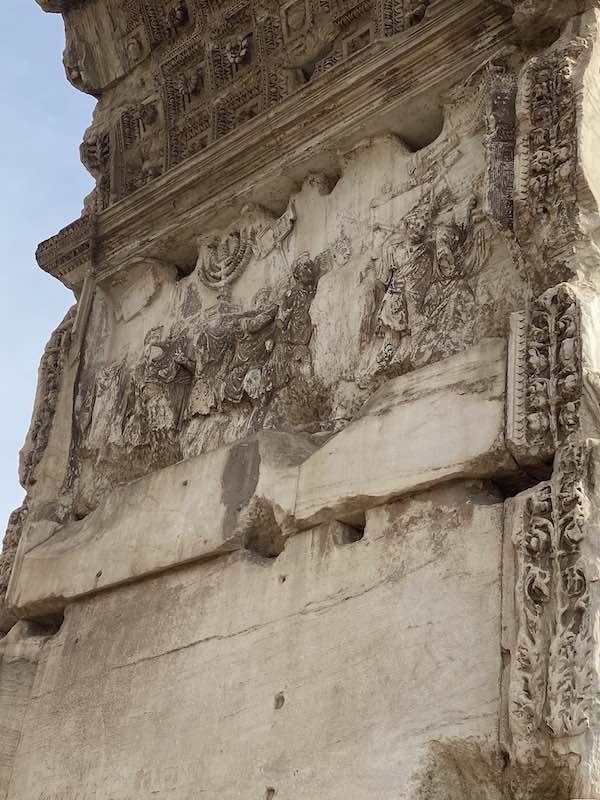
The Temple of Antoninus and Faustina
One of the most beautiful and best preserved buildings in the Roman Forum is the Temple of Antonino and Faustina.
The Temple sits on the spot where the Via Sacra meets the Forum and it was built in 141AD for Emperor Antoninus Pius and his wife: Faustina.
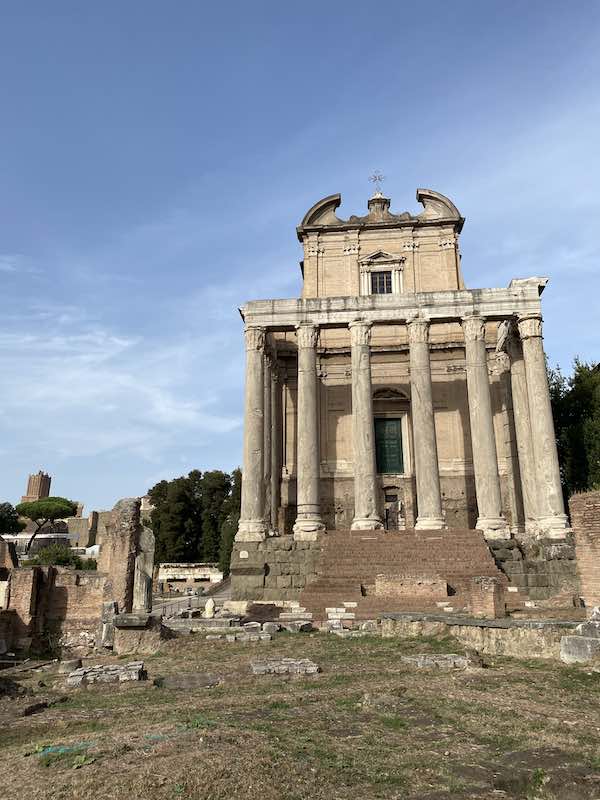
Like many ancient religious buildings, the temple became a a church in the Middle Ages and acquired the name of San Lorenzo in Miranda: this fate changed its appearance but it also ensures its preservation and allows us to enjoy it today.
An inscription at the top of the temple says ‘Divo Antonino et Divae Faustinae Ex. S.C.’ which means that the Senate dedicates this temple to the Emperor and his wife.
The temple stands on a podium with a height of 5 meters and is accessible by a recent staircase. This is one of the tallest buildings in the Roman Forum and one of the most eye-catching.
The Temple of Divus Romulus
The so called Temple of Divus Romulus is a round structure opening onto Via Sacra, inside the Forum.
It is not sure what the use of the temple originally was but we know it was built by Emperor Maxentius at the beginning of the IV century and was later incorporated into the church of Saint Cosma and Damiano, built here in the VI century by order of Pope Felix IV.
This temple is stunning and holds unique worth seeing. Please note that this temple is only accessible with the ‘Full Experience’ ticket.
The Roman Forum Square
The main square of the Roman Forum is a large area at the center of the Forum where all the most important business transactions and public events in the city would take place.
The area was an open unbuilt area for a long time but acquired an increasing number of public buildings and monuments, the latest of which is the column of Phocas, one of the most significant columns in Rome , dedicated in 608AD to the Eastern Roman Emperor Phocas.
Along the short sides of the square, there stood the platforms from where the orators would speak, the Imperial Rostra, the Rostra Vandalica and the Rostra ad Divi Iuli, dedicated by Augustus to Julius Caesar.
On the northern side of the square used to lay the Basilica Emilia: this was a civic area that used to serve as bankers’ headquarters and seems to date to the I century BC, yet the restored and modified many times in subsequent centuries.
On the southern side of the Roman Forum square there used to be another basilica, the basilica Iulia. This basilica seems to have been used for political, judiciary and economic activities and it takes its name from the person who commissioned its built: Julius Caesar.
Fun fact : here is where you can see remains of tabulae lusoriae , the ancient Roman equivalent to our board games! This is one of the best things to show children if you are visiting the Roman Forum with kids.
The Curia was the ancient seat of the Roman Senate. It is a large brick building wanted by Julius Caesar and inaugurated by Augustus, modified by Diocletian and finally turned into a church in 630 AD, fate that allowed the preservation of its beautiful Byzantine Frescoes and its stunning bronze door.
The Arch of Septimius Severus
The Arch of Septimius Severus is a large triumphal arch dating to the III century AD.
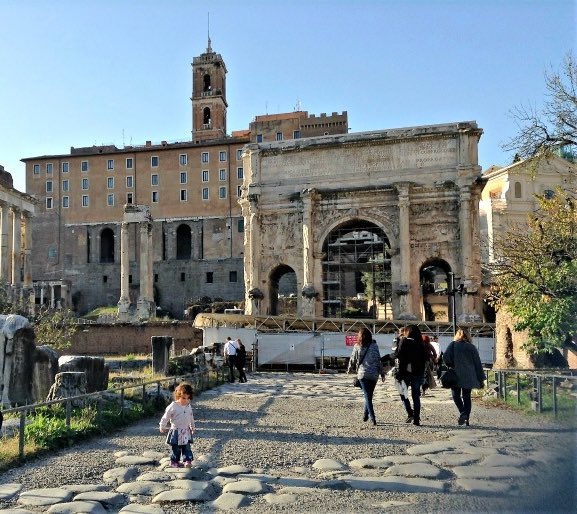
It sits at the end of Via Sacra, just below the slopes of the Capitoline Hill and it made of travertine, brickwork and marble.
The arch has the impressive size of 25×11.20×11 mt.
An inscription tells us that the arch was built to honour the Emperor and his son for ‘restoring the State and extending the empire of the Roman people’ and it used to have a bronze sculpture on top that would overlook the Forum.
Fun fact: in the Middle Ages, the arch became a fortress tower! It was restored only in the 1980s.
The House of the Vestals
The house of the Vestals is one of the prettiest areas in the Roman Forum.
It is one of the most ancient buildings in the city and it is usually associate with King Numa Pompilius, who established the Vestal Virgins as an institution.
The house got destroyed during the large fire of 64AD but was then rebuilt so we see now a later version of it. Still well visible are the rooms, the stairs to the upper floors and the portico, one of the most beautiful spots I the whole of the Forum.
The Temple of Vesta
The Temple of vesta is on the Eastern side of the Roman Forum and it easy to recognize thanks to its distinctive round shape.
The temple used to be part of the same complex as the house of Vestals, nearby. The temple was badly damaged however, ancient coins tell us the shape it would have had and restoration work from the 1930s patched up some of the fragments found in the area.
The Regia is said to be the place where King Numa Pompilius used to reside. This is one of the oldest sites in the Forum, with remains archaeologists were able to date back to the Iron Age.
The ancient necropolis
Between the temple of Antoninus and Faustina and the Temple of Romulus, archaeological excavations in the early 20th century brought to life and ancient necropolis (cemetery).
These graves date from the Latin Age (X century BC) and therefore predate almost anything else in the Forum. These are an important find for historians and archaeologist as they shed a light on a much more ancient use of this area that our ancient Roman sources do not cover.
The Farnese Gardens
If, from the Forum, you look up towards the Palatine Hill, you will see a structure that is clearly not ancient but rather from Renaissance Times, the ‘Farnese Gardens’.
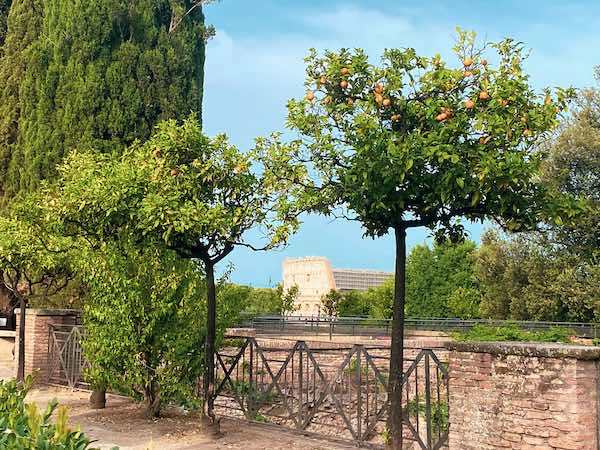
The Gardens were built in the early 1500s by Pope Paul III Farnese and quickly became among the most extraordinary gardens in the city for variety of plants and views.
The construction of the gardens took many years and their appearance changed in the XVII century, when two large aviaries where added, and then again up until the early 1930s.
What to see on the Palatine Hill
This is a quick overview of what you can see on the Palatine Hill as you climb up from the Roman Forum.
You can find here >>> our complete guide to the Palatine Hill for first time visitors .
The Palatine Hill is one of the ancient seven hills of Rome and the place Romulus fonder of Rome chose as the location for its new city.
The Palatine Hill is one of the most beautiful places in Ancient Rome and can be accessed from the Roman Forum, which it overlooks.
Things to see on the Palatine Hill are:
The huts of Romulus
The huts of Romulus are in the area of the Palatine called the Germalus, on the hill’s southwestern corner.
This is a group of dwellings that that seems to have been inhabited since the IX century BC and one of them is usually referred to as the ‘House of Romulus’, a full replica of which can be seen in the Palatine Museum.
This is a fantastic place to get acquainted with the very early days of the city of Rome.
The Palace of Emperors
In terms of visual effect, the most impressive sight on the Palatine Hill is the Palace of Emperor.
The Domus was built at the end of the I century AD by Emperor Domitian and it is divided into three parts: the Domus Flavia, with the rooms for business and entertaining guests, the Domus Augustana, the actual house of the Emperors, and the Stadium or Hippodrome, the palace garden.
The Palace is stunning to see: if you have time, I highly recommend you go to the Circus Maximus after your visit. It is just below the Palace, outside the archaeological park, but it offers outstanding views of the palace for the outside, the perfect complement to the sight you get from the Palatine.
The Palatine Museum
The Palatine Museum stands at the top of the Palatine Hill and hosts a collection of artefacts that spans over fifteen centuries of history of Rome, from its foundation to the highest successes of the Roman Empire. A must-see for history lovers.
The Roman Forum: frequently asked questions and need to know
What was the roman forum.
The Roman Forum was the administrative area of Ancient Rome.
It was the heart of the city, the place where religious, legal and political affairs took place and, as such, the beating heart of the political life in Rome.
Here, you would have had temples, some still visible, basilicas (a sort of meeting hall, at the time), religious buildings and of course streets and celebratory buildings such as the arches still standing at the two sides of the forum.
What is the Palatine Hill?
The Palatine Hill is one of the 7 hill of Rome and is usually mentioned with the Roman Forum is is just beside it and is accessible from the Forum itself.
The hill is historically significant and beautiful: here, you have the ruins of the palaces of Emperors, a museum, ongoing excavations and stunning views over Rome .
Is the Roman Forum beautiful? Is it worth seeing?
There is no doubt that the Roman Forum is a must-see place for anyone with an interest in Ancient Rome, but I believe the forum it is worth seeing also if you just want to see a beautiful place.
The area of the forum is simply stunning!
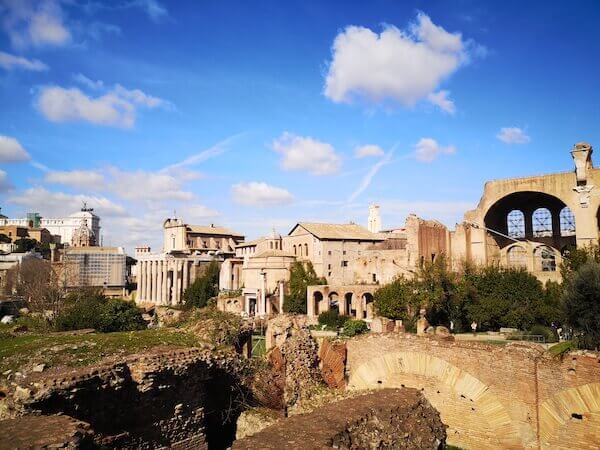
The Forum is now an open-air archaeological park and you can easily enjoy it even just as a place for a leisurely stroll.
If you go on a bright day, especially in the spring or the fall, the forum is simply breathtaking: you can easily walk to one side to the other in a matter of minutes and you can simply follow your curiosity picking and choosing the areas that attract you the most.
The most beautiful part of the Roman Forum is, for me, the walk up the Horti and the Palatine Hill. You will feel the steps in your legs but, once on top, you have the ruins of the palaces of emperors and views over Rome that are simply breathtaking!
The pine trees that are typical of the Rome landscape frame the Colosseum and the Forum below and give you a photo op like no other!
Is there a dress code for the Roman Forum?
There is no dress code for visiting the Roman Forum. Clothing rules such as no shorts or no strappy tops only apply to religious buildings and main basilicas such as St Peter but not to archaeological sites.
The only thing to keep in mind when visiting the Forum is practicality: good shoes are a must and weather appropriate clothing for the season of your visit will also be important.
You can find our tips on what to wear for the Roman Forum below.
How to visit the Roman forum: guided tour or self guided? 2021 Update
The Roman Forum is a place so full of history and thing to see it is best enjoyed with a guide.
The area has almost non existent info panels so without some form of guidance, you can enjoy its beauty but you won’t understand much.
The cheapest way to visit the Roman Forum is by getting standard tickets and downloading the Parco Colosseo app.
The app is free and has explanations in several languages about the main sights in the Roman Forum and on the Palatine Hill.
If you have a smart phone, this is an excellent option and it also has a recommended itinerary for kids and another one for the visually impaired.
If your budget allows, then I recommend you take one of the may Roman Forum tours available (see below)
How to get the best Roman forum tickets
You can buy tickets to the Roman Forum on the day or you can book them online here. If you do so, make sure you pick a solution that works for you: there are several combinations, offering access to different things.
The tickets include a visit to the Colosseum (all areas or just some parts depending on the ticket), the Roman Forum and the Palatine Hill, with the exception of some ‘super sites’ that you may need to book separatly.
Best Roman forum tours
Tours of the Roman Forum are bundled up with a visit to the Colosseum.
The best we have tried are:
- Priority Entrance to Colosseum, Forum and Palatine Hill with guide
- Colosseum (includes underground tier) and Roman Forum guided tour
- Walking tour of the Colosseum, Roman Forum and Palatine Hill (3 hours)
- Colosseum and Roman forum tour for kids (suitable for primary school kids too)
Need to know: the tours tend to give priority to a visit to the Colosseum, which usually takes up to 2/3 of the tour. If you are interested in a more specialized tour, then I recommend you get a private guide instead .
How long to visit the Roman Forum
It usually takes me between 2 and 3 hours to visit the Roman Forum and I would recommend to plan half a day if this is your first visit.
Technically, you can spend as little or as long as you wish here, however, I think within this time frame you can see some of the forum most impressive area, such as the temple of Antonino and Faustina, the House of the Vestals and the Horti and also the Palatine Hill.
What is the best time of day to visit the Roman Forum?
The best time of day to visit the Roman Forum depends on the season.
In spring and autumn, the best seasons to visit Rome, you can go pretty much any time of the day, with only one caveat: the late morning and lunch hours can get busy!
Aside from that, you don’t have particular constraints when it comes to weather and time of visit, in mid season. The situation changes if you are visiting in winter or summer.
In winter, the best time of the day to visit the Forum and the Palatine hill is the late morning / lunchtime.
The Forum and even more the Palatine can get really cold in winter and being there in the warmest hours of the day will go a long way to make you enjoy your visit.

Also, consider that in winter the Forum closes pretty early (about 4 pm) and darkness comes early too, so an earlier start is recommended.
In summer, it is the opposite!
The Roman Forum in summer gets scorching hot and must be avoided at lunchtime and in the hottest hours of the day at all costs.
The best time of day to visit the Roman Forum in summer is the early morning or the late afternoon (check the time of the last admission though, you want to make sure you have enough time).
What to wear to visit the Roman Forum
You do not need particular equipment to visit the Roman Forum, but it is worth knowing a couple of things:
The terrain in the Forum is uneven, so you are recommended to wear good walking shoes or sneakers: no heels. Find my recommended shoes for Rome sightseeing here.
There is very little shade in the forum so especially in the warmer season, it is important to wear a hat.
In winter, the Forum can get surprisingly cold and the Palatine Hill gets even colder: wrap up well and do go during the warmest hours of the day for the best experience or humidity may get to you and make your visit seriously unpleasant.
Is there food and facilities inside the Roman Forum?
The Roman Forum has some restrooms and drinking fountains but it is overall hardly equipped with food.
I highly recommend you take care of breakfast and lunch before you come: picnics are now allowed.
Is the Roman Forum accessible?
The Roman Forum is not entirely accessible but does have some defined paths for wheelchair users. You can find all the pupated information on the paths and lifts here
Visiting the Roman Forum with kids
We have brought the kids to the Roman Forum several times and it is always a good day out.
It is, however, a day that can pose some challenges, so it is good to be prepared.

These are the important things to know before visiting the Roman Forum with kids:
You can enter the Roman Forum with a stroller however, only part of the Forum is paved. If you can, I highly recommend you leave the stroller at home, especially if also visiting the Colosseum (find my tips for visiting the Colosseum with kids here).
Kids will be tempted to climb on top of the ruins but this is not allowed. There is however a good playground close to the Colosseum , which you can easily reach after your visit and works well as a bribe!
There is no food inside the Forum and picnics are not allowed. However, it is ok to hand out a snack to a child so if you have small food for them, that’s ok.
If you ate visiting Rome with kids, do not forget to also check out our favorite things to do in Rome with kids here .
Top tip: the free app ‘Parco Colosseo’ includes a kid-friendly itinerary!
Should you visit the Roman Forum and the Colosseum on the same day?
The Roman Forum and Palatine hill are just beside the Colosseum and you can visit both in the same day.
A short visit to the Colosseum can take as little as 45 minutes and the Forum is only a minute across the road. Here, you can spend an hour, four or even a day.
I recommend you schedule at least three hours for a quick Forum visit, a full afternoon for a proper one.
How to get to the Roman Forum
You can get to the Roman Forum by metro, bus, tram or one foot.
- The closest metro station is ‘Colosseo’
- All buses serving the Colosseum serve the forum too, as well as those serving Piazza Venezia.
- Tram number 3 stops nearby
- The Roman Forum is walking distance from Piazza Venezia, Colosseum and the Pantheon
Where to get the best Roman Forum views?
The Roman Forum is a powerful site and there are some amazing photo locations to capture its might, some inside the Forum itself, and some outside!
One of the best views is from the Horti, inside the Forum, on the way up to the Palatine Hill. From here, you see the Forum and also the Colosseum.

Another stunning view over the Roman Forum is from the back of the Campidoglio Hill. This view is free and easily accessible walking up the Campidoglio and going to the back of the main budding. The Roman Forum will be at your feet!
So, is a visit to the Forum worth it?
Yes, I believe a visit to the Roman Forum is worth it and not just for history lovers. The beauty of the place itself a reason for visiting, especially in spring and autumn.
I hope you enjoyed this practical guide to visiting the Roman Forum. Happy travel planning!
My name is Marta, I am a travel-loving mama born and bred in that messy, wonderful, infuriating, awe-inspiring unbelievably beautiful city that is Rome. A classics graduate and professional travel blogger, on this site I share my insider tips to help you plan your dream trip to Rome, Italy.
What to wear in Rome in October: packing list and tips from a local
Movies set in rome that will make you feel like you are in rome right now, you may also like, how to see rome in two days: perfect..., fun and interesting facts about the colosseum for..., christmas markets in rome you will love this..., how to see the best of rome in..., free things to do in rome you’ll love..., how to buy tickets for the pantheon +..., how to visit the spanish steps in rome:..., largo di torre argentina: all you need to..., 40+ rome hidden gems you’ll love, outdoor swimming pools in rome you’ll love this..., privacy overview.
Roman Forum
Tickets sell out fast in Rome: check availability now »
Journey into the heart of Ancient Rome at the Roman Forum.
Discover the center of Roman society at the Forum, where laws were decreed, politics discussed, and goods bartered.
This is the beating heart of Ancient Rome : an unmatched social, economic, religious, and political powerhouse.
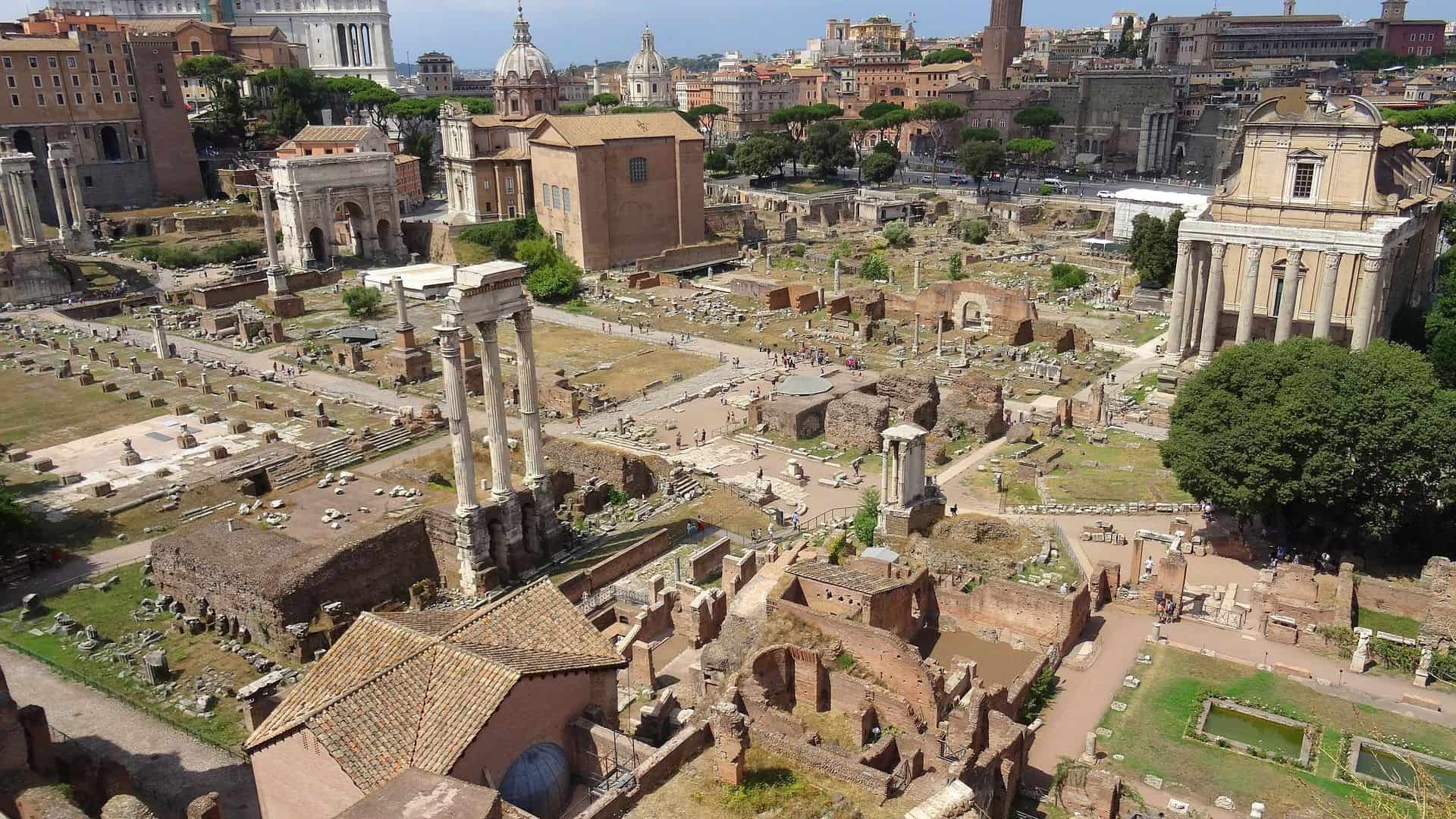
- Wander down the Via Sacra, the Main Street of Ancient Rome.
- Visit the temple and home of the Vestal Virgins – and discover where they would tend to the sacred eternal flame of Rome.
- Weave between the ruins of temples, meeting halls, and monuments in the Forum, and see the gravesite of the infamous Julius Caesar.
Everything You Need to Know About Visiting the Forum
Your entry to the Roman Forums and the Palatine Hill is usually included with your Colosseum ticket since the Forum is part of the same archeological park ( Parco Archeologico del Colosseo ).
The great thing is that it’s valid for 24 hours before or after your entry to the Colosseum. This means you are not obliged to see both on the same day. In fact, for reasons I’ll go through with you below, I would wholeheartedly recommend you see the Roman Forum first (ideally the afternoon before) and then see the Colosseum the following morning.
To get there, you have two options. Either you take the main entrance via Via Sacra (opposite the Colosseum) whereby you enter through the Arch of Titus OR enter from Via di Gregorio (just after the Arch of Constantine) for a more relaxed way in.
I’ll show you the Via Sacra entrance way as, while the busiest, is also the most evocative. But it’s your call.
This guide assumes you have a prebooked ticket with no guide.
Tickets & Prices
Explore the Roman Forum with ease by purchasing a ticket beforehand. You won’t have to waste extra time in the purchasing queues and can breeze through the ancient site.
Find out which of these Roman Forum tickets is best suited to you.
- Colosseum, Roman Forum & Palatine Hill (Priority Entrance) – Skip the line with this priority entrance ticket.
- Colosseum, Roman Forum & Palatine Hill (Last Minute Priority Entrance) – Last minute ticket for Colosseum entry.
- Rome Tourist Card (Bestseller) – See the best of Rome with this popular combi-ticket. Includes access to The Colosseum, Roman Forum and Palatine Hill, Vatican Museums & Sistine Chapel, St. Peter’s Basilica (official guided tour), and more…
- Rome Super Pass with Public Transport – Skip-the-line entrance to some of Rome’s best attractions with this combi-ticket. Includes unlimited public transport PASS (metro, bus, tram).
Tickets for Colosseum, Roman Forum & Palatine Hill
Entrance to the neighboring ancient sites of the Colosseum and Palatine Hill is also included with these tickets. You get to skip the queues and also download a digital guide to teach you the history of your surroundings.
Important Ticket Information:
- The tickets are valid for two days (including the day of activation).
- Re-entry is not possible once you leave the site.
- Palatine Hill is open from 10:00 – 19:15. While both the Colosseum and the Roman Forum are open 09:00 – 16:30. The last admission is an hour before closing.
- You should head to the Via dei Fori Imperiali entrance to enter the Roman Forum.
- You can choose between 5 visit routes, which vary from 30 minutes to 2.5 hours.
Rome Tourist Card
The Rome Tourist Card is the ultimate pass for new visitors to Rome. It grants you access to the city’s most iconic sights, from Palatine Hill and the Colosseum to the Sistine Chapel .
It’s perfect for people hoping to tick off all the main tourist spots during their visit.
- Includes skip-the-line access.
- The Colosseum, Roman Forum and Palatine Hill, St. Peter’s Basilica, Vatican, and Sistine Chapel are the attractions included.
- It is a digital pass.
- There isn’t a time limit on the Rome Tourist Card – it can be used and remain valid throughout your stay.
- You can book time slots online.
Getting There
Take the Metro to Colosseo – on the B (blue) line, two stops after Termini.
Exit the station, and the Colosseum will be right in front of you.
You will be tempted to start taking photos immediately but trust me, there are way better spots from where to snap a selfie.
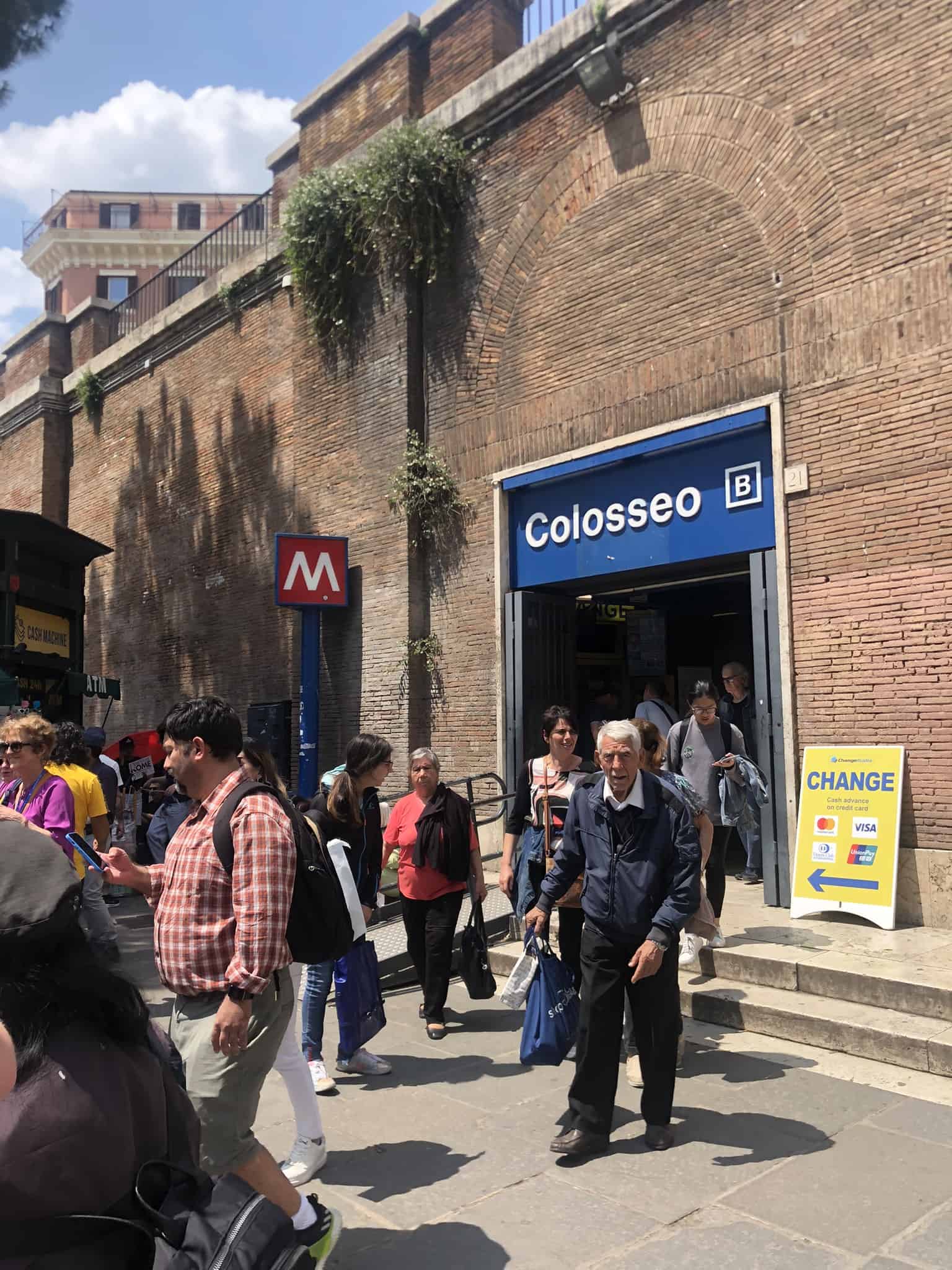
Neverending stream of people exiting the Metro statio
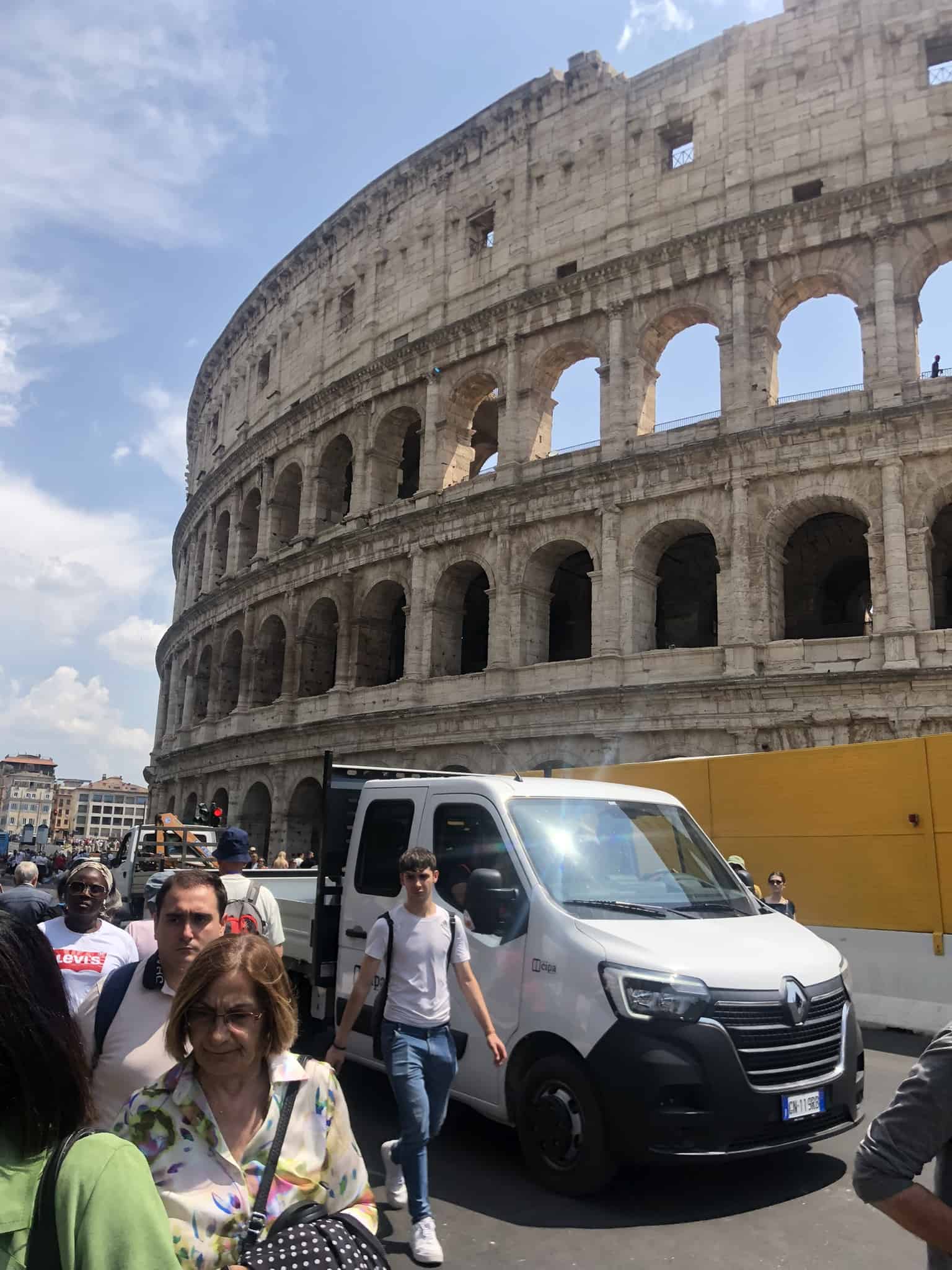
The Colosseum is directly opposite the Metro station.
The white and yellow panel obscures a construction site for a new Metro stop for the C Line.
It’s been a work in progress for over 20 years now, so something of a running joke among Romans.
- Top tip: Warning – there are two exits: lower level and upper level. After you come up the stairs and go through the ticket barriers, you’ll be on the lower level. Go straight out. You’ll be within sniffing distance of the Colosseum. You can’t go wrong. (Lots of guided tours have their meeting point at this exit of the Colosseum Metro.)
If, on the other hand, you walked or took a taxi , you’ll most likely be taken to the upper level exit (either by your phone’s GPS or the taxi driver).
Enter the Metro station and take the stairs down. You’ll arrive at the lower floor level of the station, opposite the Colosseum.
There are a lot of illegal ticket touts still operating in this area. Think of them like the sun. Make no direct eye contact. Ever. No need to be rude or get angry with them if they pester you. Just keep walking.
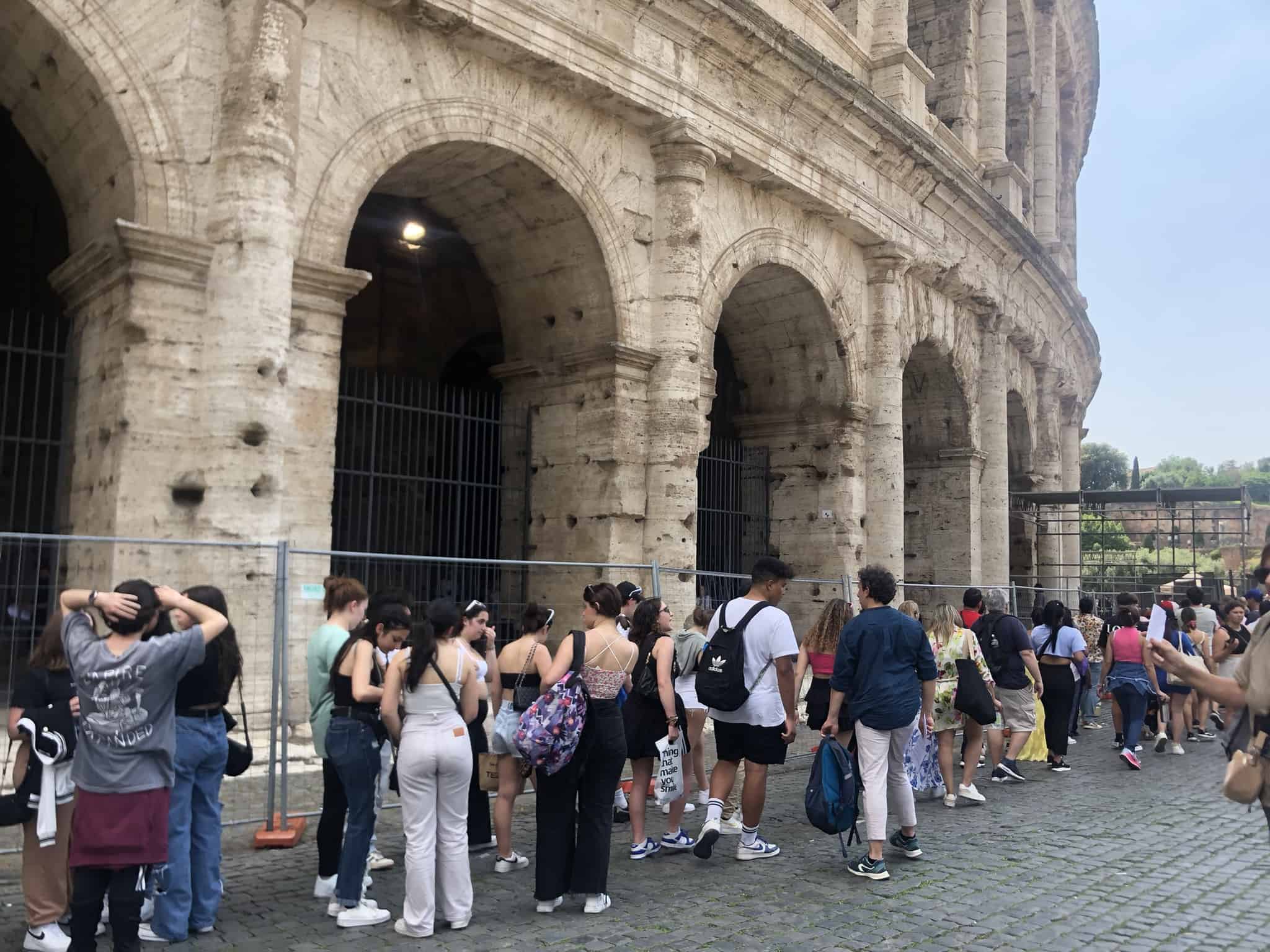
Group ticket holders’ line.
From the station, cross the road and as you pass the construction panel, you will probably see a very long line like this.
This line is for group ticket holders. They will be with their tour guide.
Follow the line for another 20 metres or so until you get to a sort of tree lined square, the other side of which will be another long line of people queuing up at the ticket office (see below).
Line for the ticket office opposite the Colosseum.
Cross over, walk past the ticket office and the line of people, and go straight until you come to Via Sacra and a sign indicating the way in that looks like this:
Entrance to Roman Forum on Via Sacra
- Top tip : Via Sacra is made up of huge shiny ancient cobblestones (much larger than the ones in central Rome known as San Pietrini). You’ll want to wear shoes with good grip.
Not sure how much of a flex this really is – there are literally hundreds of free potable water fountains in Rome. But it is the only water fountain at the Forum and with no cafes or restaurants, you will need it. You’ll find it just after the Arch of Titus.
- Top tip: Bring a refillable water bottle. There’s quite a lot of walking involved on Palatine Hill, and there are no restaurants. (Which is a shame because it would be very nice if there were).
Walk up the Via Sacra and you will be greeted by staff who will scan your ticket. You’ll go through a turnstile and then just like that, the epic Arch of Titus welcomes you in.
(I went in May 2023 which was ridden with days that started out with perfect blue sky and then ended with a thunderstorm. I liked it though; the sky, while ominous, just made everything a lot more dramatic.
- Top tip: Download the Parco Archeologico App . You can find it on the official Colosseum website or by scanning the QR code on the ticket information panels located next to the ticket office. It’s invaluable for helping you get your bearings around the deceptively large Roman Forums and Palatine Hill.
Above: Arch of Titus, and the start of most Roman Forum itineraries. Remember that scene in Ghostbusters 2 when dark clouds gather over the museum right before it gets covered in ghost slime?
What You Can Expect To See
basilica of maxentius and constantine – (313 c.e).
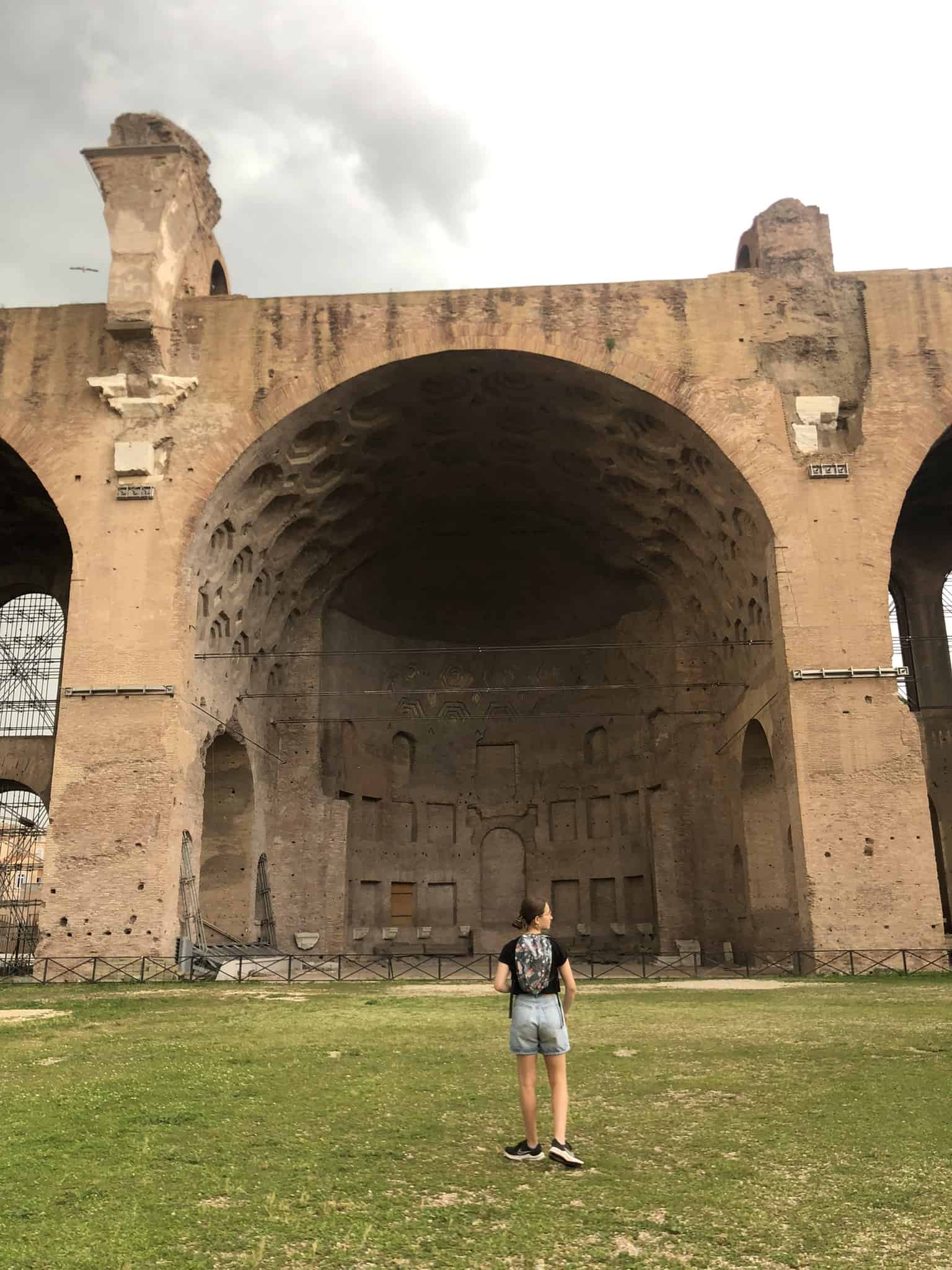
It’s really the scale that is the most impressive here.
The largest structure in the Forum, and of vast architectural importance; its design is said to have influenced the design of the St. Peter’s Basilica .
Artists’ renditions make it come alive, take a look before you go.
The Temple of Romulus – (300 C.E)
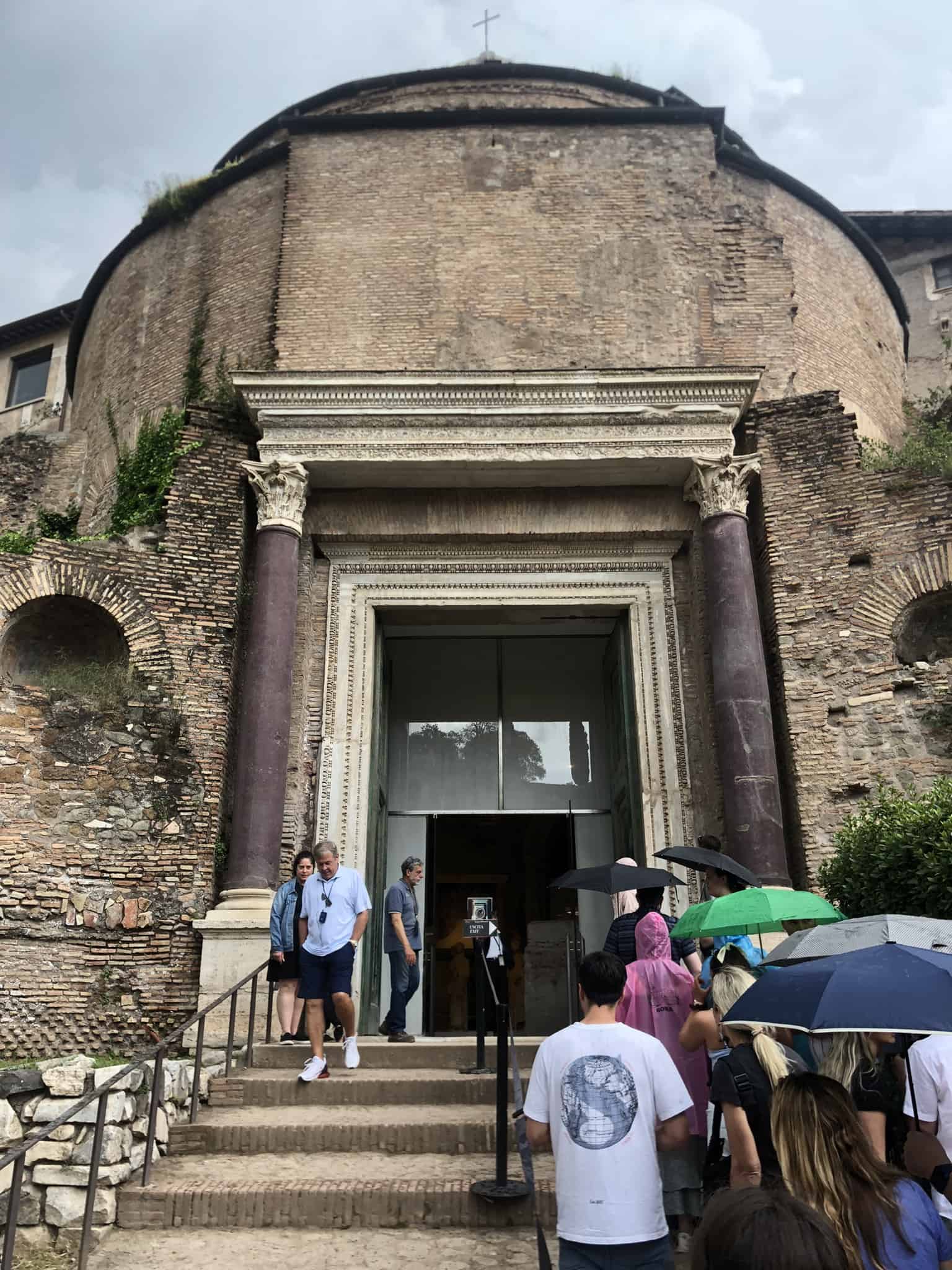
It’s unclear what the Temple of Divus Romulus was really used for other than an antechamber for the temple behind.
However, the bronze door, still used today, is 100% original. It was converted into a church in the 6th century.
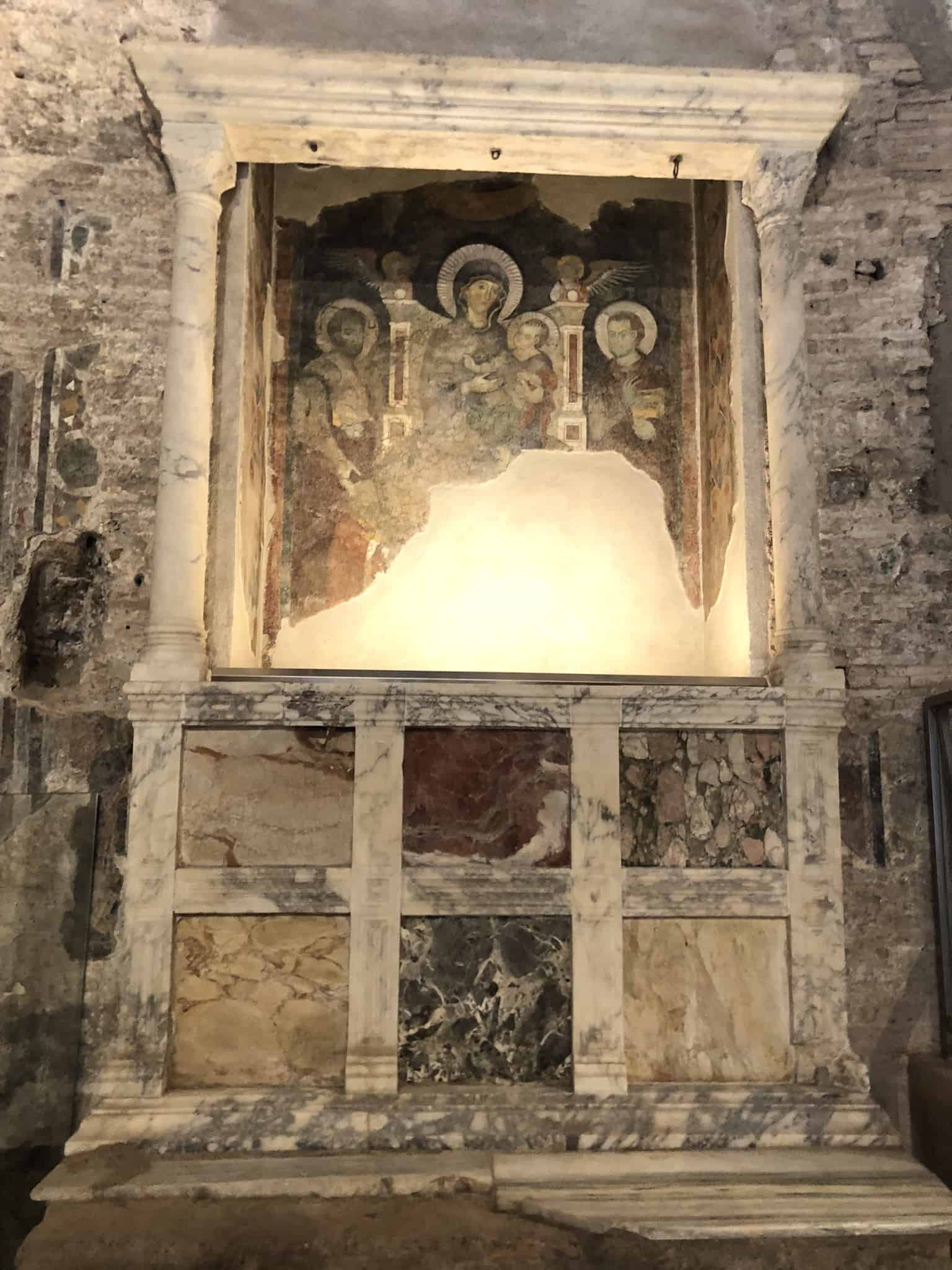
Detail of a fresco behind an altar from inside the Temple of Romulus.
The Temple of Antoninus and Faustina (141 C.E)
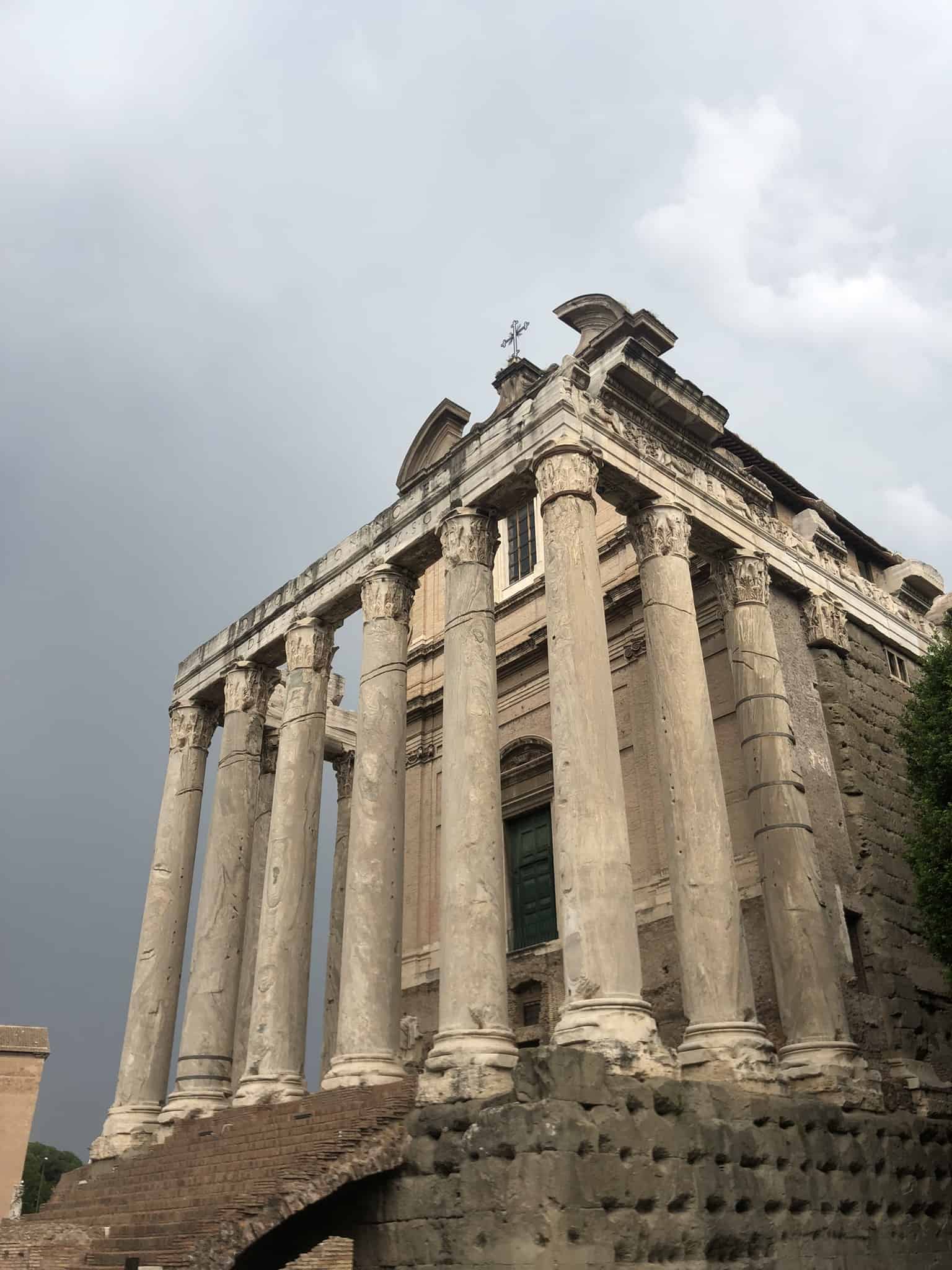
This one takes a second to figure out.
What’s that door doing up there?
19th-century excavations revealed the difference in street levels between Roman times and the 17th century. Contrast the threshold of the green door with the base of the steps leading up to the columns.
The Church, dedicated to San Lorenzo in Miranda is known as ‘the church in a temple’ for obvious reasons.
The Temple of Vesta
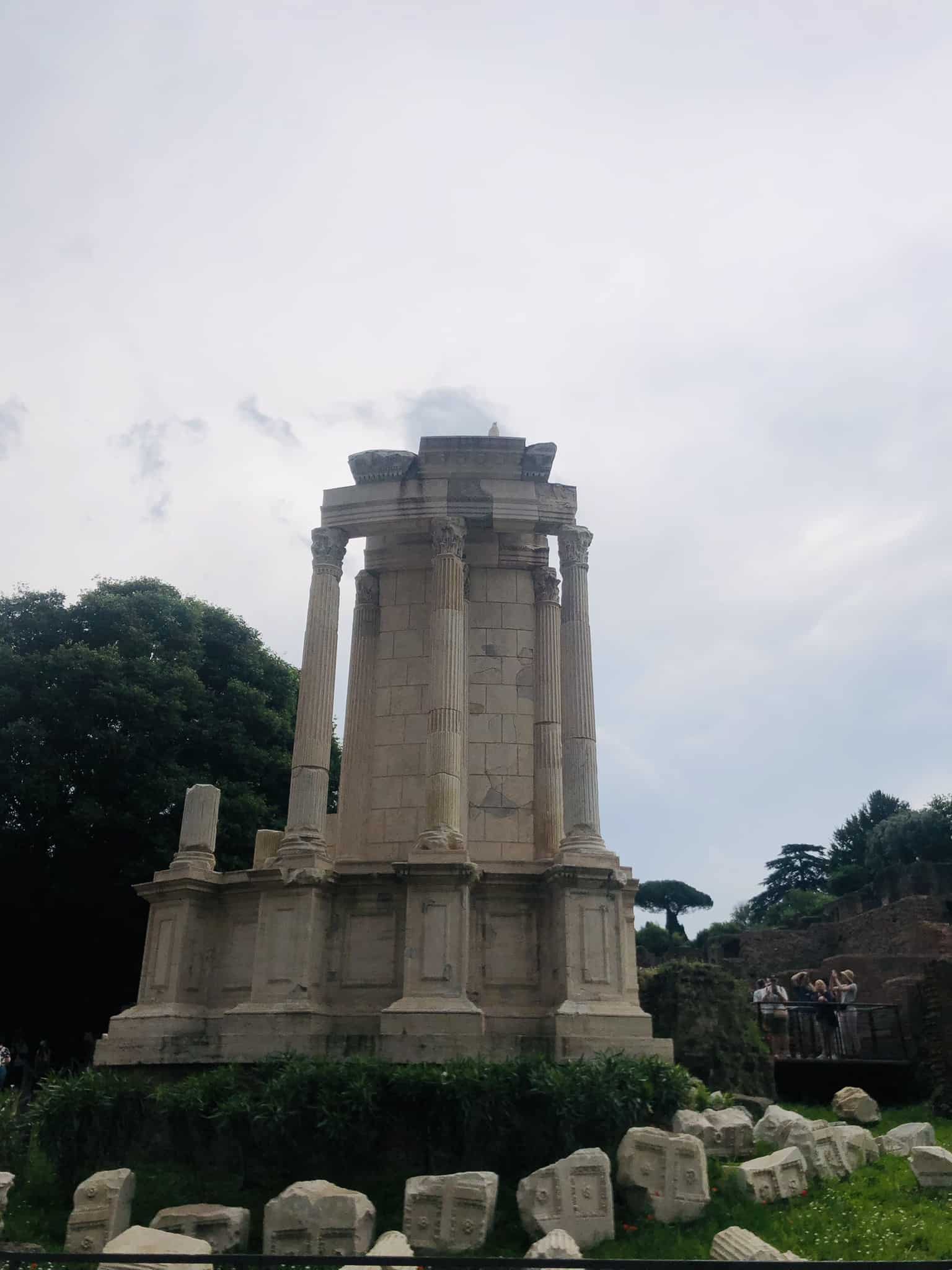
The oldest and most important shrine, it was home to the hearth which held the sacred fire of the state.
Religious activity on this site is estimated by historians to go as far back as 7th-century B.C.E.
Tempio dei Dioscuri
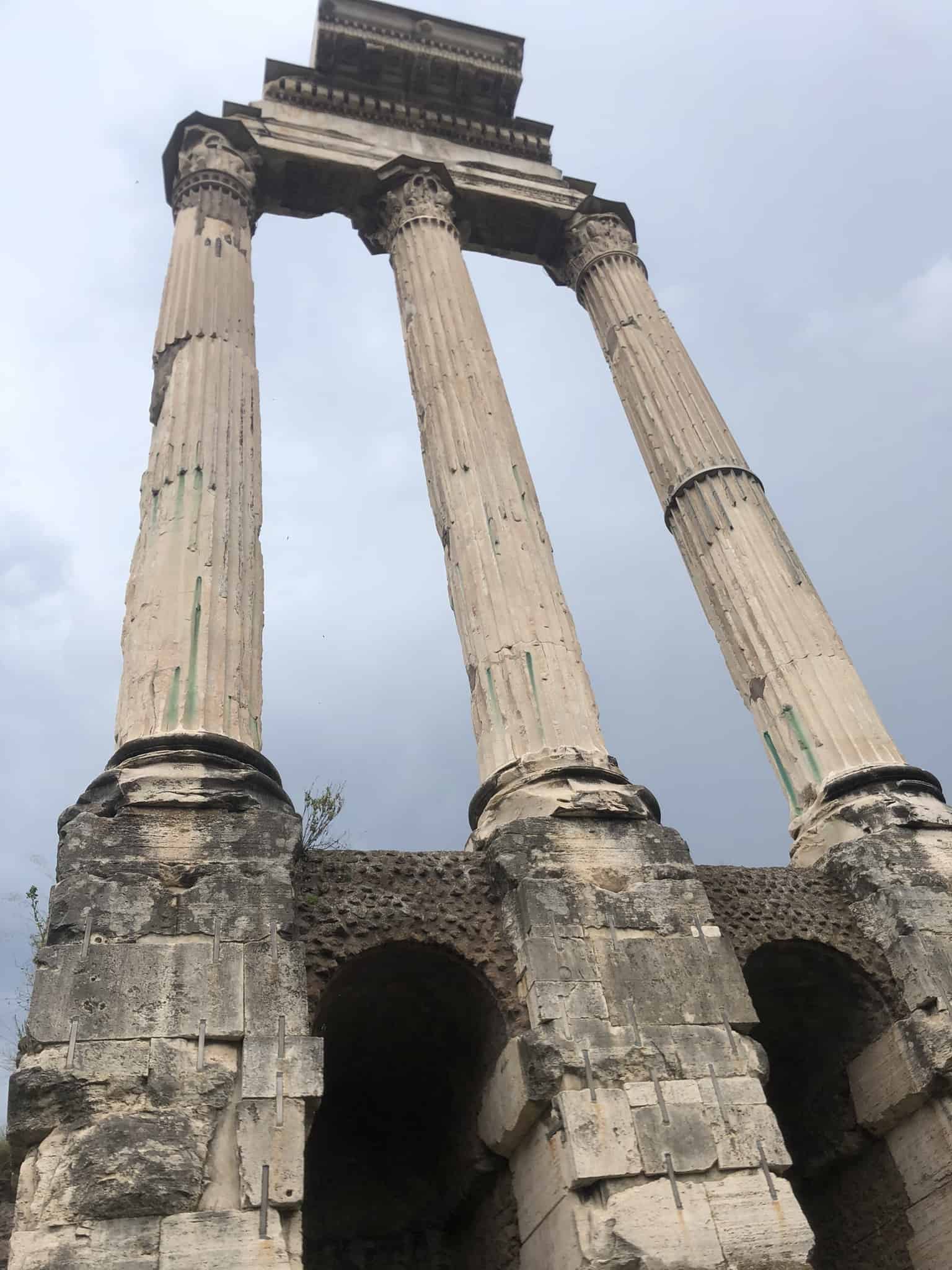
Temple of Castor and Pollux (Tempio dei Dioscuri).
Legend has it that the sons of Jupiter and Leda appeared on this spot to assist the soldiers of the Roman Republic overcome the last king of Rome.
Just these three columns remain, but they are iconic.
The Atrium Vestae
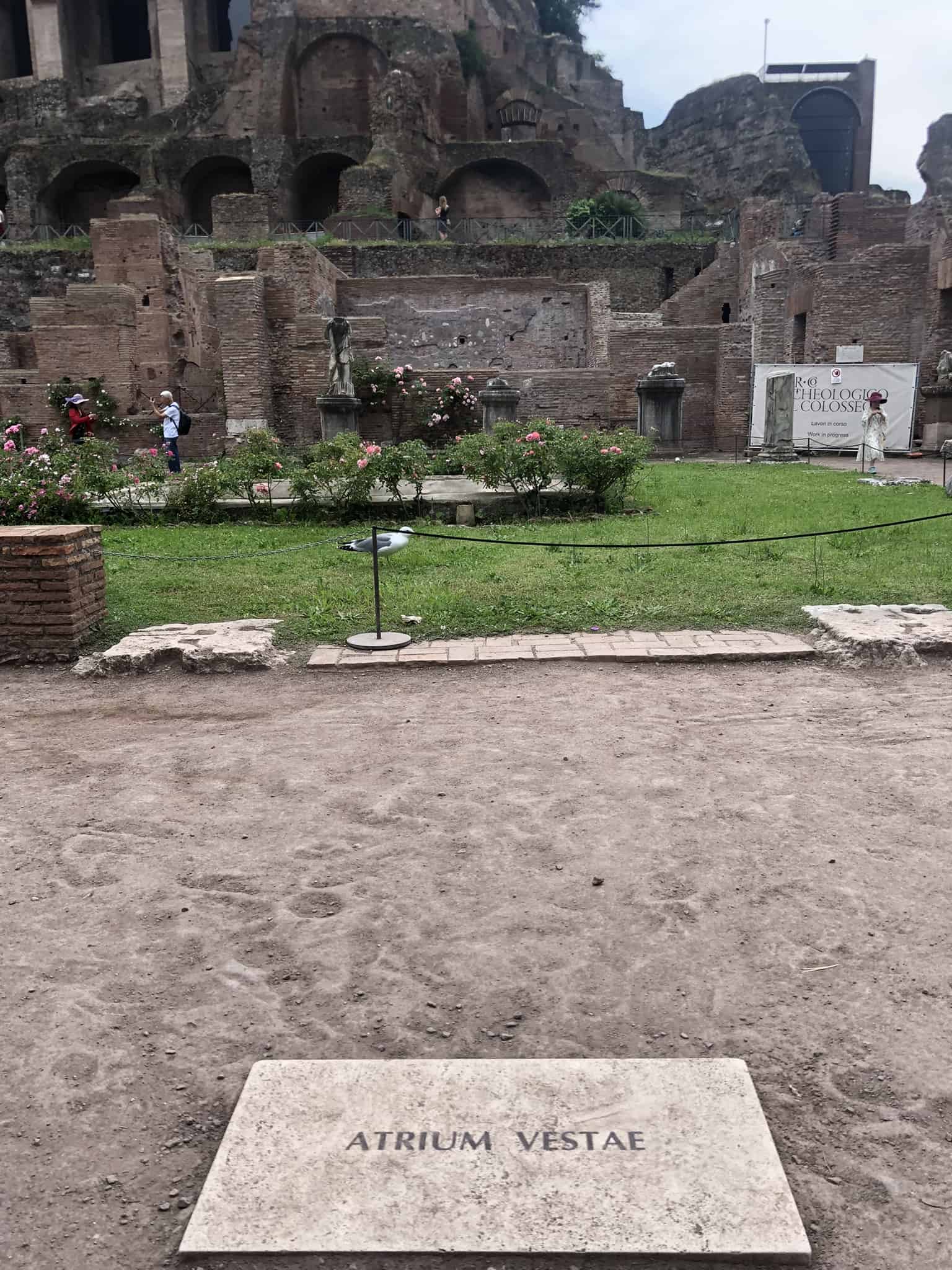
One of my favourite areas had to be the Atrium Vestae or the House of the Vestal Virgins.
(Vestal Virgins were women who would tend to the Temple of Vesta for a tenure of thirty years. As their title would suggest, they were virgins and were expected to remain celibate).
There are benches and it’s a great place to sit down, soak up the atmosphere, get your bearings, and prepare yourself for the Palatine Hill.
(See below for a super quick history lesson and why this is extra relevant).
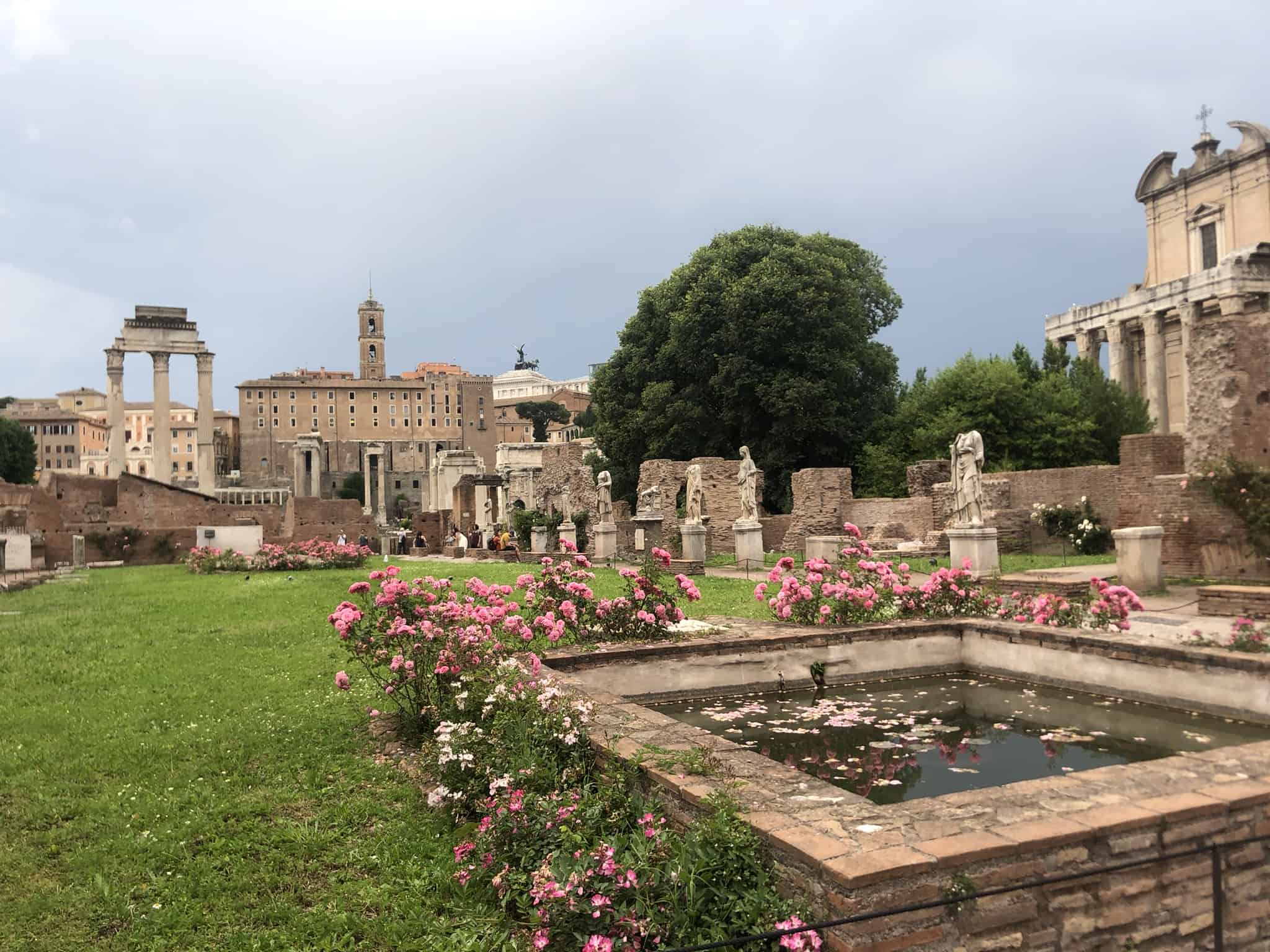
View of Tempio dei Dioscuri and Temple of Antoninus and Faustina from House of the Vestal Virgins, now a very serene rose garden.
Vestal Virgins
According to Roman mythology, a vestal virgin called Rhea Silvia was impregnated by the god Mars. She gave birth to twins and called them Romulus and Remus.
The King perceived the sons of Mars to be a direct threat and so ordered them to be killed. They were abandoned by the river but saved by the god Tiberinus, Father of the River.
As infants, they were suckled by a she-wolf (Lupa), and the cave ( the Lupercal ) in which she cared for them was believed to be up on Palatine Hill.
(If you ever wondered why the symbol of Rome was a wolf).
Years later, Romulus and Remus entered into a bitter dispute over where to build the city. Romulus favoured the Palatine Hill. Remus did not, so his brother had him killed. Romulus founded the city, called it Rome and the rest is history.
Palatine Hill Overview
The Palatine Hill has so many layers to it; both historically and mythologically.
It was home to the ruling classes of Rome for literally millennia. It’s dominated by the ruins of a network of imperial palaces from the first century called the Domus Augustana.
After a brief period of decline during the Middle Ages, things picked up again in the 16th century, when Palatine Hill became home to the first-ever botanical gardens in Europe thanks to the Farnese family.
Just a couple of pavilions and a fountain from what were once the most highly rated pleasure gardens in Europe.
The Palatine Museum at the top of the hill will help fill in the gaps showcasing the wealth and splendour of its previous inhabitants and their respective residences.
Cap it off with stunning views over the Circo Massimo from the Domus Augustana, before exiting via the Barberini Vineyard back down to Via di San Gregorio towards Circo Massimo.
Exploring the Palatine Hill
I started by exploring the vast imperial complex Domus Augustana. To add to the regal feel, classical music is played across the Domus area from discreetly placed speakers, which for me, went perfectly with the surroundings. It instilled a wonderful sense of calm:
The Nymphaeum of Mirrors
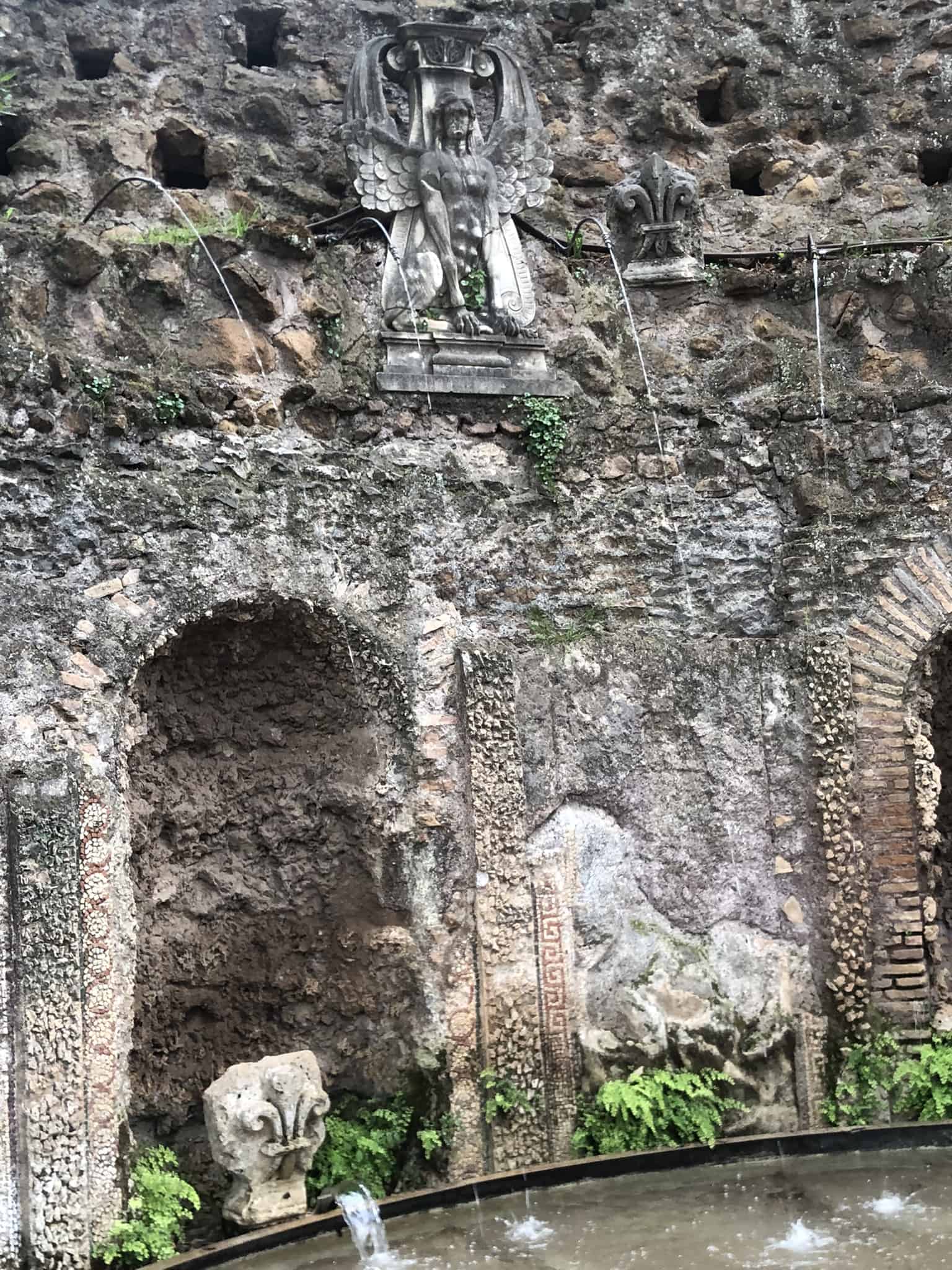
From here, I could still hear the classical music being played up the hill. I sat on a bench opposite the Nymphaeum of Mirrors – or what remains of these fantastic 16th-century water jets and fountains.
I still couldn’t quite get over how still and peaceful it was.
- Top tip : aim your visit towards the end of the day. Not only might you be lucky enough to enjoy romantic twilight views over the Circo Massimo from up on high, but it will be much quieter. Plus, you’ll wind everything up just in time for an aperitivo (between 6 pm and 7 pm), and I’ve got just the place in mind.
Making Your Way Out
Rather than going back the way you came and taking the Metro at Colosseo, exit here through Vigna Barberini. This lovely, almost rural walk downhill past random bits of Roman aqueduct will take you to the entrance/exit on Via di Gregorio, close to Circo Massimo.
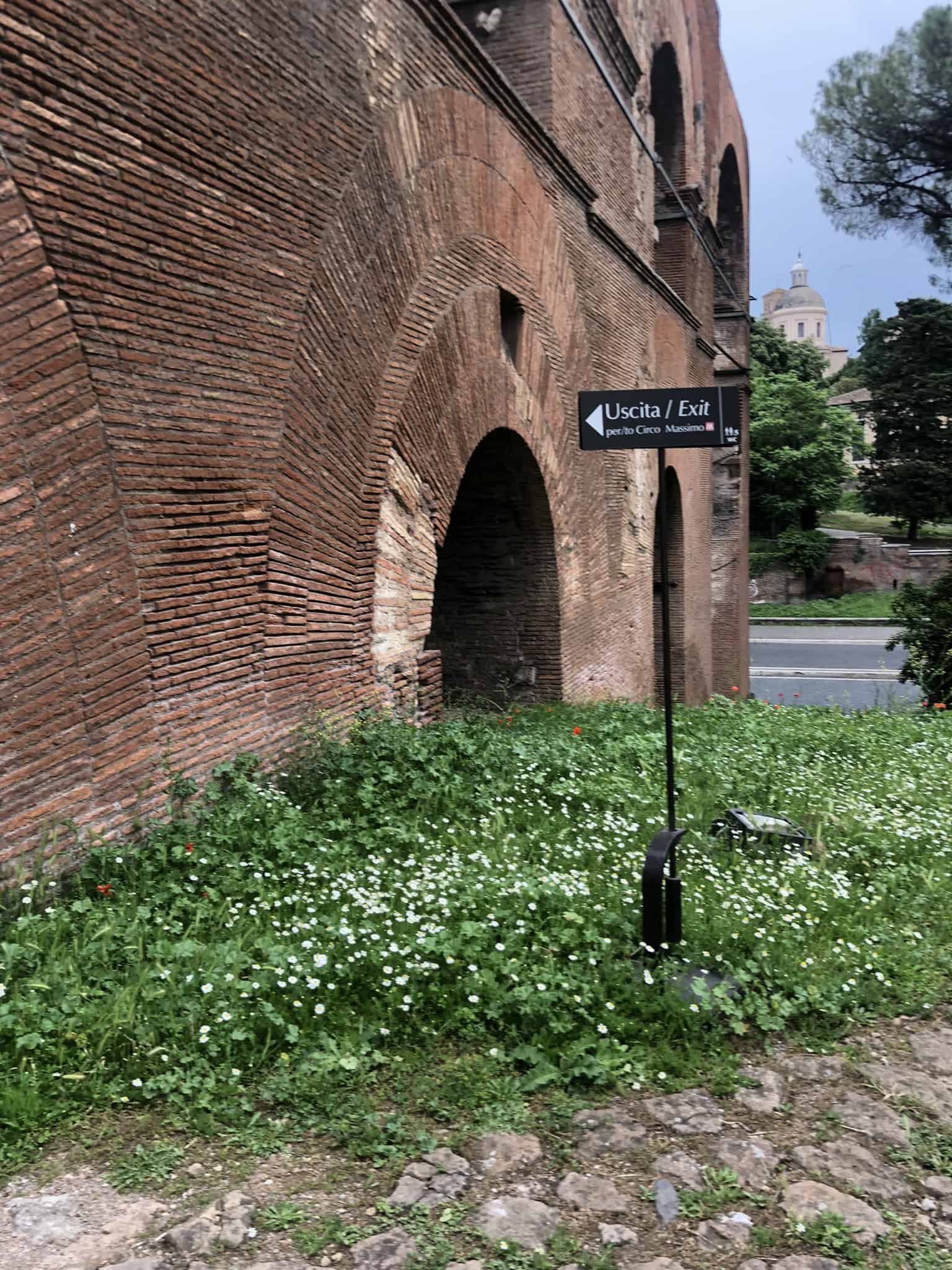
The Barberini Family Vineyard
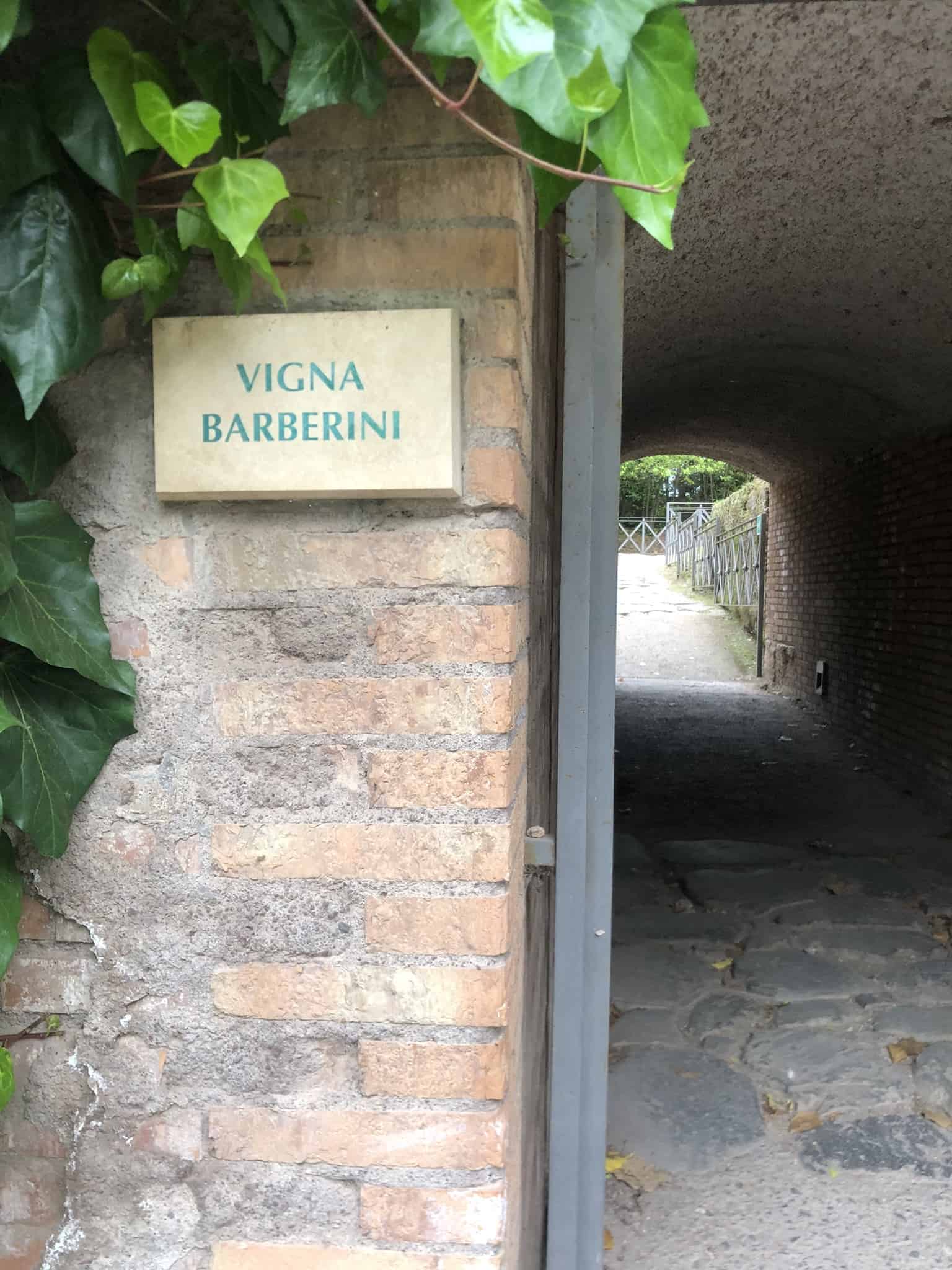
Now here’s a family that got around. This was a noble family from the 17th century that had their fingers in a lot of pies. (You’ll see their family crest at St Peter’s and they even have a Metro station named after them)
They owned property on this site in the 17th century, but the vineyard we see today was carefully planted in 2020 and viticulturalists are proud to be cultivating a very ancient vine called Bellone, known to have been used in Pliny the Elder’s time.
I visited towards the end of the afternoon and had the place to myself.
A very rural feel to the way out via the Vigna Barberini.
The path above will take you all the way down to Via di Gregorio and the splendid arch below.
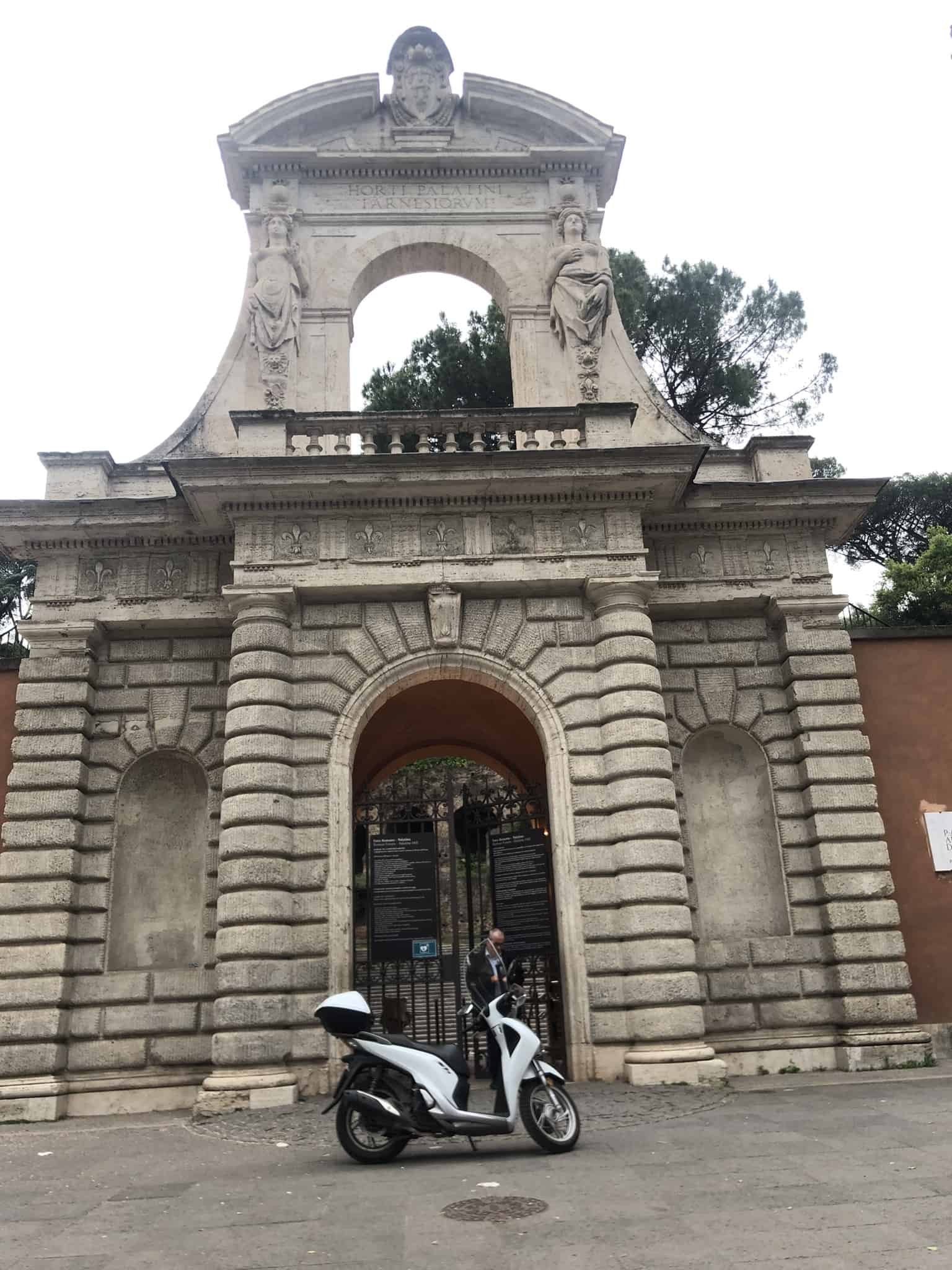
The entrance on Via San Gregorio, or the exit if you choose the Circo Massimo exit. The original entrance to the Farnese Gardens, when they were still a thing.
As you exit this splendid arch, the Arch of Constantine and the Colosseum will be on your left, and the Circo Massimo on your right hand side.
You could also choose to do the reverse and start your visit from here instead.
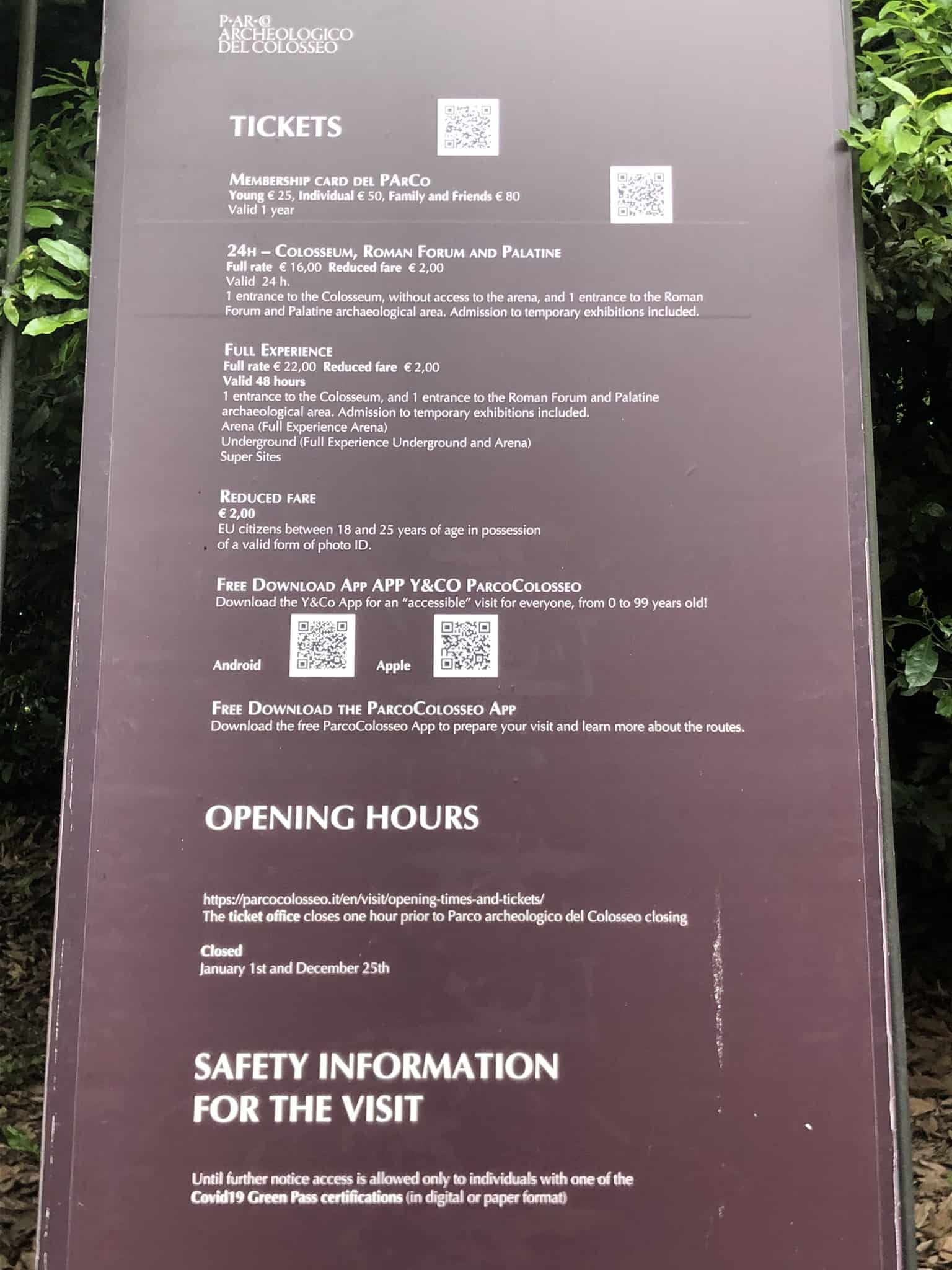
Italy has an absolute love affair with QR codes. They have them for everything.
This ticket information sign also has the QR code you need to download the Parco Colosseo App which includes a detailed itinerary for the Forum as well. Highly recommended.
You’ll find another sign like this by the ticket office opposite the Colosseum, next to Via Sacra.
Be aware that there are no gift shops, cafes, or restaurants at the Roman Forum or Palatine Hill. So bring snacks. The only official gift shops are located within the Colosseum.
Nearby Attractions
Circo maximo experience – viale aventino, 00186.
Through the use of Virtual Reality headsets, you’ll be transported back to the 1st century C.E and witness chariot races and a slice of Ancient Roman life at the Circo Massimo. A 40-minute walking tour; it’s a mere five-minute walk from the Arch of Constantine.
Panoramic view of the Circus Maximus as seen from the Palatine Hill.
Basilica San Clemente – Piazza di S. Clemente, 00184.
A five minute walk away is a stunning 12th century church.
Beneath lie archaeological excavations that take you on a voyage through time. You’ll go down to the remains of a 4th century church, and then descend once again to a 1st century pagan temple.
You’ll need to book ahead. The basilica itself doesn’t provide guided tours (local tour providers take care of that), and you will need to make sure you dress appropriately. No bare shoulders or short shorts.
Food and Drink
Bars and restaurants directly opposite the Colosseum are, not surprisingly, tourist traps. It had to be said. Instead, head to Viale Aventino; the long and cosmopolitan avenue (thanks to all the expat UN staff who frequent its bars) which connects Circo Massimo to Ostiense. It’s lined with a variety of bars and restaurants including:
So Good – Viale Aventino, 87, 00153.
Craft ale on tap and pastrami bagels. The bagels aren’t exactly NYC authentic, but portion sizes are good, and you get the option of pickles and mustard (not a given in Italy).
14 minute walk from the Arch of Constantine.
Gusto Massimo Bar – Via del Circo Massimo, 5a, 00153.
Aperitivo, pizza and good hot lunch food. A UN staff local, (working at the impressive UN Food and Agriculture building across the road), and five seconds from Circo Massimo Metro station.
8 minute walk from the Arch of Constantine.
Elleniko – Viale Aventino, 83, 00153.
Cheap Greek street food. If you want a break from Italian carbs, try Greek instead.
Elleniko offers authentic Greek street food at affordable prices.
Next door to So Good. 14 minute walk from the Arch of Constantine.
Did You Know That: 5 Interesting Facts
- At its lowest point, the Forum was used as a pasture for cattle. It was known as the ‘Cow Field’ during the Middle Ages.
- Much of the Forum was in good condition until the 16th century, though parts had been damaged by earthquakes and neglect. Pope Paul III ordered the plunder and repurposing of the Forum’s materials to build St. Peter’s Basilica, causing untold damage.
- The Arc de Triomphe in Paris was modeled on the Arch of Titus.
- After the brutal assassination of Julius Caesar, his body was cremated within the Roman Forum. Following his death, the legendary general and statesman was deified, and the Temple of Caesar was constructed on the site of his cremation. Much of the temple has been destroyed, but you can still see the remains of the altar today, which would have been treated as Caesar’s grave.
- As well as being a space for social gatherings, politics, and religious ceremonies, the Roman Forum was used as a place to conduct criminal trials. The heads of enemies were often displayed in the Empire’s twilight years.
A timeline of the Roman Forum’s place in Ancient Rome:
- 753 BC. Rome was founded by twin brothers Romulus and Remus. Buildings soon spring up to form the Forum, a communal area that Romans will use as a marketplace, religious center, and political stomping ground.
- 497 BC. The original Temple of Saturn was built. It will prove to be the first of many iterations.
- 44 BC. Julius Caesar was assassinated. His body is cremated in the Forum.
- AD 203. The Arch of Septimius Severus was built to commemorate the Emperor’s military victories against the Parthians.
- AD 394. Non-Christian worship is banned. The Roman Forum slowly fell into disuse.
- AD 410. Fall of the Roman Empire. The Western Roman Empire fell, and the Forum suffered heavy damage in the process.
- AD 608. The Column of Phocas is erected. It is considered to be the final ancient monument built in the Forum.
- AD 847. A huge earthquake damaged many of the buildings in the Roman Forum.
- AD 1539. Further damage was caused on the orders of Pope Paul III. Materials from the Forum are used to construct other sites, including St. Peter’s Basilica.
- AD 1803. Archaeologist Carlo Fea began excavation work at the Roman Forum. The full extent of the project would take over 100 years.
The Roman Forum was used as the center of Roman society. People met here publicly to discuss politics, pass laws, sell goods, and hold religious ceremonies.
The Roman Forum has suffered damage over the years through natural occurrences such as earthquakes, pollution, and weathering. Many of the stones and columns have also been stolen by thieves.
Address: Roman Forum, Via della Salara Vecchia 5/6, 00186 Roma, Italy · view larger map

- Things to do
- Tourist Attractions
Roman Forum
Located between Piazza Venezia and the Colosseum, the Roman Forum was the hub of political and social activity of the Roman citizens.
The Roman Forum was where religious and public life in ancient Rome took place . The Forum is, along with the Colosseum , the greatest sign of the splendor of the Roman Empire that can be seen today.
After the fall of the Empire, the Roman Forum was forgotten and little by little it was buried under the earth. Although in the 16th century, the existence and location of the Forum were already known, it was not until the 20th century that excavations were carried out.
Interestingly, the place where the Forum was built was originally a marshy area. In the 6th century B.C., the area was drained by means of the Cloaca Maxima , one of the first sewer systems in the world.
Points of interest
Besides the great number of temples that are in the forum (Saturn, Venus, Romulus, Vesta, etc.), it's worth paying special attention to the following points of interest:
- Via Sacra : This was the main street in ancient Rome that linked the Piazza del Campidoglio with the Colosseum.
- Arch of Titus : This is a triumphal arch that commemorates Rome's victory over Jerusalem. It was built after the death of the emperor Titus.
- Arch of Septimius Severus : An arch erected in the year 203 A.D. to commemorate the third anniversary of Septimius Severus as the emperor.
- Temple of Antoninus and Faustina : Built in the second century, the Temple of Antoninus and Faustina sets itself apart as the best-preserved temple in the Roman Forum.
- Basilica of Maxentius and Constantine : Though now mostly destroyed, its size suggests that this was one of the most important buildings of the Roman Forum.
- The Curia : In this building, the Senate met to make administrative decisions about the Roman government.
- Column of Phocas : Erected in the year 608 A.D. in honor of the emperor of Byzantium, this column, which is over 13 meters high, is one of the few that have remained standing since being built.
Visiting Rome without walking around the Forum is like going to Paris without seeing the Eiffel Tower. As you travel along the Via Sacra, close your eyes and imagine it as it was more than 20 centuries ago, when Julius Caesar walked there .
The best way to skip the line and get to know the Forum in detail is to take a guided tour . We'll visit three of the main monuments in the city, the Colosseum, Roman Forum, and Palatine Hill, skipping the line, and all with an expert guide.
If you prefer to discover it on your own, we recommend that you head first thing in the morning, as this is when people head to visit the Vatican . You can also skip the lines with the Rome Pass discount card.
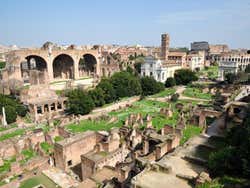
Between the Colosseum and Piazza del Campidoglio .
Every day: 8:30 am until 7 pm 25 December and 1 January: closed
Combined ticket to visit the Colosseum, the Roman Forum and the Palatine : Adults: € 16 ( US$ 17.40) European Union members (18 – 24): € 2 ( US$ 2.20) Children (ages less than 17) and seniors (over 65) members of the EU: free entrance
Colosseum, Roman Forum & Palatine Hill Tour € 62.64 ( US$ 68)
Metro : Colosseo , line B (blue).
Nearby places
Piazza del Campidoglio (335 m) Capitoline Museums (348 m) Arch of Constantine (407 m) Santa Maria in Aracoeli (412 m) Palatine Hill (424 m)
You may also be interested in
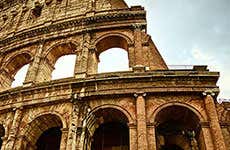
Known as the Flavian Amphitheatre, the Roman Colosseum is one of the capital's most remarkable monuments. Every year over 6 million people visit it.
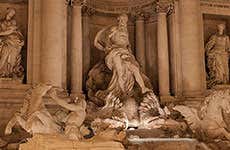
Trevi Fountain
Have you been told to throw a coin into the Fontana di Trevi? Learn the myth behind this tradition and learn about its history.
Privileged Entrance Colosseum Tour with Roman Forum & Palatine Hill
Skip the line at the colosseum, plus arch of titus, temple of julius caesar, and more.
Looking for the perfect way to see the Colosseum, Roman Forum, and Palatine Hill in just a few hours? With a super-knowledgeable local guide, you’ll breeze past the crowds to visit the most important sites in ancient Rome. Gaze in awe at the mighty Colosseum and hear stories of the gruesome battles that took place here, then admire the ruins where the true power of the Roman Empire once lay. It’s the ideal way to see the iconic highlights of ancient Rome!

- Meet your guide outside the Colosseum Metro Stop
- First level
- Second level
- Roman Forum
- Arch of Constantine
- Temple of Julius Caesar
- Palatine Hill
- Stadium of Domitian
- End your tour near the Colosseum
After meeting your expert Roman guide at the Colosseo metro stop, you'll skip the line to explore this ancient arena, including the first and second tiers where Rome's rich and famous would watch the bloody battles below. After your guided Colosseum tour your guide will help you avoid the lines at the Roman Forum and Palatine Hill, where they'll bring the ruins to life with stories of the powerful people that once controlled the Roman Empire from these sites.
Colosseum and Ancient Rome Tour Description
Your 3-hour walking tour includes:
Skip-the-line Colosseum tickets
Skip-the-line Roman Forum and Palatine Hill tickets
Guided tours of the Colosseum, Roman Forum, and Palatine Hill
An engaging, English-speaking local guide
A maximum group size of 25
Please note that depending on the assigned entry time for the Colosseum, your tour might enter the Roman Forum first and end in the Colosseum.
Skip-the-Line Colosseum Tour
Breeze past the crowds and access the special entrance for small group tours at the Colosseum. As you enter this ancient Roman structure, your passionate local guide will take you back in time with stories of the gruesome fights and epic spectacles that once happened here. You’ll explore the first and second tiers of the Colosseum—areas that were originally reserved only for Rome’s most elite classes.
Learn how the Colosseum was built and the history of the bloody battles that defined ancient Roman history. You’ll only spend an hour inside of the Colosseum, which is perfect for those who want to cover the most ground in less time.
This product includes an entry ticket to the Colosseum, Forum, and Palatine Hill, for which our cost is 18 Euro per person.
Guided Tour of Palatine Hill
Next, your guide will take you to the site where Romulus is said to have founded the city in 753 B.C. This area is comprised of opulent ancient palaces that are still characterized by their detailed artifacts and mosaics. These palaces weren’t just the homes of Rome’s most elite, they were enormous treasure troves with every possible luxury inside. In fact, the Palace of Domitian even had an amphitheater inside of it, large enough to host chariot races! Here, you'll also see a piece of an ancient Roman aqueduct.
Ancient Roman Forum
Finally, you'll visit what we like to call downtown ancient Rome. Ever watch a movie that takes place in ancient Rome, and you see people walking around a busy marketplace? That’s the Forum. This ancient site is where all of the action happened. From senate meetings to poetry performances and political protests, the Roman Forum really was the cultural hub of ancient Rome. Your guide will give you an insight into what life was like here, as you stroll around admiring historic structures including the Arch of Titus and the Temple of Julius Caesar.
" data-expanded-text="hide full description "> show full description
What you get with this tour

See what people are saying
550 total reviews
Our tour guide was excellent, so knowledgeable and so helpful in maneuvering through the crowds. Highly recommend this tour!
Great guide but be in physical shape
The tour guide was exceptional, very knowledgeable and funny. He transported us into ancient Roman times….but be warned this is physically strenuous.
show more reviews
Frequently Asked Questions
What to bring?
Government-issued ID for entrance to the Colosseum. Archaeological sites have uneven terrain so we recommend wearing comfortable sneakers. Bring sunscreen and a water bottle during the hot summer months.
What if I have concerns about my mobility on this tour?
If you have any doubts about your mobility, we suggest you take a more comfortable Private Colosseum Tour so we can better accommodate your needs.
Does this tour let me skip the line?
Yes! No waiting around for you. Your guide will lead you past the line so you can get straight into the Colosseum, Roman Forum and Palatine Hill.
Does this tour include access to the Colosseum Arena Floor?
This tour does not include the Colosseum Arena Floor, but you can walk onto it on our Special Access Colosseum Arena Floor Tour .
Will my tour time change?
Yes, the start time of your tour is likely to change. Please keep your day open. Your final start time will be sent 5 days before the date of your tour.
Can I cancel if my schedule changes?
No. Privileged Entrance Colosseum Tour with Roman Forum & Palatine Hill is a non-refundable tour.
You may also like

Skip the Line
Privileged Entrance Vatican Tour with Sistine Chapel
Skip the line and gain direct access to the Raphael Rooms, Creation of Man, and St. Peter's Basilica
( 1403 ) From: $95.43

Semi-Private Vatican Tour with Sistine Chapel
Enjoy a premium and exclusive tour of the Raphael Rooms, St.Peter's Basilica, and more!
( 1145 ) From: $134.98

Rome in a Day Tour with Colosseum and Vatican Museums
Explore the Sistine Chapel, St. Peter's Basilica, Roman Forum, Pantheon, Trevi Fountain, and more!
( 1602 ) From: $185.83

Exclusive Access
Special Access Colosseum Arena Floor Tour through the Gladiator's Gate
Walk in the footsteps of gladiators on the Colosseum floor and see the Roman Forum and Palatine Hill
( 1881 ) From: $83.57

Vatican at Closing Time with Sistine Chapel
Book a unique experience that visits the Vatican in the early evening with fewer crowds
( 180 ) as low as $94.12

St. Peter's Dome Climb and Sistine Chapel Combo Tour
Begin your day early and see Rome from above, the Papal Crypts below, and the Vatican museums nearby
( 467 ) From: $134.98

Rome Catacombs Tour and Capuchin Crypts with Transportation
Skip the line and explore a creepy underground world of Roman tombs and crypts with an expert guide
( 355 ) as low as $67.19
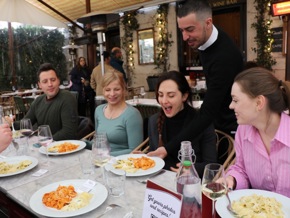
Guided Tour
Trastevere Local Food Tour in Rome
Join a culinary guide to savor authentic Roman food, such as tasty cheese, pasta, gelato, and wine
( 514 ) From: $105.04

Unforgettable Rome Day Trip to Pompeii and Sorrento
The easiest way to dive deep into the famous ancient ruins and soak up the sunny coast of Sorrento
( 222 ) From: $192.05

Climb the Dome
Ultimate St. Peter's Basilica Dome Climb and Tour with Papal Crypts
See St. Peter’s Basilica up close and climb the dome for the best views of Rome and the Vatican
( 95 ) From: $50.80

3-Hour Scenic Golf Cart Tour of Rome in a Small Group
Experience the Eternal City in complete comfort with stops at 8 iconic UNESCO World Heritage sites
( 34 ) From: $169.50

After Hours Rome Catacombs Tour with Capuchin Crypts
Experience Rome’s creepy underground tombs and eerie bone displays on this exclusive night tour
( 39 ) as low as $85.91

Entry Ticket
Vatican Museums & Sistine Chapel Tickets
Skip the line and gain quicker access to the Vatican so you can explore at your leisure
( 60 ) From: $44.58

Rome Sightseeing Tour by Golf Cart
Whiz through Rome to see the Colosseum, Vatican, Roman Forum, Oppian Hill, Tiber Island, and more!
( 32 ) From: $361.60

Private Tour
Private Vatican, Sistine Chapel and Saint Peter's Dome Climb Complete Tour
Climb St. Peter's Dome then tour the Vatican Museums and Sistine Chapel
( 51 ) From: $553.70

Private Colosseum Tour with Roman Forum, and Palatine Hill
See the Colosseum and ancient Rome like a VIP, the Temple of Caesar, and more!
( 202 ) From: $507.37

Tivoli Fountains & Hadrian's Villa Private Tour from Rome
Escape the city on a VIP private day trip to Tivoli, with Villa d’Este, Hadrian’s Estate, and more!
( 6 ) From: $1,582.00

Private Skip the Line Vatican, Sistine Chapel, and St Peter's Basilica Tour
Enjoy a tailored VIP Vatican experience with a dedicated private guide
( 137 ) From: $456.52

Vatican Museums, Sistine Chapel and St. Peter's Basilica Private Tour
See the wonders of the Vatican on a tailored private tour with expert guide and skip-the-line entry
( 143 ) From: $445.22

Golf Cart Appian Way Tour
Rome’s Catacombs and Appian Way Golf Cart Small Group Tour
Escape the crowds and journey through ancient roads and underground tombs alongside an expert guide
( 8 ) From: $107.35

Full Day Pompeii and Mt. Vesuvius Tour from Rome
Skip-the-line at Pompeii, savor a three-course meal, and walk amid Mt. Vesuvius’ volcanic formations
( 20 ) as low as $157.29

Private Rome in a Day Tour with Colosseum & Vatican Museums
See the best of Rome your way with a private guide at the Sistine Chapel, Trevi Fountain, and more!
( 57 ) From: $1,127.74

Amalfi Coast from Rome
Positano and Amalfi Day Trip from Rome with Boat Cruise
Navigate along the Coast, explore the picturesque town of Positano, and enjoy a classic limoncello
( 3 ) From: $179.67

Semi-Private Colosseum Tour with Roman Forum & Palatine Hill
Immerse in Roman history as you visit Arch of Titus, Temple of Caesar and more with an expert guide
From: $101.70

Colosseum Underground Tour with Roman Forum and Palatine Hill
Get special access to the Underground dungeons and Arena Floor on this guided small group tour
( 974 ) From: $180.18

Rome Evening Tour by Tuk Tuk
Journey from the Colosseum to the Pantheon and Trevi Fountain with a private driver-guide
( 5 ) From: $254.25

Private Family-Friendly Rome Colosseum & Roman Forum Tour
Bring the Colosseum to life on this interactive kids tour with a treasure hunt and fun local guide
( 23 ) From: $562.74

Tuscany Day Trip from Rome with Vineyard Lunch and Wine Tasting
Wander through the medieval towns of Montepulciano and Pienza and enjoy a 3-course meal!
( 7 ) From: $157.07

Half Day Electric Bike Tour of Rome
Pedal past the Colosseum, Piazza Navona, and up Capitoline Hill in the peaceful morning
( 107 ) From: $73.45

Tasty Pasta and Tiramisu Cooking Class Near Piazza Navona
Cook like a pro with a local chef as you master two Italian dishes then savor your own creations
( 24 ) From: $89.27

Vatican at Closing Time Private Evening Tour with Sistine Chapel
Appreciate the Vatican masterpieces without less crowds on our tour with a private guide
( 24 ) From: $403.41

Trastevere: a Taste of Roman Tradition
Trastevere Food Tour and Pasta Making Class
Sample classic Roman delicacies and learn how to make fettuccine from scratch!
From: $166.11

Authentic Pizza and Gelato Cooking Class in Rome
Embark on an Italian culinary adventure in a 17th-century palace near Piazza Navona!
From: $117.52

Skip-the-Line Pantheon Express Guided Tour in Rome
In one hour, discover the storied dome, Oculus, and tombs of Rome’s ancient temple with your guide!
( 10 ) From: $49.72

Rome Vintage Fiat 500 Sightseeing Tour
Cruise around in style as you explore the Eternal City’s top landmarks, sights, and attractions!
( 6 ) From: $341.26

Private Borghese Gallery Tour
Admire stunning Baroque art most miss like Bernini's Rape of Proserpina & Apollo and Daphne
( 26 ) From: $428.22

Rome’s Appian Way Tour by E-Bike
Pedal through Parco dell’Appia Antica alongside an expert guide and admire ancient Roman marvels
( 7 ) From: $73.45

The Quickest Direct Access Private Vatican Tour
Explore the Vatican on a shorter, tailored tour that includes the Sistine Chapel
( 27 ) From: $449.74

Rome Golf Cart Food Tour: Explore the City's Iconic Sites and Cuisine
Journey Through Time and Taste on a Small-Group Adventure
( 12 ) From: $245.21

Private Tour of Rome’s Seven Hills by Tuk Tuk
Cruise to the Orange Gardens, and admire the view from Circus Maximum from a real tuk tuk.
( 1 ) From: $169.50

Prati Eats: A Delicious Walking Tour
Indulge in Rome's famous pizza, pasta, and wine alongside a knowledgeable foodie guide
( 11 ) From: $152.55

Castel Sant'Angelo Guided Tour
Castel Sant’ Angelo Skip the Line Small Group Tour in Rome
Visit Hadrian’s Tomb, learn about the legend of Archangel Michael, and view stunning frescoes!
From: $72.32

Testaccio Food Crawl
Testaccio Small Group Food Tour
Sip an espresso, indulge in authentic Italian pasta and wine, and explore a local Roman Market
( 4 ) From: $129.95

Trastevere and Jewish Ghetto Private Rome Tour
With a private guide, unearth the trendiest Rome districts from Santa Maria Basilica to Tiber Island
( 18 ) From: $197.75

Cooking Class
Dough to Dessert: 3-in-1 Cooking Class near Piazza Navona
Master the art of making fettuccine, ravioli, and mouthwatering tiramisu in a single day!
( 44 ) From: $100.57

Ultimate Pizza & Tiramisu Making Class Near Piazza Navona
Learn the secrets of making authentic tiramisu and pizza from a pizzaiolo chef before devouring them
( 5 ) From: $89.27

Four-Course Roman Dinner with Wine Pairing Near the Pantheon
Taste exquisite Italian food with sommelier-style pairings in a stunning 15th-century building
( 5 ) From: $146.90

Borghese Gallery Skip the Line
Skip-the-Line Borghese Gallery Small Group Tour in Rome
Embark on a small group guided experience , and discover works by Bernini, Caravaggio and Canova
( 3 ) From: $107.35


Trastevere Pasta Making Class: Fettuccine and Maltagliati
Head to Rome’s trendiest food district to try your hand at authentic pasta making (and eating!)
( 6 ) From: $67.80

Vatican Uncovered: A Private, Detailed Tour
Get an in-depth experience tailored to your interests of art, sculptures, and the Sistine Chapel
( 35 ) From: $700.55

Private Half Day E-Bike Tour of Rome
Cycle through the Roman streets with ease to see the Colosseum, Pantheon, Trevi Fountain, and more!
( 37 ) From: $444.09

Private Family-Friendly Vatican and Sistine Chapel Tour
Enjoy a boredom-free Vatican private tour that's perfect for kids, with treasure hunt and fun guide
( 22 ) From: $505.11

Rome Evening Cocktail Tour with Local Guide
Experience Rome’s cocktail culture as you stroll by the Pantheon, Piazza Navona, and Trastevere!
( 46 ) From: $506.24

Catacombs Private Tour in Rome
Discover the mysterious Roman Catacombs, Capuchin Crypts, and Appian Way on an intimate private tour
( 20 ) From: $788.74

Private Pompeii & Mt. Vesuvius Day Trip from Rome
An unforgettable visit to ancient ruins with all the details and transportation taken care of
( 16 ) From: $2,141.30

Alone at the Vatican: Private After Hours Tour
Experience the quiet of the Sistine Chapel without the crowds after your tailored tour
( 9 ) From: $5,695.20

Basilicas of Rome Private Driving Tour
Uncover relics of Catholic history and three of Rome’s major churches with an expert local guide
( 14 ) From: $675.74

Orvieto, Civita di Bagnoregio & Winery Private Day Trip from Rome
Escape the city on a memorable journey through Umbria’s historic towns to taste fine local wines
( 6 ) From: $1,558.27

Private Pompeii & Sorrento Day Trip from Rome
Step back in time with a private guided tour of Pompeii then enjoy a lazy afternoon in Sorrento
( 11 ) From: $1,807.95

Private Rome City Driving Tour
See the best of Rome with the comfort of your own private vehicle and a dedicated local tour guide
( 32 ) From: $703.99

Transportation Included
Rome Shore Excursion from Civitavecchia
Book a private Rome tour and see the Colosseum, Vatican, Sistine Chapel, and more in just one day!
( 27 ) From: $2,033.95

Private Transfer from Rome to Amalfi Coast with Tour of Pompeii
Travel south in style with door-to-door service, and explore Italy’s lost city with a private guide
( 7 ) From: $1,864.50

Brunello di Montalcino Helicopter Tour from Rome or Florence
Take to the skies on the ultimate VIP Tuscany tour that includes wine tasting and a gourmet lunch
( 7 ) From: $11,187.00

Meet your guide at Piazza Barberini
Golf Cart Tour of Rome with Pizza and Gelato Dinner
Indulge in authentic Italian pizza, savor gelato, and whizz between Pantheon, Trastevere and more
From: $235.04

2-Hour Tour by Segway
Segway Tour of Imperial Rome
Admire the Colosseum, Circus Maximus and more, during a guided 2-hour journey in a Small Group
From: $66.67

Rome by Vespa Small Group Driving Tour
Join an intimate Vespa convoy and scoot past the Pantheon, Spanish Steps and Piazza Navona
From: $163.85

Piazza Navona Underground Ruins Tour with Palazzo Altemps
Admire the stunning Suicidal Gaul, Athlete at Rest, and more then see the ruins of Domitian' Stadium
( 1 ) From: $281.37

Best Squares of Rome by Segway
Segway Tour of Baroque Rome in a Small Group
Zip to the Pantheon, Piazza Venezia, theTrevi Fountain, and more of ancient Rome’s treasures!

Semi-Private Colosseum Tour with Arena Floor
Stand where gladiators fought on the Colosseum floor, then explore the Roman Forum and Palatine Hill
( 26 ) From: $101.65

Guided Buggy Self-Drive Tour of Rome
Cruise to the Eternal City’s most iconic landmarks, historic monuments, and breathtaking viewpoints!
From: $268.94

Caravaggio's Masterpieces
Private Palazzo Barberini Museum Tour with Art Historian Guide
See Judith Beheading Holofrenes, La Fornarina, and more inside this opulent 17th-century palace
( 1 ) From: $449.74

Traditional Roman Cooking Class in Jewish Ghetto
Learn how to make pasta, seasonal vegetables, and a traditional dessert in a charming neighborhood
( 3 ) From: $103.96
Top tours customers bought with this tour:

Thank you for letting us know how your experience was!
Tell us about your experience.
If you need to book more than 7 guests on this tour, contact us at [email protected] A travel Expert will get back to you to arrange all the details.
Europe is re-opening for visitors!
Want to see which small group tours are now operating ?
More tours added weekly!
See Open Tours

- Italy Travel Blog
- In The Press
- Help Center
- Top Attractions
Policy & Terms
- Cancellation Policy
- Terms & Conditions
- Privacy Policy
- USA or Canada: +1 888 290 5595
- Email: [email protected]

© 2024 - The Roman Guy All rights reserved.

Guide To The Monuments Of The Roman Forum
Visiting the Roman Forum is a highlight for anyone traveling to Rome.
The 2,000 year old site, now a sprawling expanse of romantic ruins, was once the beating heart of the Roman Empire. Walking through it, you’re treading the same ground where ancient Rome’s most important events unfolded.
Exploring the Roman Forum can seem overwhelming at first, but don’t worry! With this guide to the Roman Forum, you’ll easily recognize and understand the significance of each monument.
What is the Roman Forum?
The forum is a rectangular valley running from Arch of Titus to the Arch of Septimus Severus near Capitoline Hill.
The forum’s main road is the Via Sacre. It’s basically the Broadway of Ancient Rome. Much of the paving of the Via Sacre is original to Ancient Rome.
The forum was dense with construction. It was the epicenter of ancient Rome, the seat of power, and its central showpiece.
It was a grandiose district consisting of gleaming white temples, grand basilicas, and vibrant public spaces — fit for an empire that ruled half of the known world.
The Forum was the scene of political upheavals, funerals, and triumphant parades. Before the Colosseum was built, it even hosted gladiatorial battles.
By the close of the imperial period, the forum was a densely stuffed with “modern” ancient buildings. Layers of churches and fortresses were built atop and amid the ancient remains.
After the 4th century, the Forum fell into disrepair and almost total obscurity. It became a quarry for building stone.
In the 18th century, the forum ignominiously lapsed into a cow pasture covered in layers of dirt and rubble.
Only in the 18th and 19th century did excavation begin, uncovering the buried treasure. Excavations continue today.
Tickets & Tours
The Roman Forum is one of Rome’s three important imperial sites, along with the Colosseum and Palatine Hill . These sites are typically visited with one trifecta ticket or ticket + tour.
Tickets are issued on the website exactly 30 days in advance. They are a hot commodity. Click here to book skip the line tickets for all three sites.
Booking a guided tour can really enhance your visit to the Roman Forum, especially since it’s such a vast and complex site.
Unless you’re a repeat visitor, without a guide, it can be tough to fully appreciate everything there is to see.
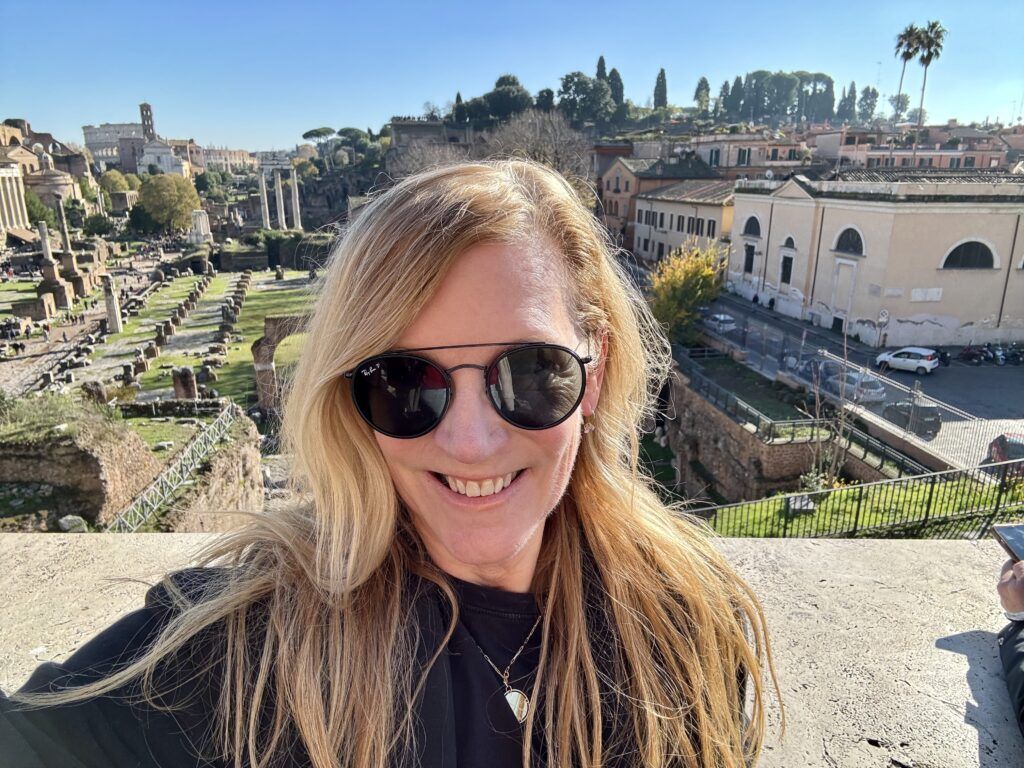
There are several tour options available, each with different durations and focuses. Choose one that aligns best with your interests and schedule.
I’ve personally taken the third and sixth tours on the list. They really helped bring the history of the place to life!
- skip the li ne entr y tickets to all 3 sites
- 3 hour gu ided tour and en try t o all 3 sites
- tickets & tour of all 3 sites + underground Colosseum access
- C oloss eum tour with e ntry tickets for Palatine Hill and the Roman Forum
- 4 ho ur priv ate d ay tour of Ancient Rome
- skip the lin e private guided tour with an art historian
Guide To The Roman Forum: What To See
1. arch of constantine.
If you’re a Christian, this arch is a symbol of your religion.
Constantine’s Arch represents a landmark in history, when a military battle made Christianity the mainstream religion in Rome and the entire Western World.
In 312, Emperor Constantine defeated his enemy and co-emperor Maxentius in the Battle of the Milvian Bridge, a turning point in their dispute. Legend holds that, the night before, Constantine dreamt of a cross in the sky.
When Constantine was victorious the following day, Maxentius fell off the bridge and drown. Constantine became sole emperor.
Straight away, he ratified the Edict of Milan, a religious tolerance act. It was the beginning of Christianity as the official state religion. One wonders what world history would be like if Constantine lost the battle …
Newly restored, the Arch of Constantine tells the story of his great victory. The arch is made entirely of carvings and decoration from other buildings with military imagery. An inscription on the top level announces that Constantine was the builder.
In the round reliefs, you see Emperor Hadrian. In the square reliefs you see Marcus Aurelius. The arch is topped with statues of Augustus and Trajan. In this manner, Constantine conflates himself with past great emperors.
READ : History of the Roman Emperors
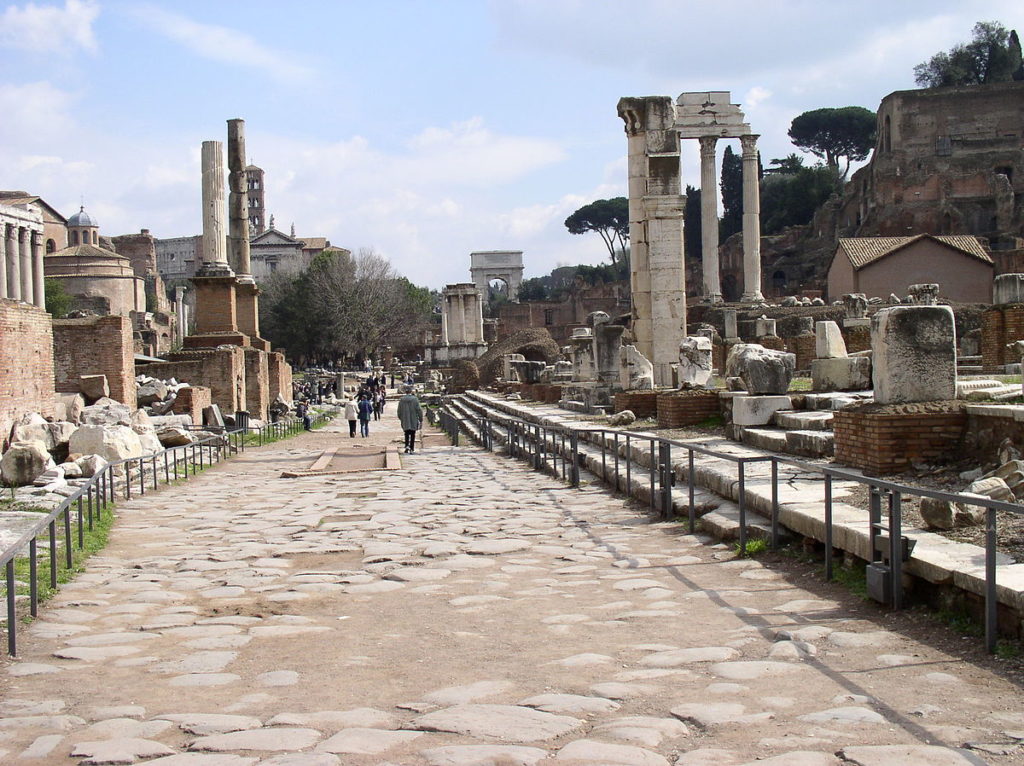
2. Via Sacra
The Via Sacra is the main street of the Roman Forum and it connects many of its monuments.
It’s a historic path where the story of Rome unfolded. This road was the center of Roman life, frequented by famous historical figures like Caesar, Cicero, Pompey, and Augustus. It was also the route Roman generals took to celebrate their victories.
Today, the Via Sacra might not look as grand as it once did. Many of its original paving stones are missing or uneven.
But as you walk down this road, remember that you’re following in the footsteps of some of Rome’s most influential people.
3. Temple of Venus and Rome
The Temple of Venus and Rome was another massive temple in the Roman Forum. Over 100 feet tall, it was once one of ancient Rome’s most impressive monuments.
The temple was designed by Emperor Hadrian. As was his preference, the temple is Greek in design. It was once surrounded by white columns, which now mark the perimeter.
The Temple of Venus and Rome is really just a shell now. The main ruin is an apse in the center.
It’s a brick arch with a cross hatched ceiling. The ceiling was installed by Maxentius in 307.
The temple once consisted of two main chambers, each preceded by a vestibule. Inside were two colossal statues of Venus and the goddess Rome Aeterna. Their Latin names, Roma and Amor, are inscribed on the walls, equating the city of Rome and the concept of love.
4. Arch of Titus
The Arch of Titus, one of three triumphal arches in the Roman Forum, stands as a monumental reminder of Rome’s military victory over Judea.
Built in honor of Emperor Titus by his brother Domitian, this structure is a mix of triumph and tragedy.
The inscription on the arch, “the Senate, the People of Rome,” harks back to the era of the Roman Republic, which ended with Augustus becoming emperor.
The arch is known for its darker narrative: it symbolizes the defeat and displacement of the Jewish people following the Fall of Jerusalem.
Titus’ siege led to the city’s destruction, the enslavement of thousands, and the desecration of the sacred temple, of which only the Wailing Wall remains today.
Inside, the arch features imagery of Roman soldiers carrying a menorah from the temple, symbolizing the exile of the Jewish population, a historical event whose repercussions are still felt today.
The arch once displayed colorful statues and showed the emperor in a victory parade.
The red color on the emperor’s face represented his vanquished enemies. The central panel in the arch depicts Titus’s apotheosis, immortalizing him as a god observing from the heavens.
5. Basilica of Maxentius and Constantine
Sited on Velia Hill, the Basilica of Maxentius and Constantine is an absolutely enormous building.
It was built with unprecedented technology and oozes Roman imperial power. The Romans used concrete, with inset bricks that were then covered in marble.
The basilica is a massive structure made up of three barrel vaults. It’s as if the city was built for giants, not humans.
But the monumental basilica is now less than one third of what it once was.
The basilica wasn’t a church as the name suggests. Rather, it was a Roman hall of justice. Litigious citizens could come here to lodge a lawsuit, bicker about inheritances, or get building permits.
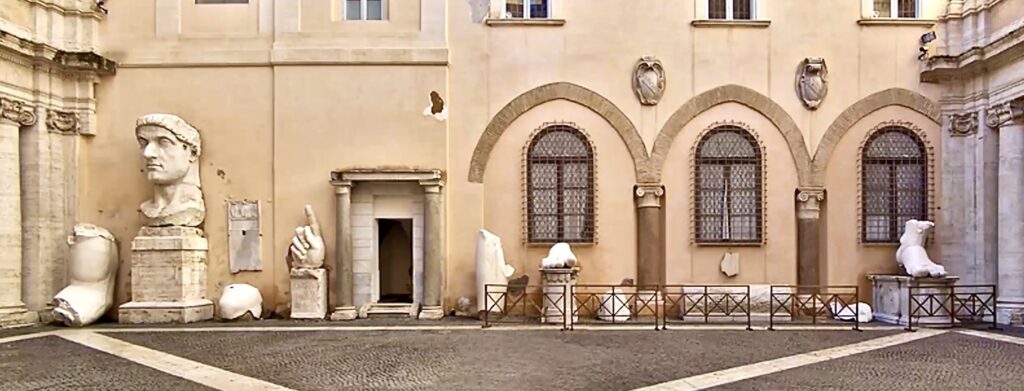
The three arches are the three bays that made up one of the two side aisles of the basilica. What’s no longer there is the central aisle or nave.
The basilica was begun by Maxentius. Constantine completed it, after he vanquished his rival and co-emperor.
There was originally a colossal statue of Constantine on a throne in the nave. Chunks of the 30 feet original statue are in a courtyard of the wonderful Capitoline Museums .
The basilica interior was elaborate, with intense color and ornamentation. The nave was lavishly furnished with gilded ceilings, inlaid marble, and sculptures.
6. Temple and House of the Vestal Virgins
The only people who lived in the Roman Forum were the members of the Cult of Vesta, led by the high priest Pontifus Maximus.
The vestal virgins were extremely famous. Their temple was one of ancient Rome’s holiest spots.
The virgins came from Rome’s noblest families, chosen at the age of 10. They took a vow of chastity for 30 years. They were sacred living creatures. Their job?
To keep alive the flame of Vesta in the circular Temple of Vesta, which symbolized the hearth of the Roman family.
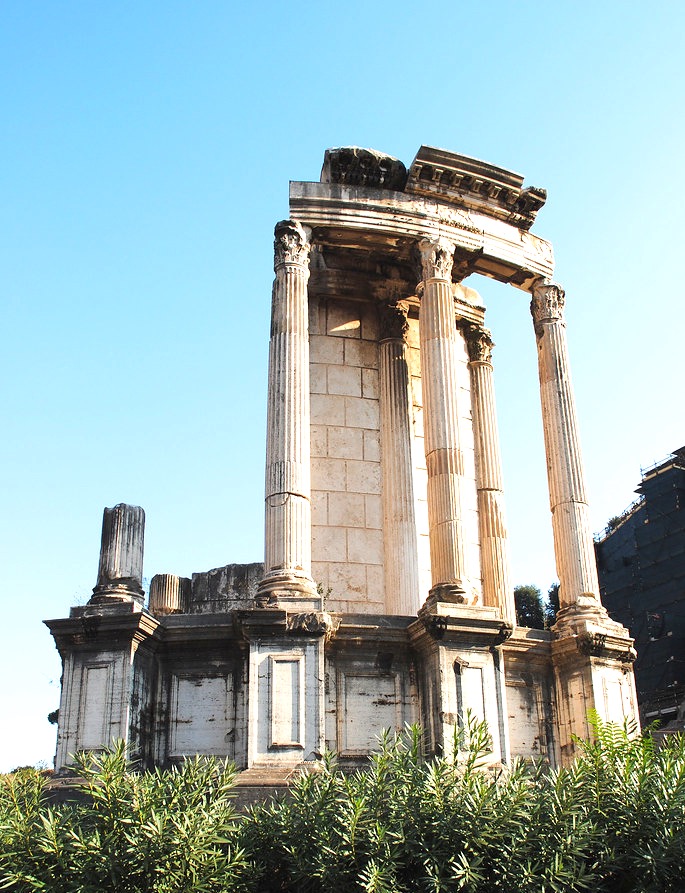
As long as the fire burned brightly, Rome was supposedly safe. The temple was once surrounded by 20 columns.
The House of the Vestal Virgins was a two story building.
The building surrounded a long courtyard with three pools and mosaic floors. The house became a model for later medieval cloisters.
There’s not much left to see, aside from a cult room and sculpures of the vestals.
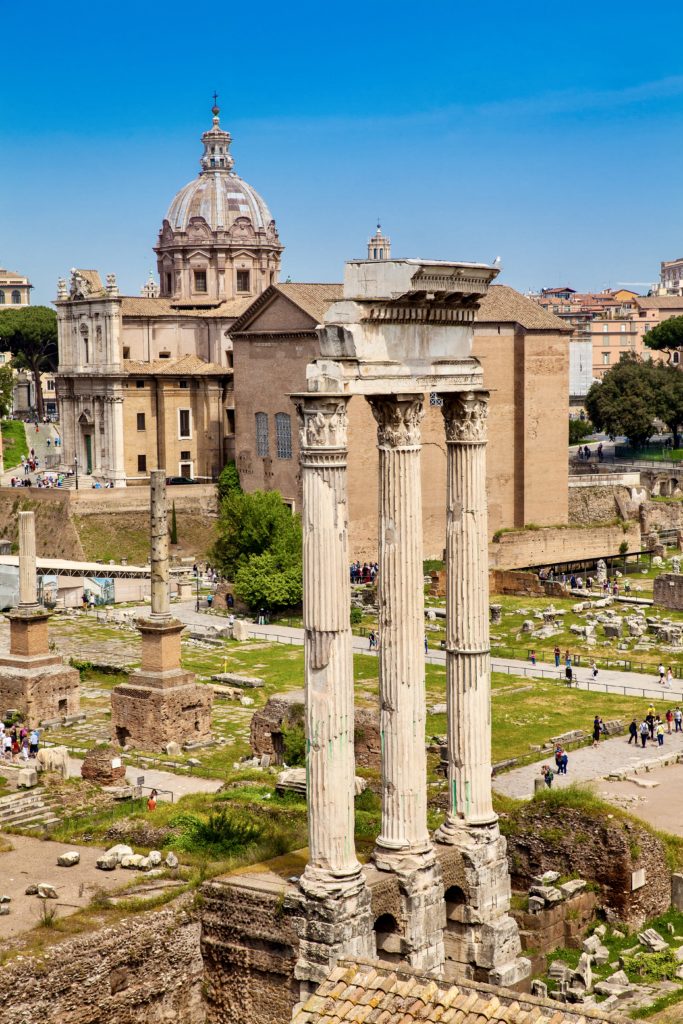
7. Temple of Castor and Pollux
Dating from the 5th century B.C., this former temple consists of just three leafy Corinthian columns. But it was once a prestigious temple in the forum.
The temple commemorated the Roman victory over the reviled Etruscan king Tarquin. After their victory, Castor and Pollux, twin sons of the god Jupiter, watered their horses on the spot.
The temple was often used as meeting place for senators. The front steps served as a podium for Rome’s orators.
8. Domus Tiberiana
Domus Tiberiana is an impressive imperial palace on the slopes of the Roman Forum. Although the entrance is on Palatine Hill, it feels like it’s part of both the hill and the forum because you can easily see it from the forum area.
This once grand estate covered nearly 10 acres, featuring luxurious residences, gardens, spaces for the Praetorian guard, and places for worship. Its standout feature is the facade, marked by large arches and barrel vaults.
The Domus Tiberiana was only discovered in 2004. After years of excavation, it opened to the public in September 2023. I visited in December and it was a truly special experience.
You’ll can only visit with a special SUPER ticket. Individual tickets are not available. For more on how that works, you can check out my guide to the SUPER ticket .
>>> Click to buy a SUPER ticket on Viator
9. Temple of the Divine Caesar
The Temple of the Divine Caesar in the Roman Forum is a famous monument dedicated to Julius Caesar, a pivotal figure in Rome’s transition from republic to empire.
The temple told the story of Caesar’s life. But it also marks the spot where Caesar, assassinated on March 15, 44 B.C., was cremated and buried.
You may get the willies standing there. This is a spot where history changed. Yet, it’s rather underwhelming to look at.
It’s a simple area with a modern canopy covering the remains of an altar. This modest mound is often covered with coins and flowers.
10. Temple of Romulus
The origin of the Temple of Romulus has been the subject of conjecture.
Most historians think that Emperor Maxentius used it as a temple for his son Valerius Romulus, who died at age 4 in 309 and was deified.
The temple’s original bronze door is decorated with two porphyry columns — a marble so rare that it’s almost extinct. Inside, the temple has several cycles of frescoes.
Inside, here are 13th century wall paintings that imitate curtains. There’s also a funerary tabernacle with a madonna and child.
They only allow a set number of people in at a time. So you should expect to wait in line.
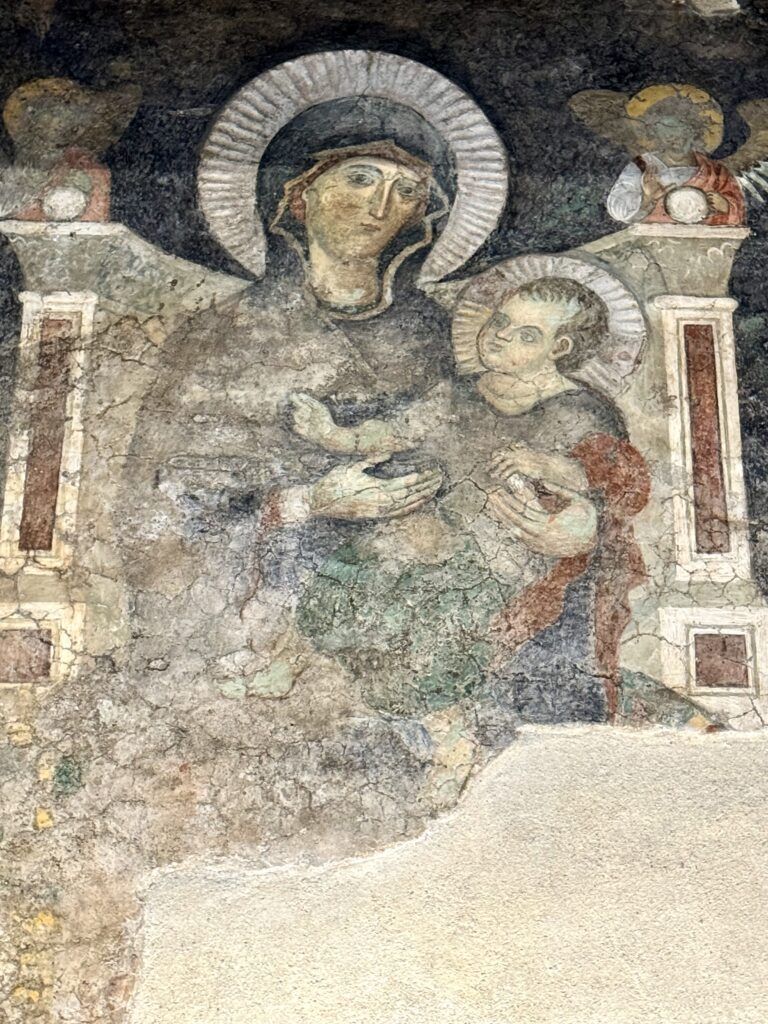
11. Temple of Antonius and Faustia
This temple was built by the Emperor Antonius for his deceased wife, the beautiful Faustina who died young. Historians consider Antoninus to be part of the five “Good Emperors.”
Antonius wasn’t long for the world either. So he decided to slap his own name on the temple as well. That meant he could walk through the forum and see people worshipping him while he was still alive.
The temple has a majestic front. The Corinthian columns are 50 feet high, with formerly gilded capitals.
A staircase led to a shaded loggia past the columns, which admitted Romans to the building. The original triangular pediment would have held vividly colored statues.
12. Santa Maria Antiqua
Santa Maria Antiqua is one of the earliest surviving Christian churches in Rome.
The Byzantine church was discovered in 1900. It was built within a 1st century Roman structure constructed by Emperor Domitian.
The church has a wealth of rare Byzantine style frescos from the 6th to 9th centuries. They depict the lives of Jesus and the Virgin Mary.
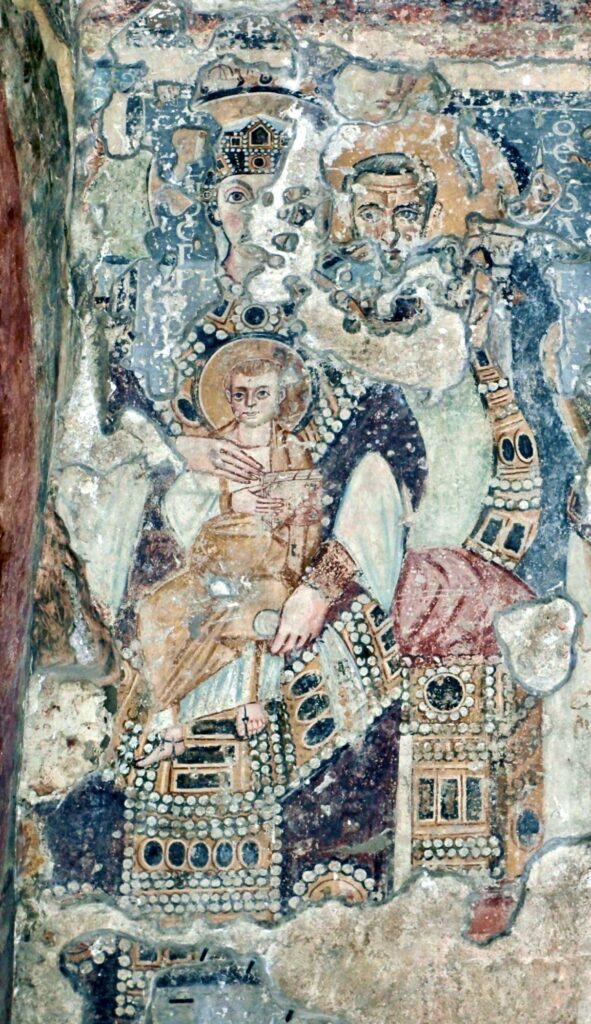
You’ll find one of the world’s oldest depictions of Jesus’ crucifixion. Christ is shown in a sleeveless blue robe.
The best preserved fresco is the cycle of the martyrdom of St. Cyricus and St. Julitta, which covers the Chapel of Theodotus. It’s considered the Sistine Chapel of the medieval era.
During a 9th century earthquake, the church was buried in rubble. It was sealed from the world for over 1000 years, only discovered in 1702. This fate might have saved the precious works from a subsequent Baroque redo.
You can only visit with the SUPER ticket. There is a 3D light show that reconstructs the frescos so you can see what they once looked like in more detail.
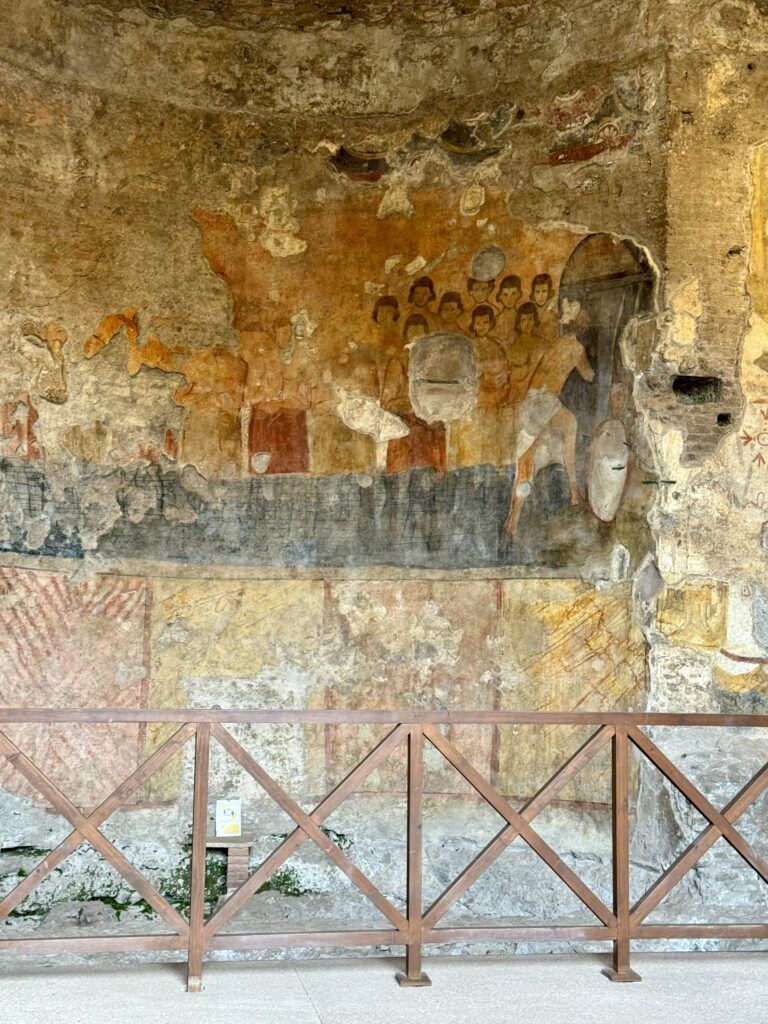
13. Oratory of the 40 Martyrs
Right next to Santa Maria Antiqua, you’ll find the Oratory of the Forty Martyrs, another SUPER site. This smaller room has some faded, but still beautiful, collection of 8th and 9th century frescoes.
The oratory gets its name from the Forty Martyrs of Sebaste, a group of Roman soldiers martyred under Emperor Diocletian for their Christian beliefs.
The frescoes on the walls vividly portray these saints and martyrs, including the Forty Martyrs themselves.
These paintings are key examples of early medieval Christian art and illustrate the martyrs’ ordeal and execution, where they were forced to endure a freezing night in an icy lake.
14. Domitian’s Ramp
In ancient Roman times, Santa Maria Antique was likely the entrance hall to the 1st century Ramp of Domitian. The ramp connected the public area of the Roman Forum to the private imperial palace complexes on Palatine Hill.
It was discovered by Giacomo Boni, an architect and archaeologist. He excavated it mostly between 1899 to 1905.
The ramp has seven levels, six hairpin turns, and is both above and under ground. It empties into a hilltop terrace with a breathtaking view over the Roman Forum.
After years of conservation, the church and ramp opened to the public in 2015. Now, with the SUPER Pass, you can walk along the 2000 year old passage, just like the emperors did.
15. Arch of Septimius Severus
The grand six story Arch of Severus celebrated Emperor Severus’ victory in Mesopotamia.
It’s adorned with reliefs showing soldiers leading captives and slaves back to Rome, reflecting a time when Rome increasingly relied on plunder, contributing to its eventual decline.
Dedicated to Severus’ sons, Caracalla and Geta, the arch became a symbol of family betrayal.
After Severus’ death, Caracalla, who would gain notoriety as an emperor, murdered Geta to rule alone and then erased all traces of his brother from history, including mentions of the arch.
The arch itself features three vaulted passageways, flanked by four detached columns on elevated bases. Below the arch is a circular base, marking the exact center of ancient Rome and symbolizing the saying, “all roads lead to Rome.”
16. Temple of Saturn
This temple, the oldest in the Roman Forum, was more than just a place of worship. It served as the treasury of Ancient Rome.
racing its origins back to the 5th century B.C., the structure you see today was actually rebuilt in the 4th century A.D.
As you look at the temple, the columns that catch your eye once framed its entrance.
Inside, there was once a simple wooden statue of the god Saturn. Interestingly, the statue had a secret: its base was a storage spot for treasures, filled with various forms of booty and plunder from Rome’s conquests.
17. Curia Julia | Sant’Adriano al Foro
The remains of the Curia Julia date from 283. The curia was completely restored in the 1930s.
This was the Supreme Court of Rome, and the most important political building in the forum. The senators gave speeches and promulgated the laws of the land. There were four chambers hearing cases.
It was common for the orator-lawyers to go outside and pay people to come in and clap during their rousing orations. They were essentially professional clappers.
If the curia is open, you can see two statues. One headless statue, made of porphyry marble was dedicated to either Hadrian or Trajan. Unfortunately, it’s usually closed.
18. Rostrum
The Rostrum was the “Speaker’s Corner.” Archaeological evidence suggests that it has existed since the 5th century B.C. But it wasn’t officially called the “rostra” until the 4th century A.D.
The Rostrum was a long stage created for Rome’s great orators to speechify to the assembled masses and try to sway public opinion.
The rostrum was likely 10 feet high and 80 feet long, ornately decorated with columns and statues.
During the republic, freedom of speech reigned free. During the empire, free speech took a hit when it was more dangerous to speak truth to power.
Great events in Roman history occurred here. Cicero railed against Rome’s corruption and decadence. Mark Anthony offered the laurel of kingship to Caesar, who dramatically refused preferring to be a private dictator.
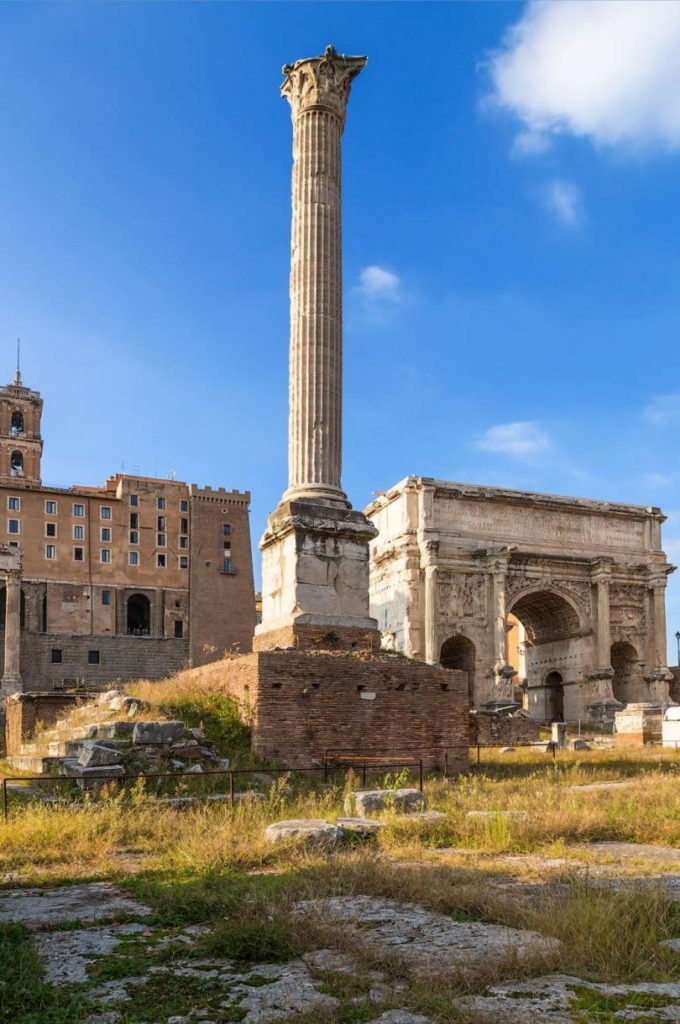
19. Column of Phocas
The Column of Phocas was the last monument to be erected in the Roman Forum. It’s a triumphal column in honor of Phocas, a 7th century Byzantine emperor who ruled Rome from the east.
The column was supposed to represent a unified Rome, a new dawn for the Roman world. But that was a delusion. Rome was on its way out.
And so was Phocas. He had murdered his predecessor to usurp the throne in 602. Two years after this column was erected, he himself was assassinated.
Phocas did succeed in one thing though. He gifted the Pantheon to the Pope Boniface IV to turn into a church, probably saving it from ruin.
The 45 foot column is a little piecemeal. The base once propped up a statue of Diocletian. The column itself was taken from an older building.
It’s recently been restored.
Practical Guide & Tips For The Roman Forum
Address : Via della Salara Vecchia between Piazza Venezia and the Colosseum
Hours : Daily 8:30 am to 7:00 pm
Ticket Price : Combined ticket to visit The Roman Forum, the Colosseum, and Palatine Hill is 16 euros. There is an online booking fee of 2 euros.
Metro : Colosseo
Pro Tips : You can also visit the Roman Forum using the Roma Pass , which is a cumulative ticket that provides free or reduced rates for more than 40 attractions plus public transportation.
I have you’ve enjoyed my guide to the monuments and ruins of the Roman Forum. You may enjoy these other Rome travel guides and resources:
- 8 ways to spend 1 day in Rome
- 3 day itinerary for Rome
- 5 day itinerary for Rome
- 1 day itinerary for Vatican City
- Hidden gems in Rome
- Best museums in Rome
- Guide to the Borghese Gallery
- Guide to Palatine Hill
- Guide to the Colosseum
- Walking tour of central Rome
Pin it for later.
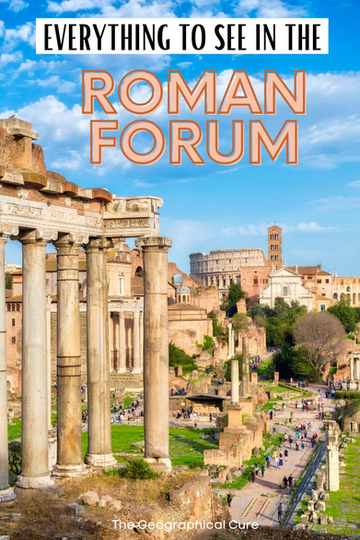
Leave a Comment Cancel reply
Save my name, email, and website in this browser for the next time I comment.
Last Updated on January 21, 2024 by Leslie Livingston
Ultimate Roman Forum Map, Palatine Hill & Roman Forum Self Guided Tour
Complete guide to 37 attractions on palatine hill and the roman forum, self guided tour of palatine hill and forum romanum attractions, palatine hill and the roman forum.
Walking through the roman forum buildings and palatine hill ruins takes us back to a time when this small piece of land was the center of the Greatest Empire known to man namely the Roman Empire that spanned over 1,200 years . The nobility lived on palatine hill and displayed the power of the Roman Empire in the Roman Forum. For over 12 centuries, the roman soldiers and their leaders controlled vast lands from 700 BC to 500AD. For centuries the roman forum was the center of their day to day life, the site of religious ceremonies, triumphant processions, gladiator games and their commercial and economic center. You may have heard the term “all roads lead to Rome” meaning all roads led to this area of land that started as a marshy burial ground in the 7 th century BC and ended up after the fall of Rome as a cow pasture “Campo Vaccino” during the renaissance
In the 1,200 years since the start of the forum, the roman forum buildings have had name changes and function changes. The roman buildings have been destroyed in fires and riots, rebuilt, repurposed, dedicated and rededicated depending on who was out of favor at the time. Each roman forum building and site has its own colorful history which I will explain as simply as I can as roman history can be very complex
General Information
On a macro scale, the Forum and hills surrounding it were divided along functional lines. The Capitoline Hill was the administrative office. The Palatine Hill had the residences of nobility while the Forum at the base of the Capitoline hill was the place of political functions and commerce. The Forum square was also divided along functional lines. On one side you see the dedications to deities via temples, monuments, statues, triumphal arches as well as meeting places for governing and justice. On the other side of the forum you see roman buildings used for commerce; buying, selling and trade including market stalls
After purchasing our roman forum tickets which included two day passes to the colosseum , palatine hill and the roman forum, we started our roman forum tour from the colosseum and headed down the “via sacra” to the Arch of Titus entrance to the Roman Forum. This was the processional route of many religious and military triumphal marches/ceremonies
As you walk down this route, the historic significance is overwhelming when you think about the number of roman soldiers, golden chariots, kings, senators, emperors and other roman citizens who walked these very same streets for over a millennium
Self Guide Tour Map Palatine Hill and Roman Forum
Use the Palatine Hill & Roman Forum map & this self guided tour to visit the ruins. There are over 25 popular attractions; you can also download the google map of the ruins and use it offline as your self guided tour. It’s a good idea to do some planning before visiting the ruins because if you put yourself at the mercy of the tour guide, you may miss the fun of wandering around at your own pace and discovering the various attractions. We used an official tour guide and afterwards realized how much he didn’t cover. It would have been far better to have our own agenda in advance with a map (below) and attractions guide to visit the ruins
Download Interactive Palatine Hill a nd
Roman forum map to use online or offline.
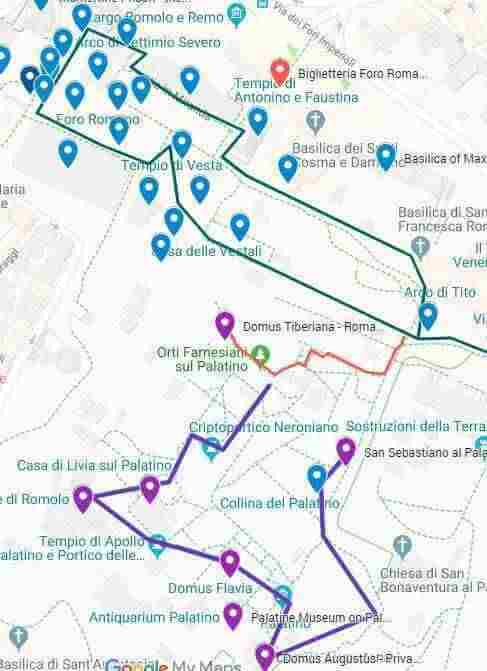
Download the Palatine Hill
Sacred road (via sacra).
Via Sacra is the main street in Rome from the colosseum to the top of Capitoline Hill (Temple of Jupiter Capitolinus). It is also the triumphal processional street from the colosseum to the Roman forum ‘
Many triumphal parades and religious festivals had passed along this route for many centuries. After the Great Fire of Rome in 64AD (attributed to Nero), Emperor Nero paved and lined this route with grand columns and replaced the butcher shops with high end stores at the forum romanum. He also straightened the road, removing the fork that led from the entrance of the forum to the north. Interestingly enough Via Sacra was also used by the prostitutes who lined the street. They mixed in with the Romans who went about their daily lives on the via sacra whether to attend to business at the basilica Aemelia or to visit one of the many shops that lined the street
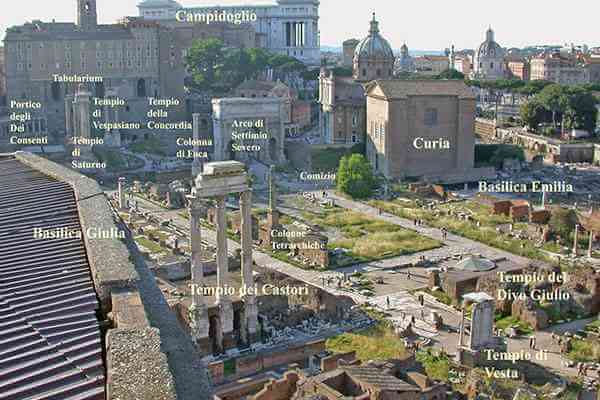
Arch of Titus (Arc de Titus)
The arch was built in 82AD by Emperor Dometian, to honor the Flavius family line , and to commemorate his older brother Titus and father Vespasian. Dometian was too young to take part in the military campaign, specifically referring to the victory related to the Siege of Jerusalem. One of the reliefs on the arch refer to this event and can be seen on the map that is associated with this self guided tour. Click on the Arch of Titus google map pin above to see the image of the relief.
The relief shows two key events from the battle: In one scene Romans are carrying the spoils of war including a menorah (a candelabrum used in Jewish worship) from Judea to Rome. In another scene you see the four horse chariot with the Emperor accompanied by deities and mystical figures in a triumphal march to Rome
Vespasian and his eldest son Titus were victorious over a revolt in the Roman province of Judea (Jerusalem). Many victories were celebrated with the building of a monument whether an arch or a column to remind the population of the triumphs of the Emperor
The arch is located at the base of Palatine Hill at a key location on the main triumphal processional route from the colosseum to the Forum Fomanum on the via Sacra
The inscription on the Arch refers to Titus and Vesparian as Divo Titus and Divo Vesparian. Divo meaning divine as they were deified after death. Whenever you see “Divo” on an inscription it means it was erected after death. The inscription is as follows:
“SENATUS POPOLUS QUE ROMANUS DIVO TITO DIVI VESPASIANI F VISPASIANO AUGUSTO”
Translated as “The Senate and People of Rome dedicate this to Divus Titus, son of Divus Vespasian, Vespasian Augustus”
Who built the Roman Colosseum
It was Emperor Vespasian who commissioned the Colosseum where Emperor Nero’s new place in the roman forum stood. His sons completed the Colosseum construction after Emperor Vespasian’s death. As a result the coliseum is also referred to as the Flavian Amphitheater, after the Flavian Dynasty to which Vespasian and his sons were part of
Octavian – First Emperor to be called Augustus – Emperor Augustus
Emperor Augustus (27 BCE – 14 BCE) was known as the greatest Roman Emperor. His birth name was Gaius Octavian and he was adopted by his great uncle Julius Caesar. The powerful Roman Senate bestowed the title of Augustus meaning “the illustrious one” and he was known as Gaius Julius Caesar Augustus. This did carry some resentment as Mark Anthony was recorded by Cicero as having said “You owe everything to your name”. Augustus was well liked and respected. He restored peace to the Roman empire and the economy, arts, and agriculture flourished under his rule.
Temple of Venus and Rome ( Temple de Venus et de Rome )
What I am about to describe are the many changes that have occurred to the Temple of Venus and Rome and the many name changes it has had over the centuries
The Temple of Venus and Rome is located on the Velian Hill, one of the original of the seven hill settlements that eventually became part of ancient Rome. Refer to image on the interactive map; the interactive map is found by clicking on the map image above. During the time when Roman worshiped idols, the Temple was designed by Emperor Hadrianin in 121 AD and finished by his successor the very popular and well liked Emperor Antoninus Pius in 141AD. (of the Antoninus and Faustina Temple in the Roman forum). Given the slope of the hill, the temple platform faced the colosseum and was 30 feet higher at the top of the hill
The Temple of Venus and Rome was ancient Rome’s biggest temple at 350 feet long and 150 feet wide, comprising of two main chambers where each chamber was dedicated to the goddess of Love and the Goddess of Rome. The temple was damaged in the first of many fires that ravaged Rome. After the fire in 307 AD, the temple was restored by the then Emperor Maxentrius
Emperor Constantine (ruled from 306 – 337AD) converted to Christianity and following his conversion signed the Edict of Milan in 313AD legalizing Christianity and allowing the freedom of worship. It also allowed Christians to build places of worship including St Peters Basilica . Christianity became the official religion of the Roman Empire in 380 AD under Emperor Theodosius I. Many temples and pagan ritual sites were abandoned, including the Temple of Venus and Rome. Emperor Theodosius I also suppressed pagan worship in 390AD, which started the movement to either convert the pagan worshiping temples to churches or to have them stripped to build other churches and monuments throughout Italy
In 625 AD, under Pope Honorius, and with consent of Emperor Heraclius, the abandoned Temple of Venus and Rome was stripped of its bronze and marble to repair Old St Peters Basilica. The next major event to take place to the temple (temple site) was the earthquake in the 9 th century (847AD). It damaged many buildings in the roman forum and virtually destroyed what was left of the temple
Santa Maria Nova (“New” Church)
The earthquake severely damaged the oldest church in the roman forum, the Santa Maria Antiqua. It was built in the 5 th century on the north-west slope of Palatine Hill which was an ancient hill known as Velien. Pope Leo IV ordered the building of the Santa Maria Nova Church (nova meaning new) on the site of the Temple of Venus and Rome
Santa Maria Nova Church, the “new” church was built to replace the Santa Maria Antiqua, as the place of worship. Once the Santa Maria Nova was built, the obligations and rights of the Santa Maria Antiqua was transferred to the Santa Maria Nova
In 1612, Santa Maria Nova Church underwent major restoration and was renamed Basilica di Santa Francesca Roman. It was rededicated to St Frances (1384-1440) who was born a noble woman. She dedicated her life to to helping the poor and was canonized in 1608. Her remans are still in the crypt in the church
Basilica of Maxentius (Basilique de Maxence et Constantin)
The site was the location of the Horrea Pipertataria warehouse which burned down in the fire of 283 AD. Horrea Pipertataria was built in the 2 nd century to store grain, clothing, marble, olive oil and other food items. When Emperor Septimius Severus (Same person who built the Septimius arch in the Roman Forum), died in 211 AD he had stockpiled enough food in the warehouse to feed the 1 million citizens of Rome for 7 years
The construction of the Basilica on the site of the warehouse began in 308AD under Emperor Maxentius and was completed under Emperor Constantine in 313AD. Constantine completed the basilica after he defeated Maxentius at the Battle of the Milvian Bridge in 312AD. A painting by Raphael showing this moment in history is on dispaly in Raphael Room 1 Hall Of Constantine titled The Battle of Milvian Bridge on the south wall. The basilica was nearly complete when Constantine took over the building and design thereby making minor changes. The changes included re-positioning the entrance from facing the Temple of Venus and Rome to facing Palatine hill to the South. He also added another apse, and replace the colossal statue of Maxentius located in the western apse with his own head
The Basilica’s originally functioned as a courthouse, administration building, meeting hall and a place of business, in essence a roofed extension of the forum. Over time the design of the basilica was used in the building of churches and basilicas and became synonymous with places of worship. Emperor Constantine felt that the design of the basilica, shaped like a crucifix, would be the perfect design for Christian worship. Many churches all over the world today are designed in the same way ie: in the shape of a crucifix
The Basilica of Maxentius and Constantine speaks to the engineering ingenuity of the Romans taking aspects of designs from the roman baths and of typical roman basilicas. Engineers today marvel at the technology that allowed the massive 130 feet high barrel and cross vaults to stand unsupported using unenforced concrete. It is a colossal structure of 6500 square feet and 66ft high. Of the Corinthian columns of marble that were built only one of the eighth has survived
Temple Of Divus Romulus (Temple de Romulus)
Originally it was the site of the temple of Jupitor Stator or Temple of Penates, identified by its rotunda. After the great fire in 306AD, Emperor Maxentius began a great rebuilding program in the roman forum. Maxentius and the Pagans were losing ground to the Christians which were estimated at 25% of the population. Maxentius who was trying to revive the old original pagan gods and temples, was killed by Constantine who eventually led in the era of Christianity.
Maxentius rebuilt this temple and dedicated it to his young son Valerius Romulus who died in 307AD. Romans believed that by building a temple dedicated to themselves, they became a deity (God). Emperor Constantine, after defeating Maxentius, renamed it back to its original name of Temple of Jupiter Stator
The temple was Christianized in 527 AD and the rectangular hall attached to the temple became the Basilica of Santi Cosma e Damiano (Basilica of Saints Cosmas and Damian). It was dedicated to twin brothers from Greece; Cosmas and Damian. They were both physicians, who were martyred and became saints. It is a functioning church today with an entrance from via dei Fori Imperiali
The most striking feature is the circular dome, with red porphyry columns surrounding the massive 4 th century bronze door. Legend has it that if a person is sick and sleeps in the Church, they would be cured by receiving a dream that would lead to a cure
In 1632, Pope Urban VII had the basilica restored. They raised the floor seven meters to match the current main level of the roman forum which had risen due to the pile-up of debris. It was further restored in 1947 adding a main entrance from the street and closing the one from the forum. Along with the Pantheon, it is one of the best preserved pagan temples in Rome
There is an additional charge to view the Temple of Romulus and is included as part of the SUPER ticket
Antoninus and Faustina Temple
By historical accounts, Emperor Antoninus and his wife Faustina had a happy marriage. They had two sons and two daughters. Faustina died at the age of 35. Antoninus was devastated by her death and sought to deify her. As a well-liked emperor he received the support of the senate and the temple was built in 141 AD dedicated to his deified wife Faustina the Elder. Emperor Antoninus established a charity dedicated to her called the Girls of Faustina whose goals were to assist orphan girls. Antoninus was the adoptive son of Emperor Hadrian and one of five “good” emperors of Rome. He reigned for 23 years, longer than any other Emperors other than Augustus. Like his father Hadrian, he disliked war and did not feel the need to expand Rome’s borders any further. His reign concentrated on making life better for those who lived within the empire. This resulted in the longest period of peace Rome had experienced. Historical accounts show him to be well spoken, a good orator, kind hearted, calm and not easily tempted by money and power. He exemplified what the romans wanted in an emperor. He died at the age of 74 in 161AD with such a high level of popularity that he was unanimously deified by the usually squabbling senate. The temple of Faustina was rededicated jointly to Antoninus and Faustina at the request of his successor Marcus Aurelius.
The temple was converted to a roman catholic church in the early seventh century and renamed Chiesa de San Lorenzo in Miranda. It is believed that this was the location of the sentencing of the St Lawrence by the Prefect of Rome. Over time its porch was enclosed with chapels. The notches in the upper part of the columns indicated the mark where the sloping tile roof of this structure was fitted into another ancient structure (they are not rope marks in an attempt to bring down the pillars as stated by various tour guides). The height of the door represents the ground level at the time the temple was built
House of the Vestals
Located behind the circular Temple of Vesta . It was the home of the Vestal Virgins, a female priesthood in Ancient Rome. There were six Vestals between 6 to 10 years old from noble roman families. They were in charge of carrying our numerous rites and rituals including keeping the eternal fire lit in the Temple of Vesta . The served for thirty years where the first 10 years they learnt the sacred rights, the next 10 years they performed these rights and the next 10 years they taught the next set of girls. The sacred rights included fetching holy water, keeping the eternal flame lit, guarding sacred objects, preparing sacrificial items, and other complicated ritualistic acts and ceremonies. During the thirty years served as vestal virgins they were forbidden from having any carnal relationships. At the end of their service, they were free to marry. No one was to harm them as they would be punishable by death and they were allowed to own property
They were watched over carefully by the Pontifex Maximus who had an adjoining house. If they failed to follow the chastity rules they were buried alive in a chamber below ground and their lovers were flogged to death. If they failed to perform their duties, like letting the lit fire go out, they were severely punished including being beaten with rods by the Pontifex Maximus. The rules became so stringent (no joking allowed) and the punishments so harsh that many parents were unwilling to offer their children to the task
The vestals lived together in the House of Vestas which was completely self-contained with a kitchen, a grain mill, an oven, baths, dining room, pools, a portico and courtyard complete with statues of featuring previous Vestals. After the great fire of 64AD, it was rebuilt by Nero. It underwent another restoration by Trajan and then again under Emperor Septimius Seversus. It shows the dedication to the cult over the years
After the suppression of pagan rituals by Theodosius in 390AD, the Vestals left in 394AD and the complex was used as imperial offices
Temple of Vesta (Tiempo di Vesta or Temple de Vesta)
It is located in the roman Forum near the House of Vestal Virgins. It is easily recognizable by its circular shape (refer to interactive map for image). Vesta temples were round and had east facing entrances to make a connection between the eternal fire and the Sun. The cult was started in 7 th century BC by Numa Pompilius, the legendary second King of Rome. The eternal fire represented the symbol of eternity of Rome and the romans believed that their fortunes were tied to the flame of the fire. As long the fire burned, Rome would dominate and extinguishing of the fire was viewed as a disaster for Rome
Like other buildings in Rome, the temple was built and rebuilt many times due to fires and earthquakes. The first destruction was in 390BC then again in 241BC, in 210 BC and during the time of Nero and Septimius Severus. It shows the romans dedication to the cult over the many centuries
The Temple remained mostly intact until the Renaissance when it was stripped of its marble and other assets. In 1549 AD it was stripped of the remaining marble to build palaces, monuments and churches throughout Italy. It was completely demolished at that time and only a few pillars and a partial base remain.
The debris from demolishing of the many buildings as well as earthquakes caused the roman forum to be buried over time
Temple of Caesar (Temple dei Divo Guilio, Temple de Caesar)
Julius Caesar was killed in 44BC on March 15 , commonly refer to as the “Ides of March”. He was stabbed 23 times by each of the 23 senators. The last stab wound was by his good friend and advisor Brutus. As the knife went into Caesar, he whispered “et tu Brute” translated as “you too, Brutus”. This is now a famous modern day phrase referring to betrayal
In Caesar’s will he had left 75 drachmas (1/3 of a soldiers annual pay) to every roman citizen living in the city. He left his private gardens to the citizens of Rome and named his successor as his adopted son and nephew Octavius. At his funeral, his general and loyal supporter Marcus Antonius (Mark Anthony) gave a speech at the Rostra. His eulogy inflamed the already heightened emotions of the roman people who now viewed Caesar as a deity
Julius Caesar’s Funeral
At Julius Caesars funeral, on the podium at the Rostra in the Roman Forum, Mark Anthony made his famous speech starting with “ Fr iends, Romans, countrymen, lend me your ear… “. In a dramatic fashion, Mark Anthony uncovered Caesars toga and lifting it at the end of his sword and waving it towards the crowds so they could see the gashes made by the 23 knife wounds. The crowds rioted, grabbed Caesar’s body and wanting to deify him, took the body to be buried with the other gods in the Temple of Jupiter on Capitoline Hill. They were turned away by the priest as people were not buried in temples. They returned to the forum with his body and cremated him in front of the Regia (palace of the Kings)
In 42 BC the construction of the Temple of Caesar began after the senate defied him and at that time Mark Anthony was named as the first priest of the temple. The construction took a long time and remained undedicated until 29BC. The site of the temple was the location of Julius Caesar’s cremation. In the years that ensued, there was a power struggle between Octavian (Julius Caesars named heir), and Brutus. Mark Anthony and Octavius combined forces to defeat Brutus’s army
Following Brutus’s defeat, there was a power struggle between Octavius and Mark Anthony, who had taken up with Cleopatra in Egypt. He was hoping to use Egypt’s wealth to launch an assault on Octavius. Their failed attempt led to the suicide of Mark Anthony and Cleopatra’s in 31BC. Octavian became one of Rome’s most beloved rulers and also its first emperor under the name Caesar Augustus
Augustus created a new roman tradition which was that dead roman rulers could be deified and as a god, they would have a temple dedicated to them. Julius Caesar was the first roman to be deified and honored with a temple named after him. The Temple of Caesar was dedicated to him on August 18, 29BC
Today the site of the Temple of Julius Caesar contains a mound of dirt that many leave flowers on. This was the altar of the temple and the actual site of his cremation
Shrine of Venus Cloacina (Sacrum Cloacina, Cloaca Maxima)
The roman forum started its life as a marshy burial ground for the settlements of the seven hilltops that surrounded this valley. Eventfully the settlements started to meet and trade. The marshy valley was seen as a perfects spot for a market to trade. They developed an ingenious sewage system called the Cloaca Maxima . It is one of the world’s earliest sewage systems. The shrine marks the entry to the system that drains the forum and it is marked by a shrine on unknown height and 8 meters in diameter thought to have been constructed in 33BC
Basilica Emilia
In 5 th century BC, the site was that of butcher shops called tabernae lanienae. In the 4 th century BC they were replaced by tabernae argentarie that is the city bankers or the center of banking. The building has undergone either damage or destructions due to fires, natural disasters and has been rebuilt in 210 BC, 191BC, 179BC, 14AD and 22AD. The 22AD restoration resulted in a basilica that catered to the courts, markets, shops and a place for public speaking. The latest rebuild resulted in a portico that overlooked the forum and was dedicated to the grandsons of Emperor Augustus; Gaius and Lucius (Porticus Gai et Luci). The basilica was almost completely destroyed by King Alaric and his Visigoth army in the Sack of Rome in 410 AD. It was rebuilt in 420 AD and finally collapsed in the 847 AD earthquake. The remains were used as building materials for monuments and churches elsewhere
Column of Phocas
The 44ft fluted column was dedicated to the Byzantine Emperor Phocas, Who had murdered his predecessor along with his five sons to seize the crown in 608 BC. The column of Phocas, located close to the Arch of Septimius is a rededicated column and the last addition to the roman forum. Originally dedicated to Emperor Diocletian, it was rededicated to Emperor Phocas in 608 BC. The original inscription at the base has been chiseled off and a new inscription praising lord Phocas as the perpetual emperor, crowned by God is still visible. The precise reason of this honor is unknown however it may have to do with Phocas’s donation of the Pantheon to the Church in the time of Pope Boniface IV. Most columns had a statue on top and this one was no different. The top of the column had a gilded statue of Phocas
Two years after the column was erected, Phocas suffered a heinous death in 610BC. His private parts were cutoff, he was skinned, beheaded and his body burned because he had raped a noble woman, identified as the wife of Photius, who was in service to God. Statues and monuments to him were then destroyed across the empire
Curia Julia
Curia was used to denote a place of meeting where an assembly or council discussed religious, official and public issues. Curia became synonymous with the meeting place of the senators. The powerful original House of the Senate was originally built by Emperor Tullus Hostilius, known as a warrior king. He was the third King of the 7 kings of Rome whose grandfather fought alongside the Romulus, the founder and first King of Rome
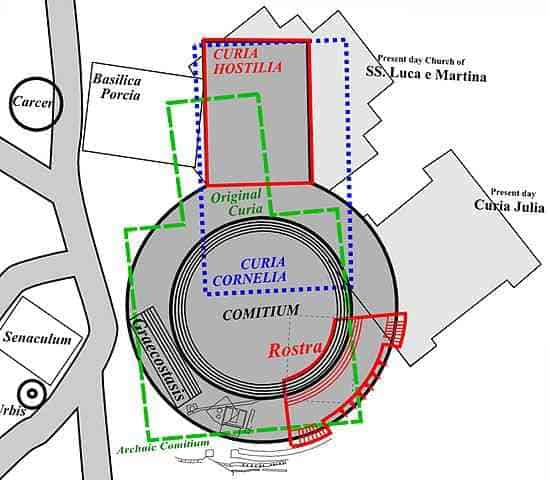
The Curia Hostilia began as a temple just next door to the current Curia Julia. The temple was the location were the warring tribes laid down their weapons during the reign of Romulus. The temple was used by senators as an indoor meeting place and a space was reserved outside for outdoor assembly. This space was called the comitium. The role of the senators was to act as council to the King. The temple was destroyed by fire and the Curia Hostilla was built next door to the original temple site. The site where the temple was, is the location of the present day Chiesa dei Santi Luca e Marti Church
In 80 BC, the dictator Lucius Cornelius Sulla enlarged the Curia Hostilius into the comitium space to accommodate additional senators. This new House of Senators was called Curia Cornius. Curia Cornius was burned down in the riots of 52BC. Curia Julia is the third name for the House of Senate. It was built in 44BC by Julius Caesar. During the construction phase the meeting place for the senate was relocated to Teatro di Pompeo (the theater), a temporary curia. He overhauled the curia design of both the House and the Comitium reducing the size of house and the number of senators (from 600 to 300). Caesar was assassinated by some of the senators before the curia was completed. His assassination was carried out by 23 senators (hence 23 stab wounds) who were worried about his thirst for power as he had also named himself dictator for life
Curia Julia was completed by his successor and nephew Octavius (Emperor Augustus Caesar) in 29BC. The structure has remained intact as it was converted into the Sant’Adriano al Foro in the 7 th century and further renovations were completed in the 1930’s
Lapis Niger
The Tomb of Romulus who was the founder and first King of Rome . The tomb is located in a prominent position in front of the Senate (Curia). It is covered with a black marble. The area is blocked off with a rope or railings. The oldest Latin inscriptions can be found on the column next to the tomb that suggests that a curse will befall anyone who walks on the site. You can see the Lapis Niger (large black marble slab) on one of the recreations of the roman forum self guided tour and map that accompanies this guide
The speakers’ platform, known as the Rostra was built directly at the base of the Constantine arch and next to the Lapis Niger
Chiesa dei Santi Luca e Martina (Eglise Saint Luc et Martine)
This was built on the site of the comitium, the meeting place of the roman senators. A portion of the comitium was replaced by the Curia Hostilia, the first house built specifically for the senators. This was replaced by the much larger Curia Cornelia in 80 BC which was demolished by Julius Caesar to build a much smaller Curia Julia in 44BC
Martina of Rome was from a noble family and was orphaned at an early age. She turned to Christianity and was persecuted by Emporer Alexander Severus as she defied his command to return to idol worshipping. She was subject to various forms of torture and was finally beheaded. She was martyred in 228AD. Pope Honorius I commissioned the construction of the church dedicated to St Martina in 625AD. It was restored in 1256 AD under Pope Alexander IV. It underwent another renovation in the 17 th century
Mamertine Prison – the Tullianum
It was built around 640 BC as a cistern (to hold water) for a spring. Sometime in the 4 th century BC, it became a prison. Above the spring were two floors; the lower level dome shaped dungeon called tullianum used for executions and the upper level used to hold prisoners awaiting trial. Prisoners were lowered into the dungeon (lower room) through a small round opening to die slowly. These were prisoners who were not executed publicly. Roman law did not have imprisonment as a sentence, therefore incarceration was a temporary measure for the sentence that was passed down at trial ie: hard labor, death, etc. The tullianium or jail was used as a holding cell for short periods
The apostles St Peter and St Paul are said to have been held prisoners here before their execution. An altar dedicated to them is located in the lower level of the building. It is said that the spring miraculously stated to flow when St Peter was held here and he was able to baptize his prison guards. The cross on the altar is upside down as Peter was crucified upside down. An Altar showing the event of St Peter baptizing his prison guards is located in St Peters Basilica , the site of St Peters Crucifixion . A painting by Raphael titled “Deliverance of St Peter” is in Raphael Room 2 Hall Of Heliodorus, north wall of the Vatican Museum. He was crucified in the Circus of Nero, Old St Peters Basilica was built on the Crucifixion site, his tomb is HERE in St Peters basilica
The site was converted into a Christian place of worship in the medieval times and today has a chapel on each level
- The Lower level – Capella San Peitro in Carcre (Chapel of St Peter in Prison)
- The Upper level – San Giusppe Dei Falegname
There is an additional fee to enter if you purchased the regular entrance to the forum, coliseum and palatine hill. You may need to book a time slot to enter
Septimius Severus Arch (Arc de Septime Severe, Arco di Settimio Severo)
The 23 m high and 25 meter wide arch was built in 203 AD to honor the Emperor Septimuis Seveus and his sons Geta and Caracalla. The reliefs in the arch portray the victories against the Parthians and other reliefs show romans capturing barbarians. The arch was topped with a gilded statue of Septimuis and his two sons riding in a chariot pulled by six horses. Unsurprisingly, given roman history, after Septimius’s death, Caracalla took over the throne and had his younger brother Geta killed in 212AD. He even had his name chiseled out from the dedication inscription of the arch and replaced with additional titles and dedications to Septimius and Caracalla
The Rostra (I Rostri, Rostra vetera)
The rostra is a platform measuring 24mx12m at the base of the Arch of Septimuis. It was built as a speaker’s platform where any citizen could address the crowds. It was from this platform that Mark Anthony address the Romans after Julius Caesar’s assassination in his famous speech starting with “Friends, Romans, countrymen, lend me your ears…”
Umbilicus Urbis
The Umbilicus Urbis is located close to the Arch of Septimuis. A small plaque on a circular brick structure with latin inscription is used to denote the location. It is the symbolic center of roma
Below this location is the Mundus, the gateway to the underworld of the dead. The pit was ritually opened three times a year. According to legend, when Romulus founded rome, he had a circular pit dug and the first fruit of harvest along with a handful of dirt from the citizens place of origin was thrown into this pit every year and the city of Rome was built around it
Milliarium Aureum
Translated as the “golden milestone” it was built in the time of Emperor Augustus Caesar (birth name is Octavian – the nephew of Julius Caesar) in 20BC. Used to measure distance, all locations in Rome Empire were measured relative to their distance from the golden milestone. “All roads lead to Rome” refers to this central spot of Rome’s road network
Temple of Vespasian and Titus
Upon the death of his father Vespasian, Emperor Titus started this temple to deify his father. He died before the temple was completed and his younger brother, Emperor Domitian completed the structure and dedicated it to both his father and his brother. The dual dedication raised the status of the Flavian family to which Domitian belonged. Domitian was also responsible for the construction of the colosseum or Flavain amphitheater
A central repository of official city documents from 78BC, the project was commissioned by the roman dictator Lucius Cornelius Sulla (from the Curia Cornelius era). The tabularium is a 74m long building located at the base of Capitoline Hill. It was the location of Rome’s official documents and offices of many city officials, the city hall and records office. The building housed the public state archives including important public acts of ancient Rome, the decrees of the Senate and peace treaties. Its laws and treaties were kept here on tablets. The tablets were engraved on bronze tabulae (hence the name of tabularium). You will not be able to enter as the building is closed to the public
Temple of Saturn (Templo de Saturno)
This site was the location of the Altar of Saturn. The altar was replaced by the Temple of Saturn which was dedicated to the agriculture god in 497BC. The order to build the temple was given by King Superbus, the last King of Rome before the start of the Roman Republic. At one time it held the public treasury which was beneath the stairs under the high podium. The temple underwent several restorations in 42BC and after a fire in 283AD. Very little else is known of its history. It is identified by the eight columns that are still left standing at the foot of Capitoline Hill on the western end of the roman forum
The worshipping of Saturn was celebrated on December 17 every year dating back to the 5 th century. It was a very popular celebration which included exchanging of gifts, slaves were given the same rights as other roman citizens and there was a general atmosphere of goodwill. The celebrations could last up to seven days. Over time this festival was rolled into the Christmas celebration
Basilica Julia (Basilica Giulia)
The land was part of the House Scipio Africanus, a great roman general known as the Scipio the Great. He eventually retired to the country after being disillusioned by the roman political system and led a quiet life before his death in 183BC. Tiberius Sempronius inherited this land through his wife, who was Scipio’s daughter. Sempronius was a popular roman political figure, who built the Basilica Sempronia, on this site in 169BC. In 54 BC Julius Caesar demolished the Basilica Sempronia to build the Basilica Julia at 101 meters long and 49 meters wide
The basilica Julia was completed by Augustus (Octavian) and dedicated to Julius Caesar in 46BC. It burned shortly after and was repaired and rededicated in 12 AD. It was the location of four civil courthouses in an open plan layout. Historical documents show the exasperation of senators as they pleaded their cases and were drowned out by others in the court rooms adjacent. Those with great oratory skills seemed to get the most applause and best audience, frustrating the other senators who had a hard time having their case heard above the adjacent court room applause and speeches
One of the court rooms held the Court of Hundred, which ruled over inheritance issues. One particular interesting issue is that of a woman whose 80 year old father disinherited her 11 days before his death in favor of his new wife. The daughter took the wife to court and won the lawsuit.
The Basilica was a favorite meeting place. Aside from the court rooms, it included shops, the portico showed floor etchings of checker or chess type boards. It was destroyed by fire in 283AD and rebuilt and destroyed again during the Visigoths Sack of Rome in 410AD and restore in 416AD. Part of the basilica was converted into a church in the 7 th or 8 th century
Temple of Castor and Pollux ( Il Tempio dei Dioscuri)
It is located next to the basilica Julia but only three pillars remain of the temple. Castor and Pollux were twin sons of Jupiter where Pollux was immortal and Castor was mortal. Originally built in 484 BC after the roman general and dictator Postumius defeated the Tarquin Kings who had ruled Rome. Legend has it that the twin brother Castor and Pollux helped the roman army defeat the king’s army and then were seen to have stopped at a watering hole for their horses at the Juturna Springs. The temple was built right next to the Juturna Springs fountain. Like other buildings in the Roman Forum, it underwent destruction and rebuilds over the centuries falling into decline staring in the 4 th century AD after pagan worship was discontinued
Santa Maria Antiqua (Ancient Church of St Mary)
It is located at the back of the Temple of Castor and Pollux, close to Basilica Julia at the base of Palatine Hill. The church was converted from an old guardhouse that was attached to a ramp and was most likely the entrance hall to the Ramp of Domitian. The ramp connected the imperial palace on palatine hill to the forum and allowed the emperor to move between the two in his chariot. It is still in its original form
After the 9 th century earthquake (847AD) it was buried, thereby sealing and preserving it, until it was discovered in the 20 th century. This preserved many of the original frescoes and both roman and Greek-byzantine artwork from the early middle ages. With a stunning interior brought to life by modern technology, one feels that they have gone back in time 1500 years as it’s so well preserved. A definite visit if you are in the roman forum. The church is not always open to the public due to ongoing excavation
There is an additional charge to view the Santa Maria Antiquaand is included as part of the SUPER ticket
Domitian’s imperial Ramp
It was built in the 1 st century BC connecting the roman forum to the imperial palace on palatine hill. The 200m long ramp was designed to allow the emperor to make a majestic entrance by chariot. Originally there were 7 ramps levels with six turns in between. Some ramps are above ground and others are below ground. Only 4 ramp levels have survived, the rest are thought to have been destroyed in the earthquake of 847AD. The reception hall of the ramp was converted into a church in the 6 th century ( Santa Maria Antiqua )
Lacus Juturnae ( Spring of Juturna)
The fountain is from the 2 nd century BC and is dedicated to the water nymph and goddess Juturna. It is located at the foot of Palatine Hill were Castor and Pollux stopped to water their horses before after the battle of Lake Regillus in 496BC. The spring was most likely a source of fresh water for Palatine Hill. On occasion, the spring was used by the Vestal Virgins for their religious ceremonies. The water at the Lacus Iuturnae was thought to have healing properties. The elderly and infirm would go to the spring with offerings in order to secure the assistance of Juturna in curing their illness. It was in use until the aqueduct was built in 312BC
Domus Tiberiana – Roman Forums
The official palace of Emperor’s Caligula and Nero on Palatine Hill. The ground was leveled to build a very long terrace and colossal walls. Most of it is still buried beneath Cardinal Alessandro Farnese’s Gardens of the 16 th century. Caligula linked the palace via a bridge to the Temple of Castor and Pollux. The bridge was disbanded after Caligula’s assassination. It was destroyed in Nero’s great fire of 64AD and he built another palace to replace this one, the Domus Aurea. The Domus Aurea, referred to as the Golden House, was hated by the Roman public and led to Nero’s downfall
Farnese Gardens (Orti Farnesiani sul Palatino Rome)
The first private gardens in Europe, they were the work of Cardinal Alessandro Farnese (Alessandro Farnese became Pope Paul III). He purchased a portion of the ruins of Domus Tiberiana on palatine hill in 1550 AD. He had it filled in and converted into a summer home with terraced botanical gardens that overlooked the roman forum. There are some remnants of the Farnese Gardens including ruins of fountains, pools and pavilions that attest to its beauty, however very little has survived. The Farnese family home was located in the Palazzo Farnese in Ancient Rome and the Villa Farnese in the Trastevere region, across the Tiber River.
Palace of Domitian (Flavian Palace or Domus Flavia or Domus Augustana) – Nero’s Palace on Palatine Hill
The Palace of Domitian was built on top of Neros Domus Transitoria palace located on Palatine Hill. It was Nero’s first palace . After the great fire of 64AD, he moved from this palace to the new palace in the Roman Forum. The new palace was hated by the people, it was eventually demolished to build the Roman Colosseum .
Nero is said to have caused the fire of 64AD so that he could build a new palace in the Roman Forum, which he did. However he blamed the Christians for the fire and as punishment he crucified St Peter on that lie. St Peters Basilica was built at the site of St. Peters crucifixion. Then using the ”newly created” space in the Roman Forum, Nero’s built his new palace and moved from his palace on Palatine Hill to the new palace in the Roman Forum. The Roman’s eventually realized what he had done and that led to his downfall. The new palace was demolished and/or repurposed and on that same site the colosseum was built. ( Map of Colosseum)
The Palace of Domitian, also called Domus Augustana , was built at the end of 1 st century BC overlooking Circus Maximus. The complex contained separate areas for business activities, personal life and outdoor gardens. Domus Augustana referred to the private area of the palace and Domus Flavia referred to the public area of the Flavian Palace
Flavian Palace Structure:
- The gardens or stadium was a large rectangular area with gardens and an area for performances, smaller events and foot races
- Domus Flavia is easily identified as it had three vaulted halls that faced the roman forum. Two of these halls were basilicas and one was a large reception hall. During this period basilicas were meeting places to conduct business and not as a place of worship
- Domus Augustana had a large pillar courtyard, a spacious outdoor dining room called a triclinium, and private rooms
The palace become the office residence of the subsequent emperors and remained virtually intact until the fall of the Western Roman Empire in 5 th century AD.
House of Livia on Palatine Hill
Home of Livia; she was the wife of Emperor Augustus (Octavian) and was also known as Julia Augustus. Livia and Augustus had houses side by side on Palatine hill. You could say her house of part of the Augustus palace. Livia also had a Villa in Pompeii, Villa dei Misteri , that was destroyed during the eruption. There is an additional charge to view the House of Livia and is included as part of the SUPER ticket; you will need to book a time slot to enter
Domus Augustus on Palatine Hill (House of Augustus)
Octavian (Emperor Augustus Caesar) bought the house from a famous orator Quintus Hortensius and moved his residence from the roman forum to palatine hill. He expanded the house in 36BC. His house should not be confused with the 92AD 8,600sqm palatial complex of Emperor Domitian on palatine hill called Domus Augustana and also known as Palace of Domitian. Octavian’s house was considered very modest for an emperor. It is said that he slept in the same bedroom for 40 years. He built an adjoining house for his wife Livia, called the House of Livia. On the site he built the Temple of Apollo Palatinus.
The rooms in the house are identified by the well preserved frescoes ie: the pine Festoon room (room 6) and the room of masks (room 5). The house was destroyed by a fire in 3AD. It was rebuilt and became a property of the state. A tour of the house reveals his bedroom, study, hallway and a variety of stunning frescoe. The house has additional significance as it is located close to the hut of Romulus, and on the site of the Lupercal. The lupercal is said to be the cave where the she-wolf nursed Romulus and his twin brother Remus until they were discovered by the shepherd Faustulus who then raised them
Hut of Romulus (Casa Romuli)
A single room mud and straw hut on palatine hill, this is said to have been the residence of King Romulus, the founder of Rome . It was used by the pagan priests to offer sacrifices. The hut has suffered the same fate as many buildings in the roman forum having been damaged by fire and storms however it was restored to its original state on these occasions
Palatine Museum on Palatine Hill
Many artifacts from the excavation of palatine hill are located here, these include statues, mosaics, frescoes, pottery and an informative video. There are washrooms located just outside the museum as well. Entry was included in the regular roman forum ticket and may now be part of the new SUPER ticket, which is an additional purchase
San Sebastiano al Palatino
A small 110×150 meters church on Palatine Hill dedicated to the 3 rd century Christian martyr Saint Sebastian. It is built on a previous pagan temple site, using the foundations of the temple to build the church. Saint Sebastian was killed during Emperor Diocletian’s persecution of Christians. He was tied to a post and shot with arrows, which did not kill him. Saint Sebastian was rescued and eventually bludgeoned to death in 288AD. He was known as the saint who protected people from the plague
Circus Maximus (Circo Massimo)
A largest entertainment venue of ancient Rome accommodating 150,000 spectators at one time. It was built in the Valley of Murcia between Palatine Hill and Aventine hill, the earliest seven hill settlements of Rome. The venue measured 621mx118m and was used for chariot races, religious festivals, celebratory feasts, public games, recitals, hunts and gladiator games. Eventually the gladiator games moved to the colosseum
Around the 6 th century AD, the circus fell into disrepair and its materials were used to build churches and palaces elsewhere; its monuments such as the two obelisks were moved to other sites in Rome. One of the obelisks is located at Pizza del Popolo and if you get a chance to visit the piazza when you are in Rome, you will see the obelisk. The area was prone to flooding, and without flood management it was buried under 6m of debris. Minimum excavations have been carried out and today the area is a park but you can still make out the outline of the area
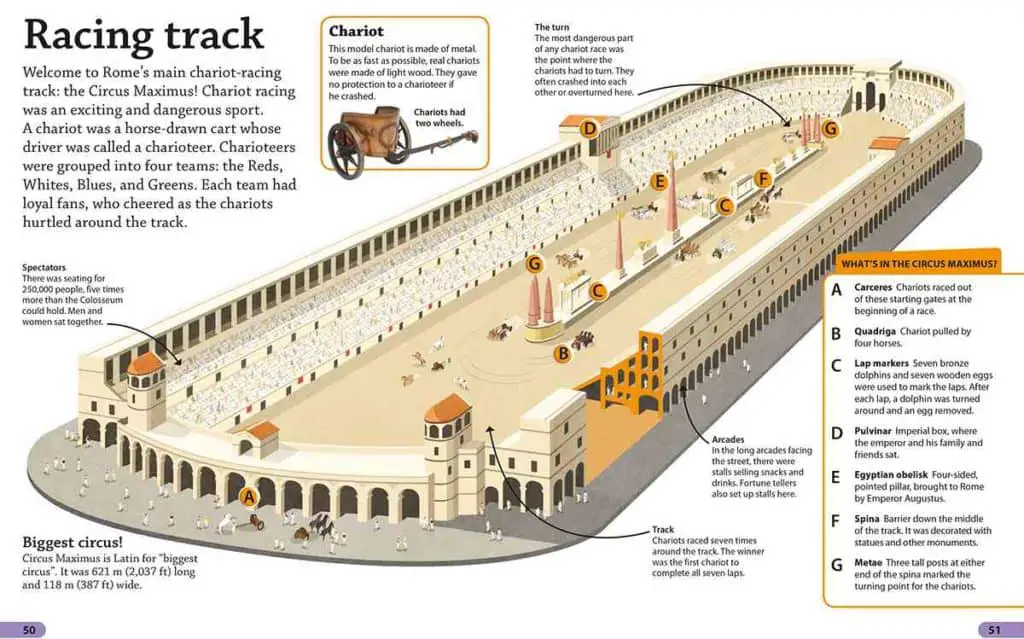
Other Attractions in Italy
- Visit the Roman Colosseum. Click on the Roman Colosseum attractions map HERE and accompanying Colosseum attractions guide HERE
- Take the Rome attractions map and self guided tour: It includes the Vatican City attractions map HERE and the Vatican attractions guide HERE
- Self Guided Walking tour to explore the neighborhood of Trastevere with map of attractions HERE and guide of attractions HERE
- Visit St Peters Basilica . Explore all the attractions in St Peter’s Basilica with the attractions guide HERE
- One of my favorite places is the Roman Forum and Palatine Hill . The map of attractions is HERE and the self guided walking tour is HERE
- Visit Pompeii with a complete self guided tour map HERE and the attractions guide to the 49 points of interest HERE
- Spend the day in Florence , this was by far one of my best day trips. The self guided walking tour map is HERE and the attractions guide is HERE
Related Posts

Flight delay compensation, claim up to €600 in cash
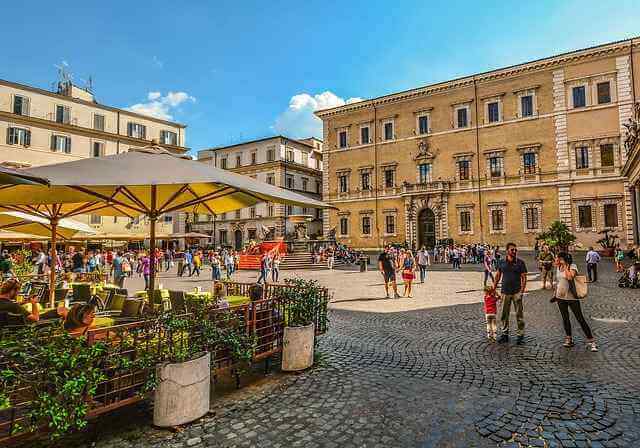
Delightful Trastevere, Self Guided Walking Tour of Trastevere Rome
This website uses cookies to improve your browsing experience and analyze the use of the website. Learn More

Roman Forum Walking Tour with Map

This post is a self-guided tour of the Forum in Rome as well as the adjacent Imperial Fori.
The tour should take approximately 1 hour or just a bit less than that. The walk is approximately 1 km (just over 1/2 a mile).
This walk is an abridged version of our Ancient Rome audio tour. Listen to a sample of the tour.
There is no schedule (take our tours anytime you wish). We also have an audio tour of Central Rome.
- Purchase this audio tour from our Booking Page (scroll down to Rome)($2.99/download).
- You’ll receive a confirmation email with a .pdf, Google Map link, and audio tour.
- Enjoy the tour(s).
There are also free guided walks that usually take place multiple times each day as well as tours that cover Central Rome, Vatican City, and the Colosseum.
Searching Availability...
The tour begins from Capitoline Hill ( map ). It is within walking distance of many historic Rome sites.
Click on the map to enlarge it or to download it to a smartphone.
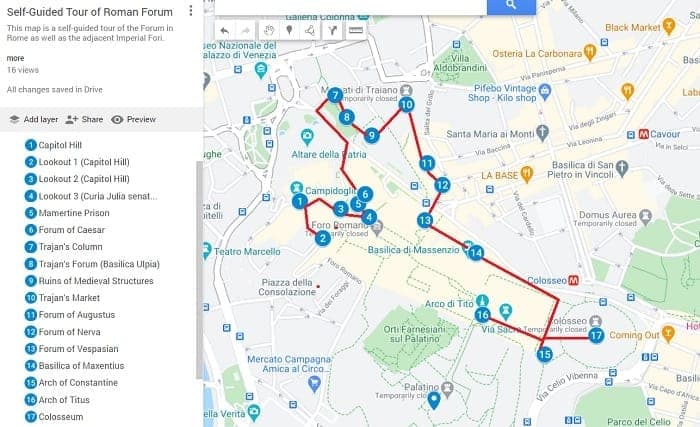
We have 4 other self-guided tours that we hope you will consider.
- Rome's City Centre
- Vatican City + St. Peter's Basilica
- Jewish Ghetto

Capitoline Hill/Piazza del Campidoglio
This location is filled with historic sites, including Piazza del Campidoglio itself, which was actually designed by Michelangelo.
Originally, this was one of the seven hills upon which Rome was built, and it was the center of civic life in the city for many years.

Today, the hill is home to many notable sites including the Palazzo dei Conservatori, the Palazzo Senatorio, the Capitoline Museums , and the Basilica di Santa Maria in Ara coeli.
There are also a few notable sculptures and fountains in the area, including Lupa Capitolina and Fontana della Dea Roma.
Overlook of the Roman Forum
You’ll find this overlook past Palazzo Senatorio, to the right, and past the arch on Via del Campidoglio.
This is one of the best places to get a good view of the Roman Forum, with several great examples of architecture that relied heavily upon the use of white marble and columns.
The Roman Forum was the first fora in this area, and during the era of the Republic, it was the only centre for civic life in Rome.
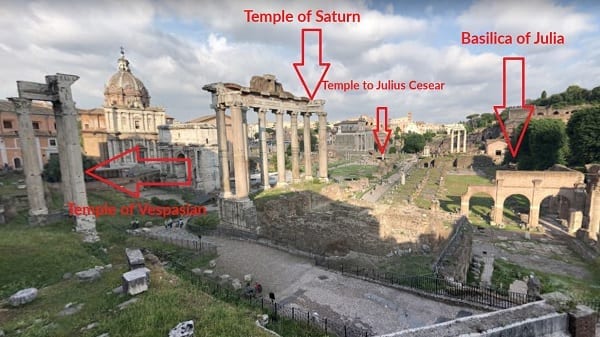
If you look directly ahead from the direction in which you came, you’ll see three columns that are remnants of the Temple of Castor and Pollux.
To the left of this site, you’ll find the Temple of Saturn represented by its eight remaining columns.
This was built shortly after the Temple of Jupiter, which makes it the second-oldest remaining temple from the Republic era.
You’ll find The Temple of Vespia right next to the Temple of Saturn.
Between the Temple of Saturn and the Temple of Castor and Pollux, you’ll also see the Temple of Antoninus and Faustina.
To the right of this site is the Temple of Julius Caesar.
Second Overlook of the Roman Forum
To reach this location from the last overlook, head back to Piazza del Campidoglio and turn right. D
Once you pass the palace, turn right again on Via di San Pietro in Carcere. The overlook is straight ahead and down the stairs.
On the far right, you’ll see the back of Palazzo Senatorio.
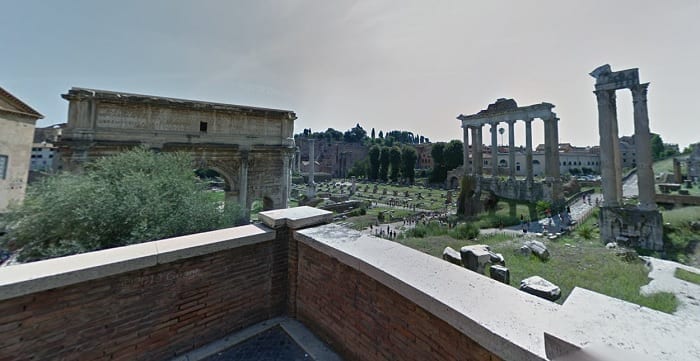
This part of the building was constructed over the old Temple of Veiovis, and it was used for the Tabularium (records office).
From the base of the wall here, you’ll see a few small ruins from the Temple of Concordia, a location that was once used for Senate meetings.
The irony is that Concordia was the goddess of harmony, and not every meeting which took place here was harmonious.

After all, this is where Cicero gave the last of many speeches that condemned a fellow senator’s plot to overthrow the Roman government, which resulted in his opponent receiving the death penalty.
On the left, you’ll see the remains of the Rostrum, a speaking platform that was used for public addresses.
You’ll find the Arch of Septimius Severus next to this landmark.
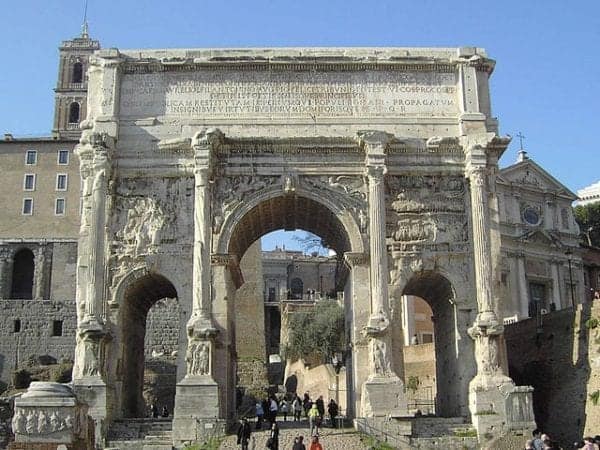
This is just one of many triumphal arches which commemorate the victories of famous Roman leaders, each part of a processional route used during Roman triumphs. We’ll be visiting a few more on this tour.
The next overlook is on the corner beside the Arch of Septimius Severus.

Overlook of Palatine Hill
If you look beyond the Roman Forum from here, you’ll see a hilltop in the distance, Palatine Hill.
This is the site where Romulus is said to have founded the city of Rome.
Archaeology indicates that three millennia of people have lived in this area, which makes it one of the oldest and most historic locations in all of Rome.
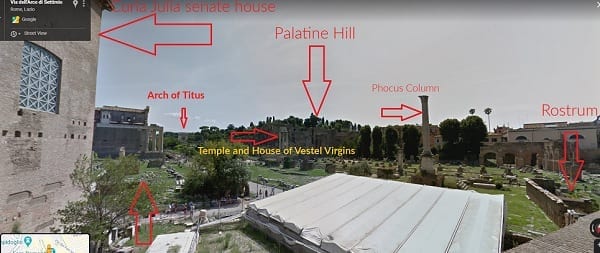
To give you a sense of just how much history is here, even ancient Romans would have looked at this location as a remnant of times that had long since passed.
In modern times, this is the site of both an outdoor and indoor museum that houses archaeological finds from the area. Tickets are included with admission to the Colosseum.
The buildings on Palatine Hill are surprisingly better preserved than those you’ve seen in the Roman Forum.
Mamertine Prison
Located just east of Piazza del Campidoglio, this historic site was once used as a prison, and it’s perhaps best known as the place where Vercingetorix was once held.
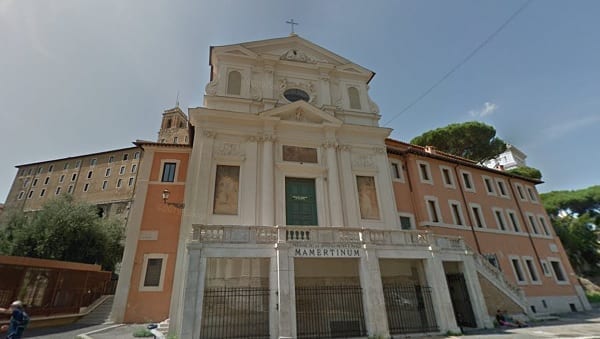
Although most prisoners here were given swift punishment, Vercingetorix underwent a sentence that lasted many years as a result of the civil war following Caesar’s return to Rome.
It is also said that Christian saints Peter and Paul may have been held here, and there is an inscription describing them above the word “Mamertinum.”
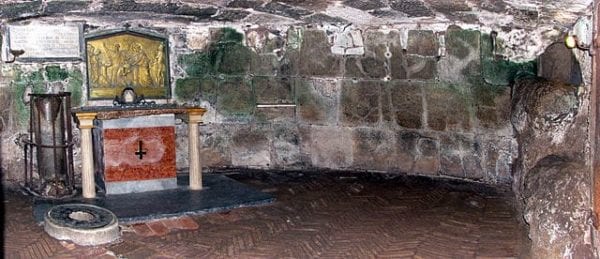
Today, there is an altar to Peter and Paul in this former prison.
Forum of Caesar
As the name implies, this forum was designed by Julius Caesar, and it was just one of many things he designed in the Roman Forum.
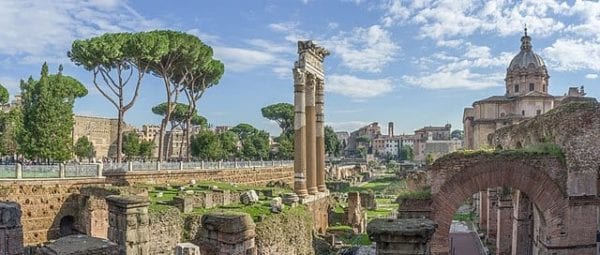
View of the Forum of Ceasar looking toward the Colosseum
The Forum of Caesar itself is a long, narrow, rectangular stone space that had previously been used for residential real estate.
Much like Roman Forum, this location was used to combine a bunch of different services that brought people together including a temple, shops, offices, and an open meeting place to talk.
This forum was intended to provide additional space for public activities, as the Roman Forum was becoming more crowded and the city needed more room for its growing population.
Trajan’s Column
Built in 113 CE, this column was named after Emperor Trajan, and it is dedicated to his victory in the war against the Dacians.
If you look closely, you can see depictions of the war engraved on this structure.
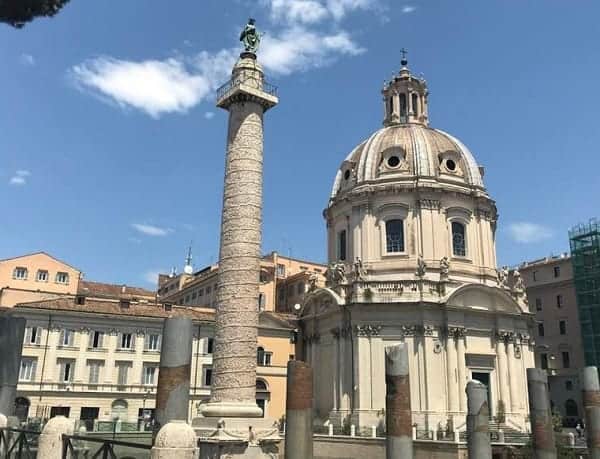
Trajan’s Column was built hollow with a spiral staircase leading to the top.
At almost 40 meters tall, this landmark is about as high as the hillside that they removed to make space for it!
Although the story of the war depicted along its walls is difficult to follow now as it spirals up the entire length, there were once two libraries flanking the column which had viewing platforms where you could see the engravings.
The statue on top was once of Emperor Trajan himself, but it was replaced with a statue of St. Peter many decades ago.
Forum of Trajan
The Trajan Column is just one small part of the greater Forum of Trajan which also contained the two libraries alongside the structure.
This location was also home to Basilica Ulpia, which was the largest church in Rome when it was built.
Just past the church is a 100-metre long public area with porticoes along its edges.
The entire area was given a marble floor and an equestrian statue of Trajan was placed in the center.
The excavation of this area isn’t as complete as other parts of the city.
But, it is thanks to Benito Mussolini that we can even see what we have today, as he was the mastermind behind the excavation of Trajan’s Forum.
Trajan’s Market
This marketplace was actually built into the hillside to keep it from falling, and it has been useful ever since it was originally constructed.
Over the years, Trajan’s Market was used to house both offices of government and commercial shops.
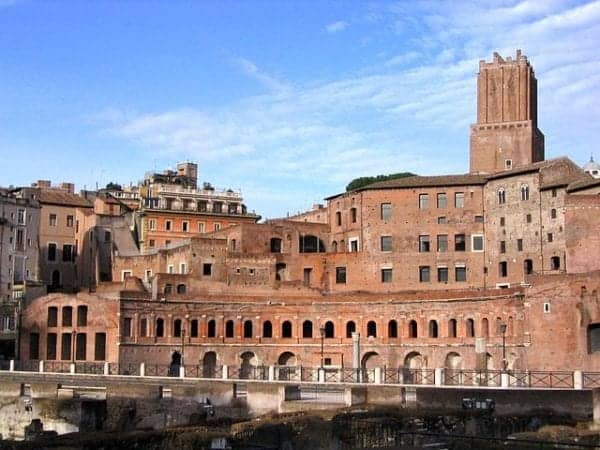
This may have been where ancient Romans picked up the government-supplied grain.
Due to the fact that it’s still in good shape, this is now the site of the Museum of the Imperial Fora, which is full of relics discovered during the excavation of all nearby forums.
Tickets to the museum are usually €11.50, but if they are hosting a special exhibit, you may have to pay €14 for admission which includes that attraction.
Forum of Augustus
When this location was originally designed, it included a colossus of Augustus and a Temple of Mars Ultor.
Pieces of both sites remain, but the artifacts from the colossus are now located at Trajan’s Market.
Sadly, much of this forum has been destroyed or built over, so there isn’t much to see here anymore.
That said, you can still see the back wall of the forum and three columns from its Temple of Mars Ultor.
Like all the other forums in the area, this location was used for civic functions and it was a public site where people could meet and conduct business.
Forum of Nerva
Named after Emperor Nerva, this forum was originally intended for his predecessor Domitian, but work on the structure was only completed after he left office, so Nerva ended up taking the credit.
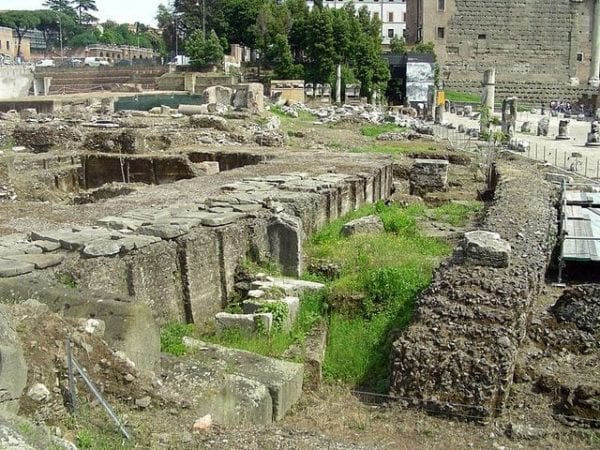
Although that might not seem fair, it’s perhaps fitting that this is one of the smaller forums in the area, and that’s because three other emperors already had similar sites built nearby before this one was finished.
Even though it’s technically known as the Forum of Nerva, Domitian’s influences can be seen here, as the temple in this area is devoted to Minerva -- Domitian’s protector goddess.
Since it was so narrow, this forum was used mostly as a road during the middle ages.
The newer road in this area covers most of the forum, preventing excavation teams from digging it up.
Forum of Vespasian/Temple of Peace
This entire site is actually the Temple of Peace, which was finished in 75 CE.
However, it has become known as the Forum of Vespasian over the years thanks to its enormous size which was similar to that of a forum.
Originally, the Temple of Peace was built to commemorate the victory of Titus and Vespasian in Judea.
Unlike an actual forum, the floor of this temple was earthen. However, there were long fountains along the sides of the courtyard which was bordered by rose gardens.
In addition to serving as a temple, this area was also used as a civic space with libraries, a medical school, and even a museum once found in the complex.
Today, the Temple of Peace houses parts of a huge marble map of the city as it existed in the early 200s CE.
Basilica of Maxentius
When this church was built, it took over the Basilica Ulpia as the largest basilica in all of Rome.
The full name of this location is actually the Basilica of Maxentius and Constantine.
These two emperors were once enemies on either side of a civil war, and they were two of the most important leaders of their time.
Constantine eventually beat Maxentius in 312 and finished the construction of this church, which was initially being built for Maxentius. As a result, the basilica is dedicated to both men.
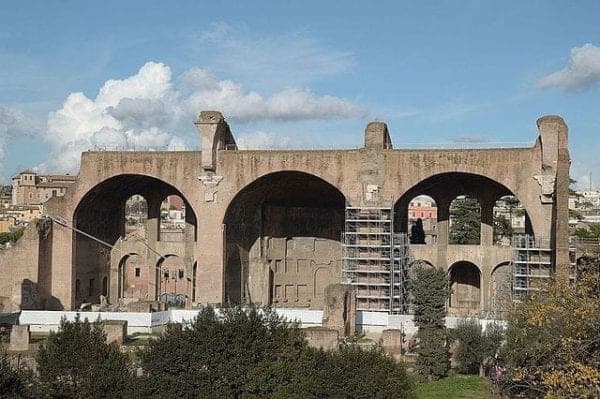
The Basilica of Maxentius and Constantine put the construction technology and knowledge of the Romans to the test.
Initially, it housed a colossus statue of Constantine, and there are a few pieces of this structure remaining in the Capitoline Museums.
Arch of Constantine
This arch commemorates Constantine’s victory over Maxentius in 312.
Although it was the largest of Rome’s triumphal arches, its statues and reliefs were taken mostly from other monuments in the city.

Both sides of the arch have statues made in the era of Trajan and medallions made in the era of Hadrian.
The reliefs do depict the events of his war with Maxentius, but the level of detail put into the artwork was nowhere near the same quality as you would expect from most earlier works in Rome.
Arch of Titus
Much like the Temple of Peace, this arch was also built to commemorate the victory of Titus and Vespasian in Judea.
The arch depicts scenes from this victory, including the theft of a menorah which would eventually be displayed in the Temple of Peace.
Unfortunately, the events depicted are also part of a long history of mistreatment of the Jewish people which resulted in the Diaspora.
For many centuries, Rome’s Jewish population would be subject to various taxes, forced to worship at Christian churches, and confined to the location known as the Jewish Ghetto.
If you’re interested in learning more about this area, consider taking out the Jewish Ghetto self-guided tour .
The Colosseum
Named after the colossus of Nero which once existed here, this location was originally known as the Flavian Amphitheatre, named after the Flavian dynasty of Vespasian, Titus, and Domitian.
This was the largest arena in the world at the time it was built, and it is one of the seven wonders of the world.
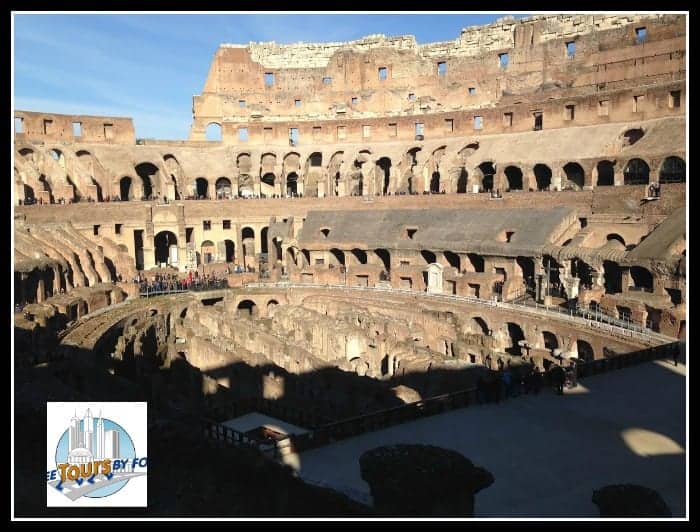
Although only a third of the original structure still remains, it’s still quite impressive to this day.
The Colosseum was used for multiple events including gladiatorial combat, naval battles, and more.
Today, you can purchase tickets to enter the Colosseum and get a good look at its interior. Tickets also include admission to the Roman Forum and Palatine Hill.
To learn more, check our post about visiting the Colosseum .
Choose a Destination... I want them all PLUS general travel tips. Amsterdam Berlin Boston Charleston Chicago Dubai Lisbon London Los Angeles Miami Nashville New York City New Orleans Paris Philadelphia Prague Rome San Francisco Washington DC
About The Author

Stephen Pickhardt
North america, united kingdom & ireland, middle east & india, asia & oceania.

Colosseum Underground Tours

Choose the best Colosseum guided tour

Skip The Line Colosseum Underground Night Tour VIP Experience

Experience the Colosseum at night, exploring its underground and arena floor away from crowds. Led by experts, discover gladiatorial battle sites, hidden tunnels, and ancient engineering. Immerse in the history of Roman Empire games and events.
- Skip the line access to the Colosseum
- Access to Colosseum Underground area
- Live guide in English and/or Italian
Best price:

Colosseum, Underground & Arena Floor Guided Tour
890+ reviews
Dig into the Colosseum’s dungeons and the wild animals' holding areas, complete with remains of ancient elevators and trapdoors. Enjoy breathtaking 360º views from the arena, exclusive access to the Colosseum's underground, and single entrance tickets to the Roman Forum and Palatine Hill, all while benefiting from headsets for clear guidance.
- Skip-the-line tickets to the Colosseum, Roman Forum and Palatine Hill
- Headsets to better hear your guide
- Access to Colosseum Arena and Underground areas
- Live guide in English

Colosseum Underground, Arena Floor and Ancient Rome guided tour
2 900+ reviews
Delve deep in the history of ancient Rome with a guided visit to the Colosseum, its world-famous arena where gladiators fought to the death and the hypogeum, the underground ‘backstage’ network of tunnels and chambers. Continue your journey through time with a tour of the Roman Forum and Palatine Hill.
- Priority tickets to the Colosseum, Roman Forum and Palatine Hill

Guided Tour of the Colosseum Underground with Roman Forum & Gladiator Arena
4 200+ reviews
Explore the Roman Colosseum with an exclusive skip-the-line underground tour, including special access to the Gladiator Arena, Roman Forum, and Palatine Hill over 2.5-3 hours. Enjoy the company of an expert guide with many gladiator tales to share!
- Live guide in English, Italian, German, Spanish or French

Private Colosseum Tour with Arena and Underground
40+ reviews
Explore the Colosseum's underground and arena floor, marvel at the Roman Forum's ruins, and enjoy skip-the-line access with a private guide on this tour from your central Rome hotel, offering a deep dive into ancient history.
- Hotel pickup in private vehicle
- Live guide in German, English, Italian, French or Spanish
Visiting the Underground of the Colosseum
Colosseum’s underground guided tour benefits.
Booking a guided tour of the Colosseum's underground provides visitors with exclusive access to areas normally restricted to the general public as well as a rich historical context that elevates the experience beyond a simple walkthrough. Knowledgeable guides, often with a background in history or archaeology, narrate the compelling stories of what unfolded in these ancient spaces.
Accessibility at the Colosseum’s Underground
The underground levels are not wheelchair accessible due to their structure including stairs and steps. Those with mobility impairments should contact the tour operator before booking to discuss if accommodations can be made.

Exclusive Colosseum Underground Areas
The underground circuit of the Colosseum reveals the dungeons where animals and gladiators awaited their fate, and the complex tunnels where intricate machinery once hoisted them into the arena floor.
The exclusive itinerary of an Underground Colosseum guided tour often includes access through the Gladiator's Gate, a dramatic entrance leading directly to the arena, where combatants once entered to roaring crowds. Visitors will also see the remnants of the elevator systems, a testament to Roman engineering prowess. Additionally, some tours offer the rare chance to stand at the Gate of Death, the exit through which the fallen were carried away.
The depth of detail provided by the expert guide makes it clear why this access is such a privilege, while the panoramic views from various vantage points forge an indelible connection with ancient Rome.
FAQs and tips
- Vacation Rentals
- Restaurants
- Things to do
- Things to Do
- Travel Stories
- Rental Cars
- Add a Place
- Travel Forum
- Travelers' Choice
- Help Center
Rome Italy- Guided Tour or not? - Outdoors / Adventure Travel Forum
- Tripadvisor Forums
- Outdoors / Adventure Travel Forums
Rome Italy- Guided Tour or not?
- United States Forums
- Europe Forums
- Canada Forums
- Asia Forums
- Central America Forums
- Africa Forums
- Caribbean Forums
- Mexico Forums
- South Pacific Forums
- South America Forums
- Middle East Forums
- Honeymoons and Romance
- Business Travel
- Train Travel
- Traveling With Disabilities
- Tripadvisor Support
- Solo Travel
- Bargain Travel
- Timeshares / Vacation Rentals
- Outdoors / Adventure Travel forum

I will be in Rome in May 2025. I want to visit the Colosseum. Should I do a guided tour for the best experience or will a self purchase ticket give me the same perks?
5 replies to this topic

Welcome to the Tripadvisor forums
When we went we just bought an entry and Audio Headset tour on our own, not a guided tour...
However, guided tours usually include alot of extra information about a topic ....
Sooo, really up to you and your level of interest in the attraction....And IF you want to hand over the extra cost for a guide
You can read the Reviews of the Colosseum lve linked for you below to see what other members have said about it
https://www.tripadvisor.ca/Attraction_Review-g187791-d192285-Reviews-Colosseum-Rome_Lazio.html
And you might ask your question about the Colosseum directly on Tripadvisors actual dedicated Romr forum, which is where the other members who live locally and know Rome well l, and the destination experts for Rome, give travel advice daily
Heres a link for you to the ROME Destination Forum...
https://www.tripadvisor.ca/ShowForum-g187791-i22-Rome_Lazio.html
It will come in handy for your trip planning
You can ask the local members anything travel related about your upcoming trip...
Theyre the best source here on this website
Will do, thank you 😊
Youre welcome!
- 10 historical sites in Mongolia 5:07 am
- Top 10 attractions in East Timor 5:06 am
- Top 10 attractions and museums in Vietnam 5:04 am
- Top 10 Safari Destinations in Uganda 5:03 am
- 8 safest tourist destinations in Uganda 5:00 am
- Top 10 Most Beautiful Beaches in Mozambique 4:58 am
- 8 Safest Tourist Destinations in Botswana 4:57 am
- 10 outdoor attractions not to be missed in Botswana 4:55 am
- Why is Panama a tourist destination? 4:53 am
- When is rainy season in peru machu picchu? 4:50 am
- Hiking yesterday
- Mt ranier Jun 05, 2024
- Rome Italy- Guided Tour or not? Jun 04, 2024
- Barcelona family adventure location Jun 02, 2024
- 10 Amazing Australian Hikes!
- Safari Destinations
- Trip Reports: Adventure: Send them in!

I've been a tour guide in Rome for 16 years. Here are 5 tourist attractions that are worth it and 5 you can skip.
Posted: May 28, 2024 | Last updated: May 28, 2024
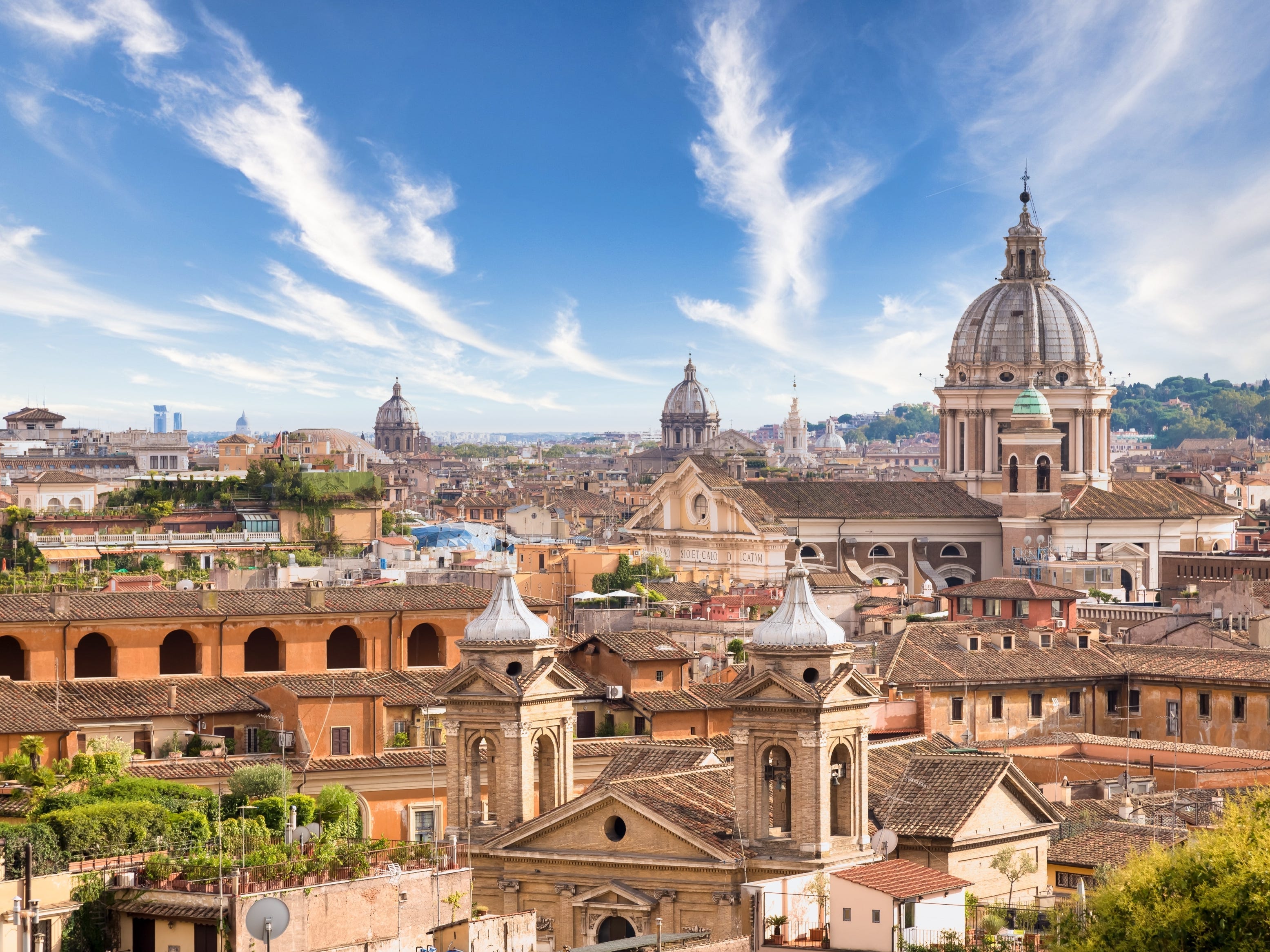
- After 16 years of working as a tour guide in Rome , I've figured out the best attractions.
- I always recommend visiting the Park of the Aqueducts and the Ostia Antica archeological site.
- But I think the Colosseum, Trevi Fountain, and Mouth of Truth attractions are overcrowded.
Rome is pretty crowded — the city welcomed a record-breaking 35 million tourists in 2023. Any gorgeous photos you see of breathtaking and empty piazzas were likely taken long before most people have woken up.
As a seasoned Roman tour guide for the past 16 years, I would never say certain attractions have no merit. But after years of interacting with travelers , I understand that people want alternatives.
Luckily, Rome has priceless art and artifacts around every corner.
Here are five popular attractions that are worth visiting, and five you might want to skip.
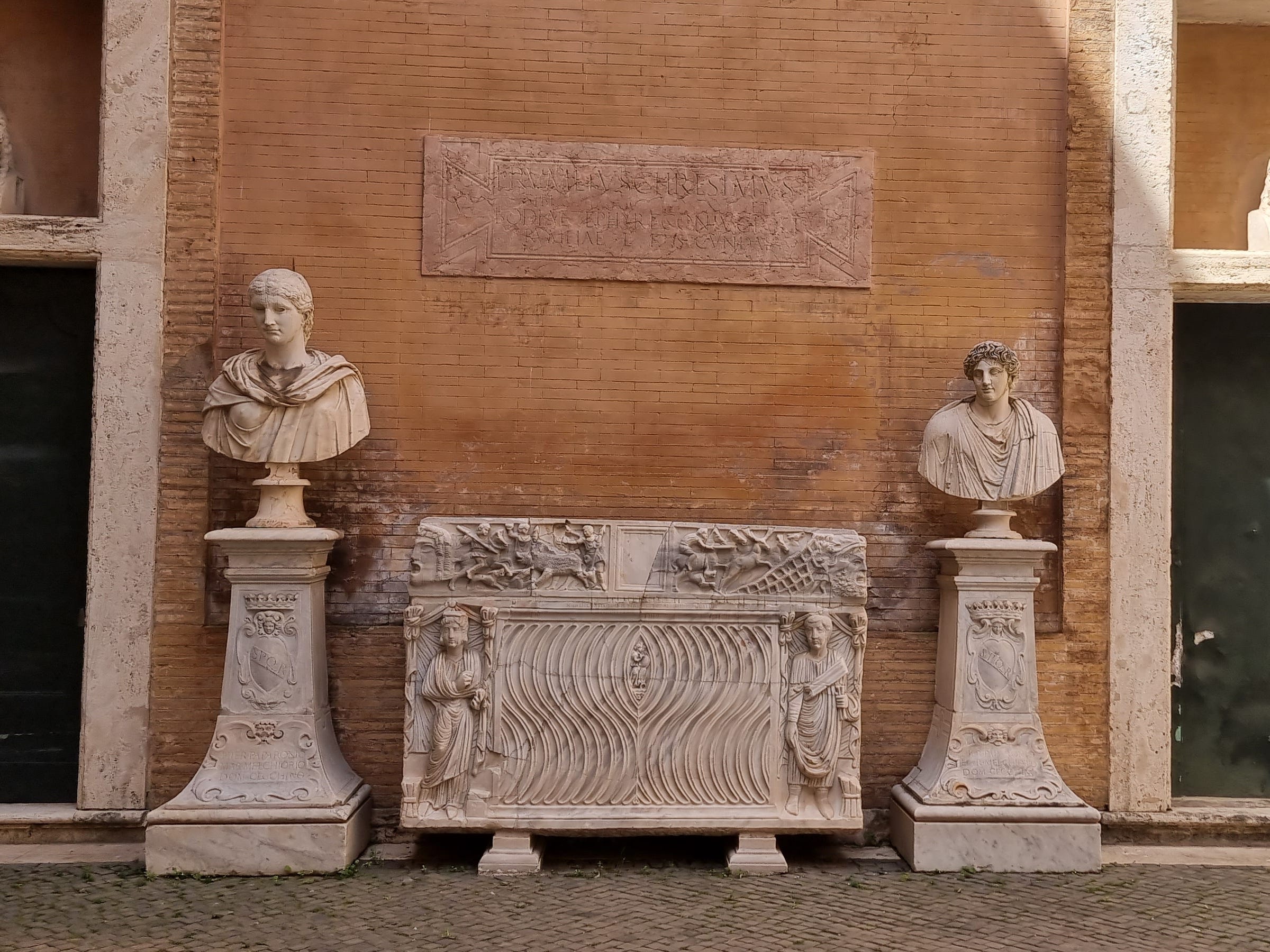
The Capitoline Museums offer plenty of art and archeological finds.
Located on Capitoline Hill, the Capitoline Museums offer a treasure trove of ancient Roman art and artifacts.
Despite their historical significance as some of the oldest public museums in the world , they're often overlooked by tourists.
The well-curated collections include masterpieces by renowned artists like Michelangelo and Caravaggio, ancient bronzes, and frescoes. It's a must-visit for any art enthusiast seeking a quieter, more intimate experience.
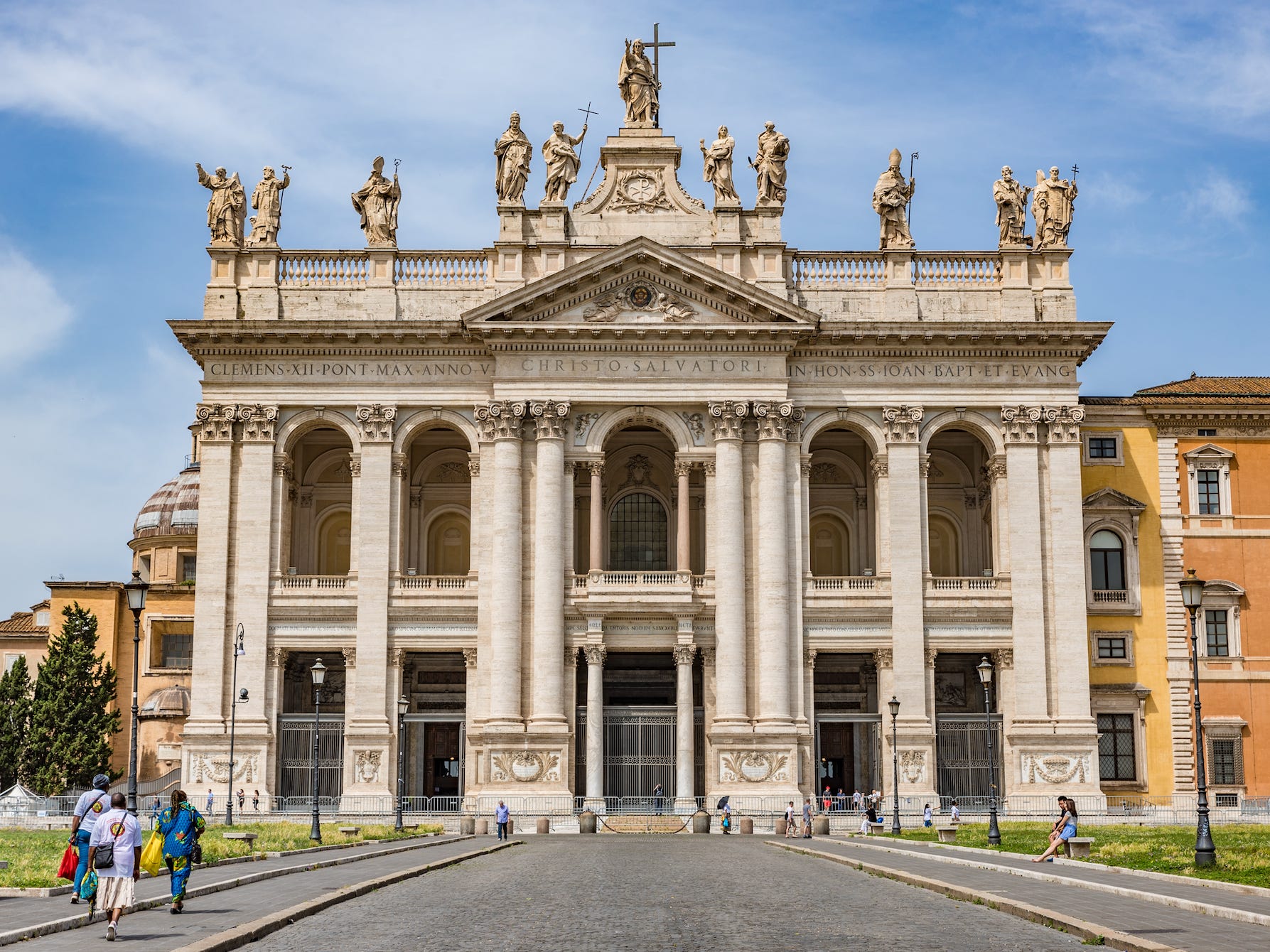
Don't miss the Basilica di San Giovanni in Laterano.
As one of Rome's four major basilicas, San Giovanni in Laterano (also known as the Archbasilica of St. John Lateran) boasts a stunning display of baroque architecture and intricate frescoes.
It may not be as famous as some of Rome's other churches, but its grandeur and historical importance as the oldest papal basilica in the city make it a hidden gem worth exploring.
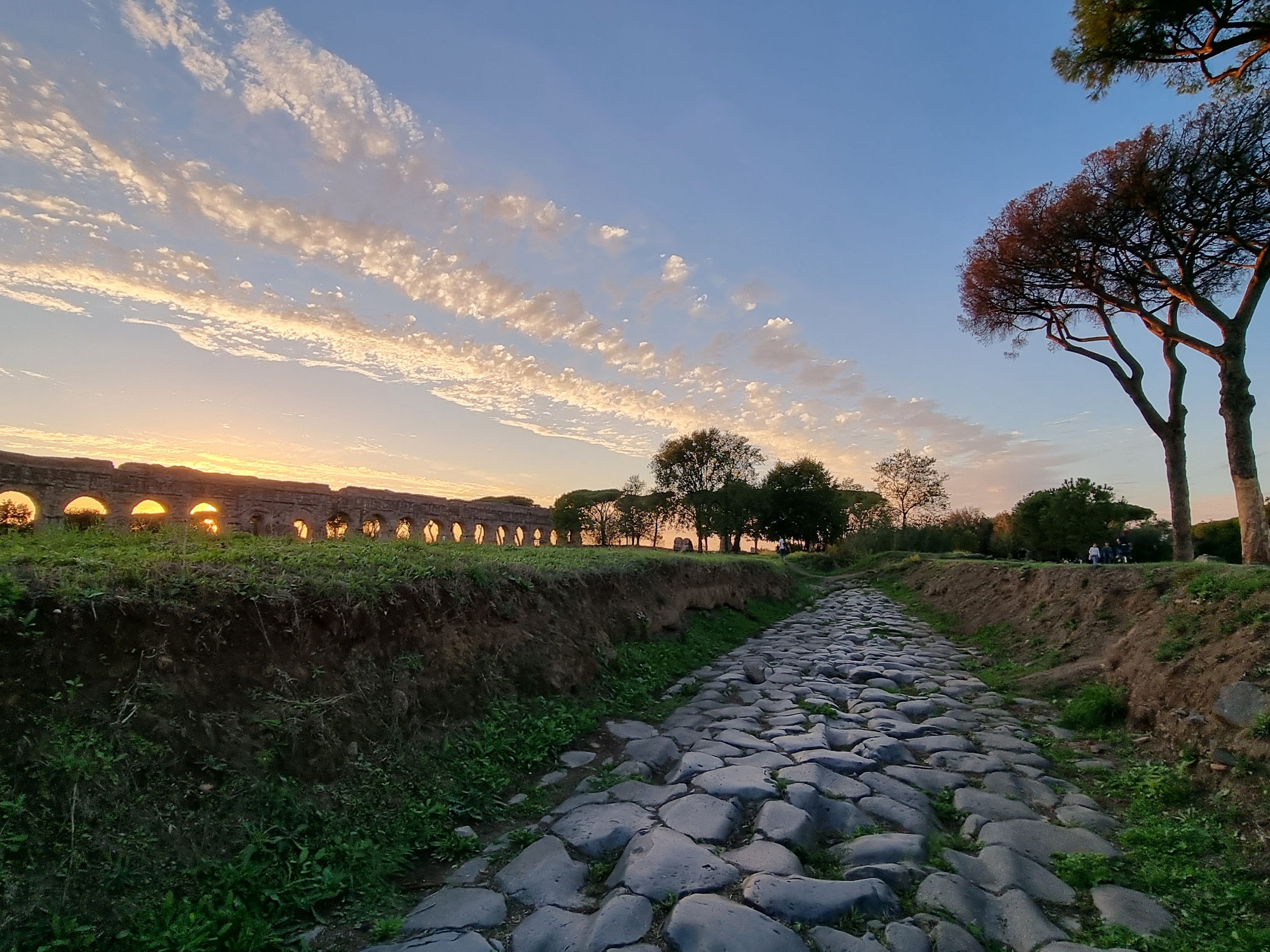
The Park of the Aqueducts is beautiful and full of history.
Escape the crowds and stagnant air of the city center and venture into a tranquil Park of the Aqueducts (Parco degli Acquedotti).
Here, you'll see towering arches of 11 aqueducts that once carried water to the heart of ancient Rome. It's a perfect spot for a leisurely stroll on the ancient Latin Road or a picnic away from the crowds.
The attraction also offers a unique perspective on the ingenuity of Roman engineering.
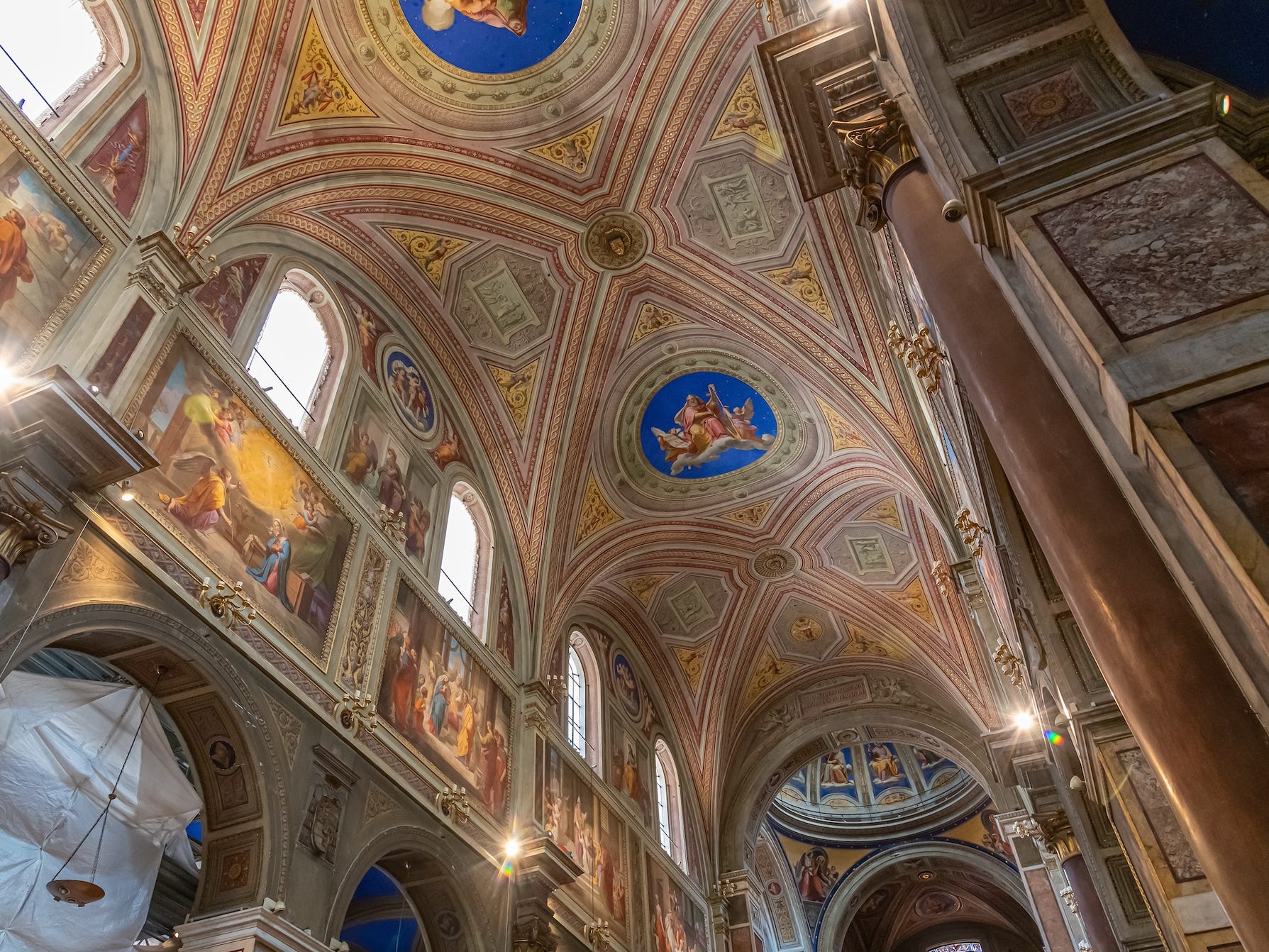
There's incredible art in the Basilica of Sant’Agostino.
Art lovers shouldn't miss the exquisite "Madonna dei Pellegrini" housed within the Cavalletti Chapel at Basilica di Sant'Agostino in Campo Marzio.
The dramatic interplay of light and shadow in Caravaggio's painting comes alive in the serene church, providing a captivating glimpse into the artist's unparalleled talent and revolutionary style.
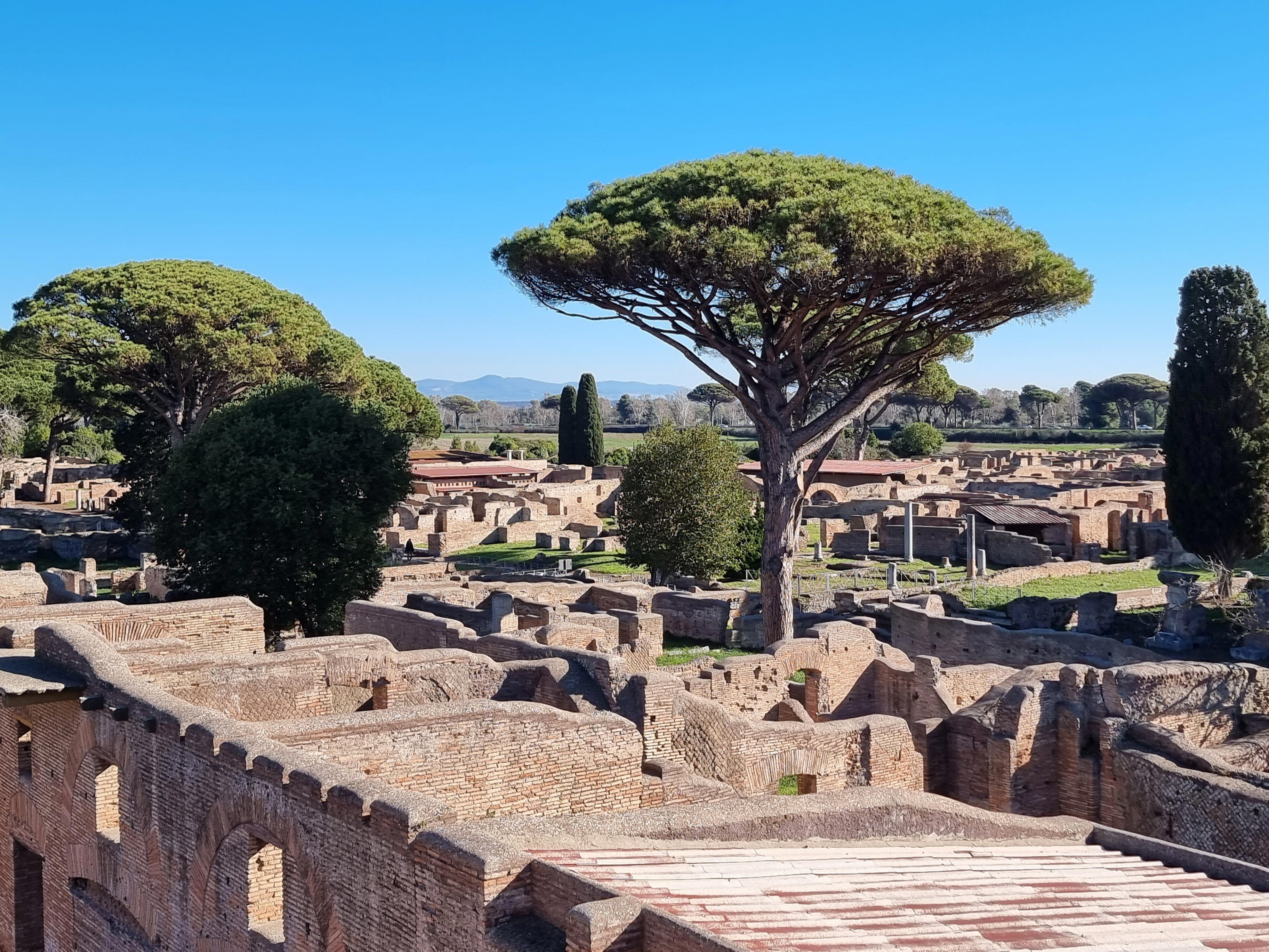
A Roman vacation isn't complete without a trip to Ostia Antica.
Step back in time and explore the remarkably well-preserved ruins of Ostia Antica, Rome's ancient seaport.
The archaeological site offers a quieter and less time-consuming alternative to the crowds of Pompeii a little farther south. Visitors can wander through ancient streets, houses, and Roman theaters in a more peaceful setting than the Roman Forum.
Plus, you can enjoy a seafood lunch overlooking the Tyrrhenian Sea after your visit .
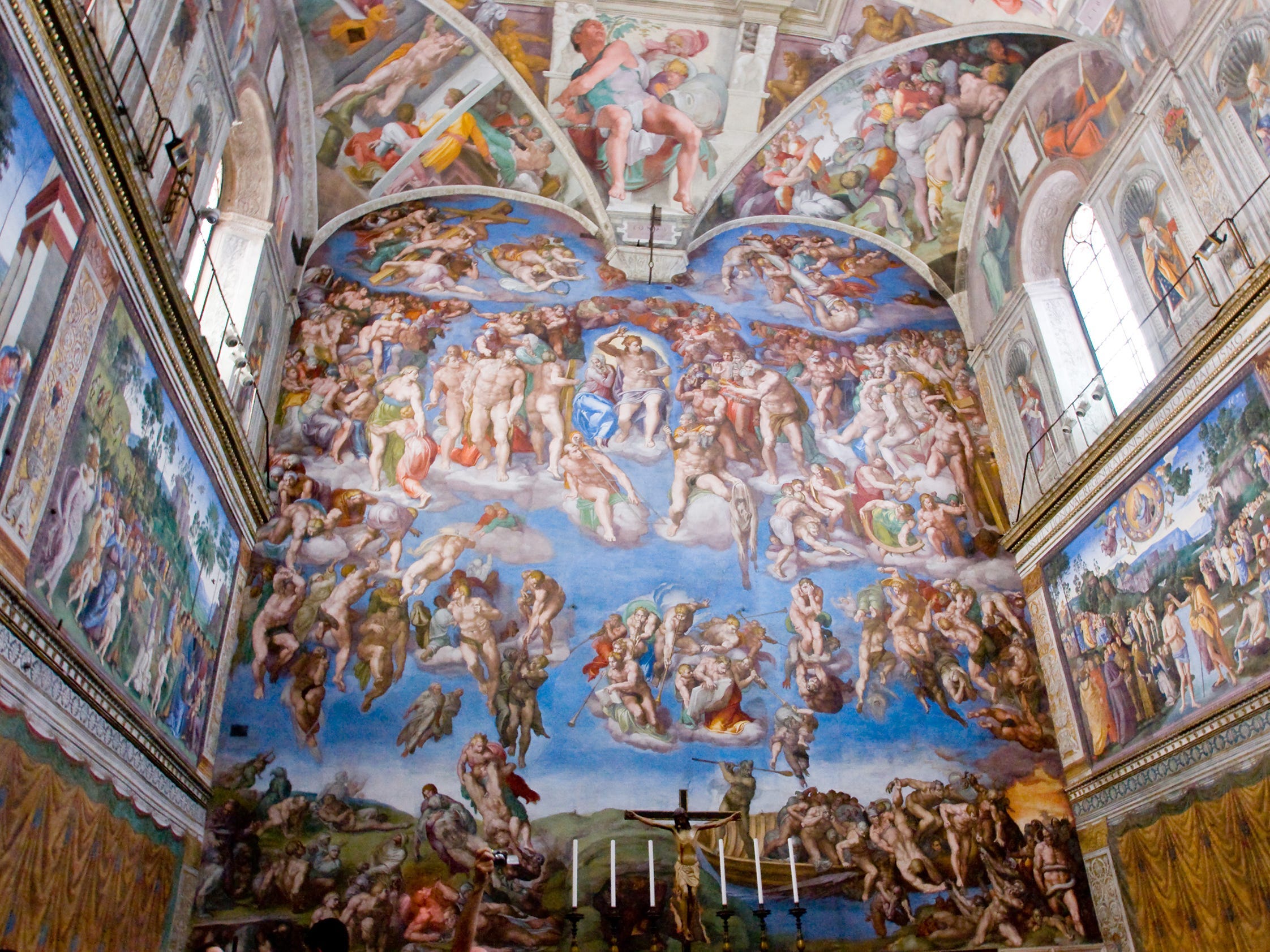
On the other hand, the Vatican Museums are overcrowded.
Although the Vatican Museums are undeniably home to some of the world's most renowned art collections, they're almost always swarming with tourists.
The crowds and long queues can detract from your overall experience. In peak season , the Vatican easily sees 20,000 to 30,000 visitors a day.
It's virtually impossible to admire the art as you're shuttled through each gallery until everyone spills into the Sistine Chapel . Even the bathroom lines can be a 30-minute wait.
Unless you are willing to spend a lot of money on an official tour before the museums are open to the public or visit in the offseason , you should consider alternative attractions.

You can get a good view of the Colosseum without going inside.
As iconic as it may be, the Colosseum can be overwhelming, particularly during peak tourist seasons .
Its historical significance is undeniable, but exploring the ancient amphitheater can be a challenge among the swarms of visitors.
Acquiring tickets is also tricky. We often have to time our online purchases perfectly, refreshing the page in 10-minute intervals. Tickets sell out quickly and are sometimes resold by large companies.
Consider alternative viewpoints or guided tours for a more personalized experience. I also like taking in the exterior around 9 a.m. or in the evening when it lights up.
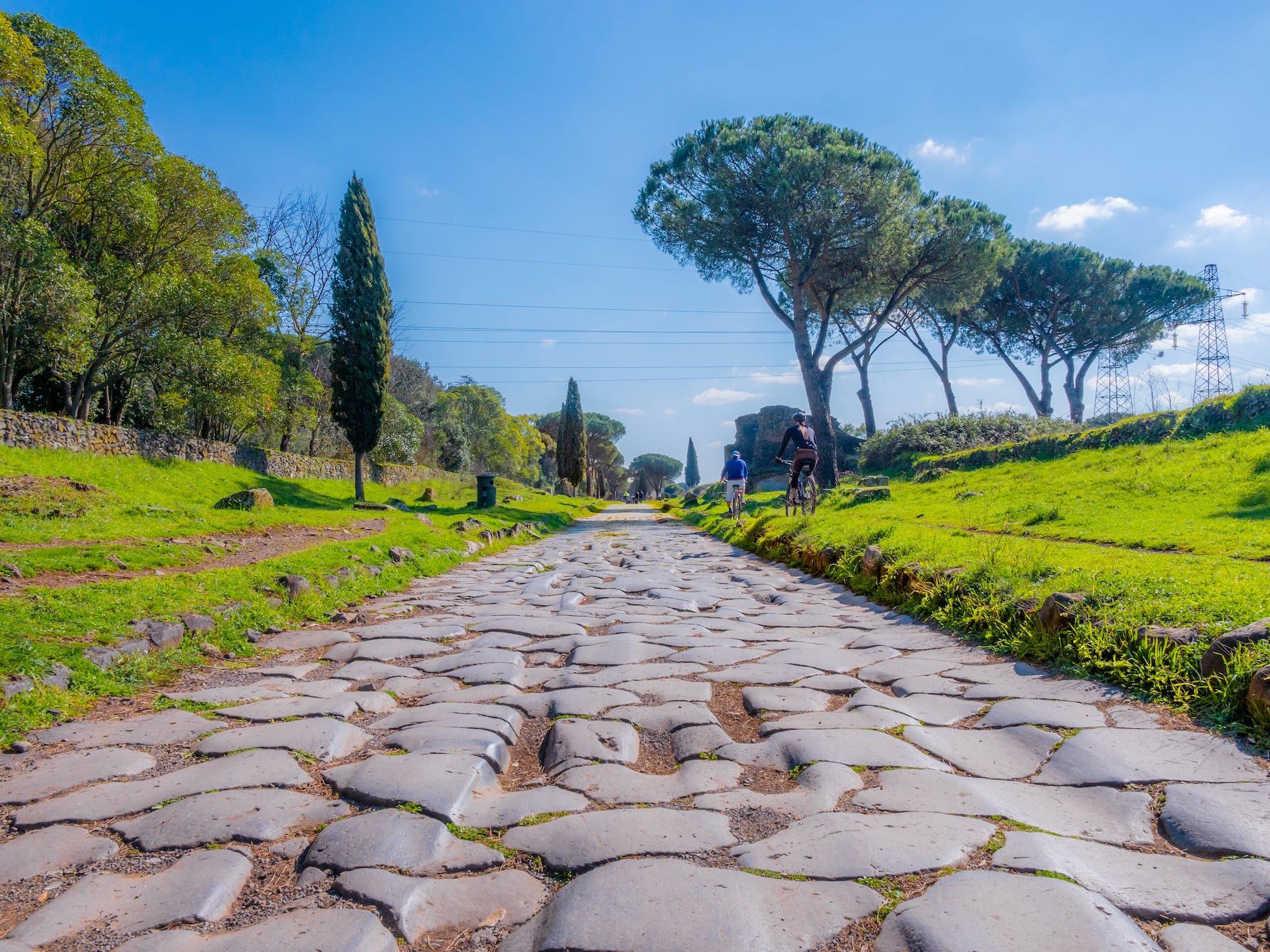
Walking the Appian Way might be a letdown.
The Appian Way is significant in Roman history as the oldest and most important road. But its appeal may be lost on the average tourist.
Nowadays, there are loads of bike and bus tours to the Catacombs along the road — making it crowded — and public transport there is difficult.
I suggest visiting the Park of the Aqueducts instead. It's an easy metro ride from Termini Station and offers a glimpse into what the Roman countryside would've been like.
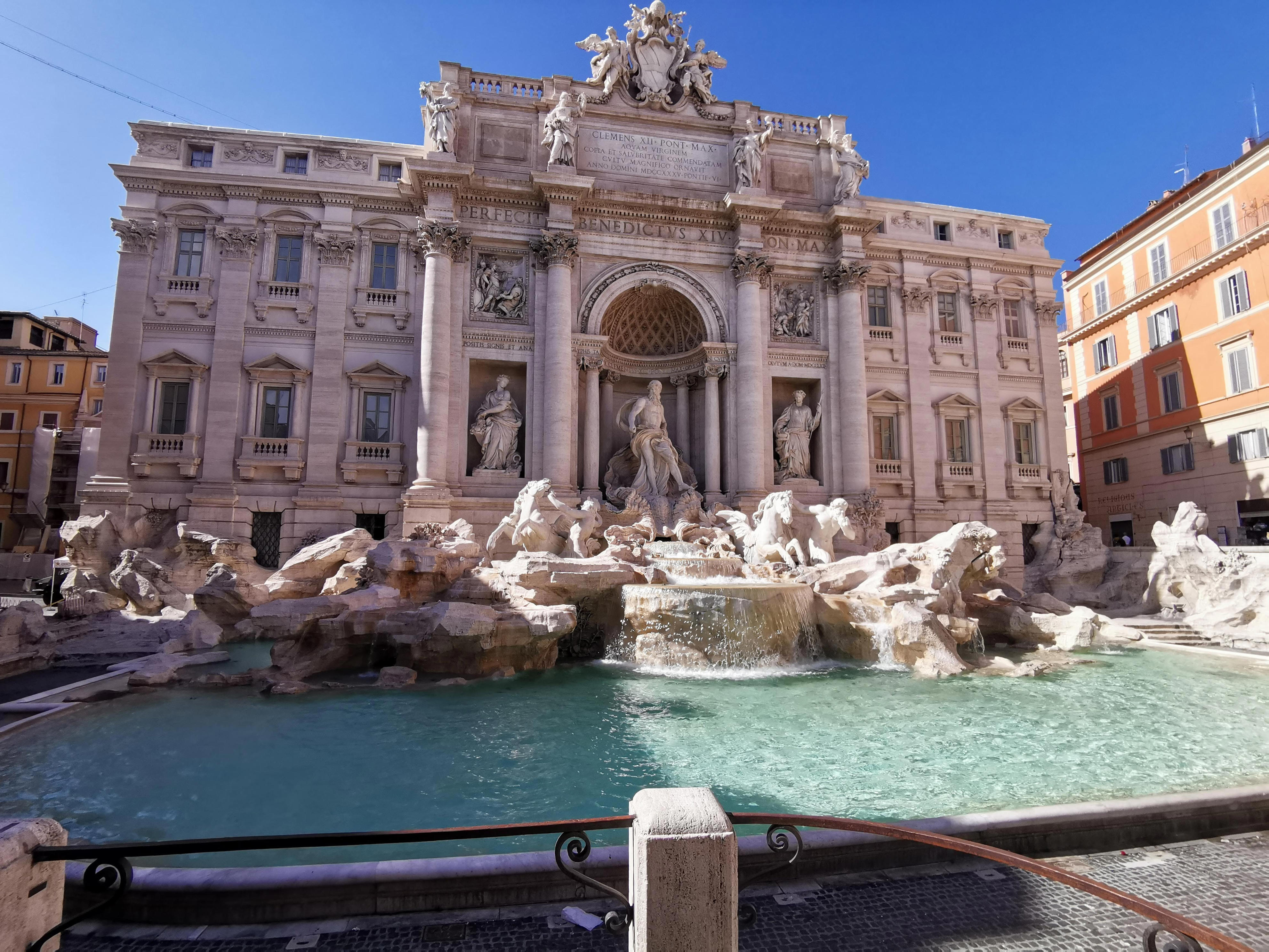
Everyone wants a photo in front of the Trevi Fountain — and that's the problem.
Although undeniably one of Rome's most famous landmarks , the Trevi Fountain is often teeming with tourists jostling for the perfect selfie.
The sheer volume of visitors can detract from the fountain's beauty and significance, making it challenging to appreciate it in peace.
If you insist on throwing a coin in, go as early in the morning as possible — otherwise, it's a zoo.
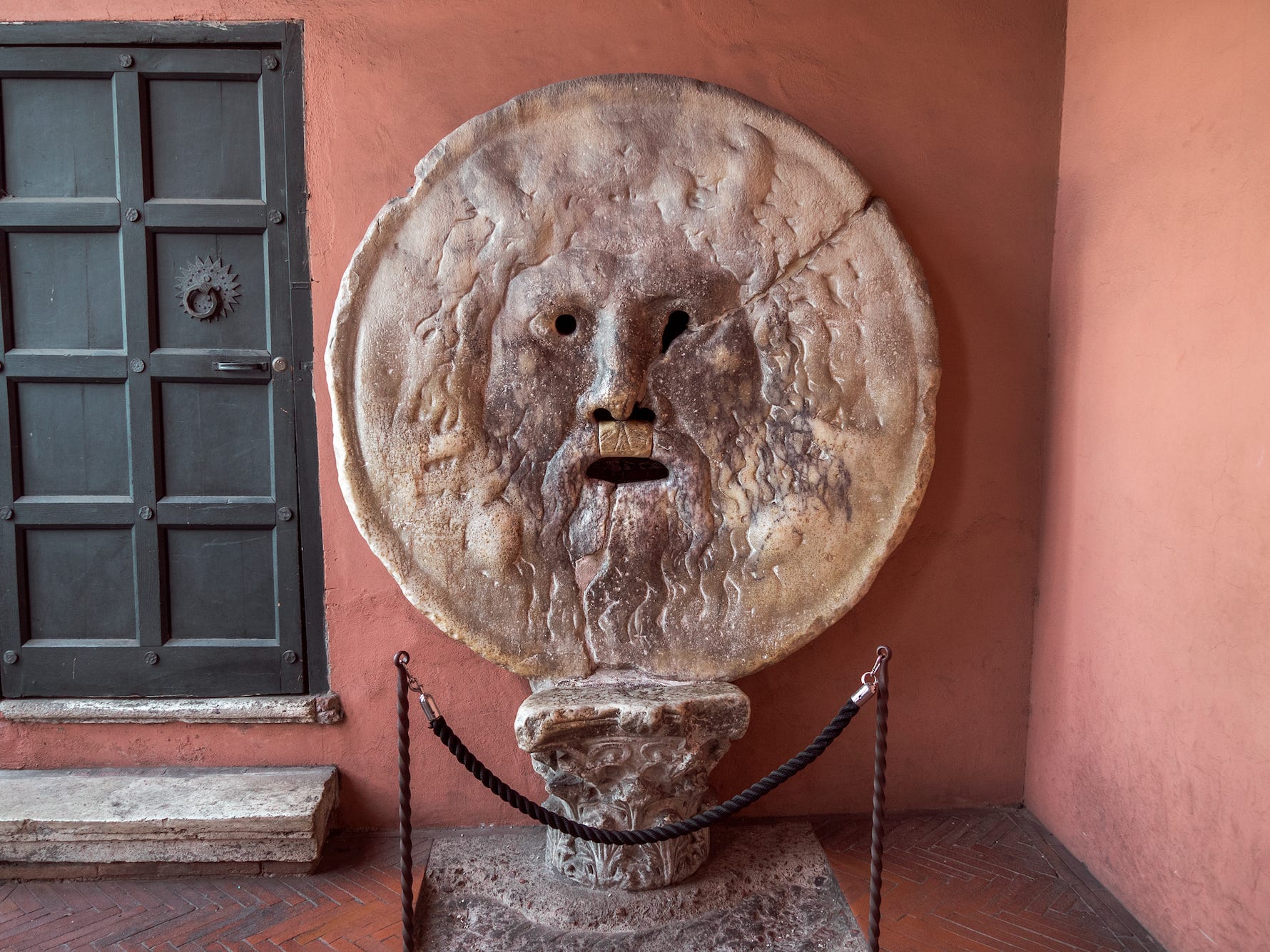
I wouldn't wait in line for the Mouth of Truth.
Made famous by its appearance in classic films like "Roman Holiday," the Mouth of Truth may not live up to the hype for many visitors.
According to medieval legend, the stone mask will bite off the hand of any liar who enters its mouth, which has made it popular with tourists.
But the brief photo opportunity doesn't justify the long queues. Plus, it was probably just used as a drain cover in the Temple of Hercules.
More for You
NBA commissioner Adam Silver calls flagrant foul on Caitlin Clark a ‘Welcome to the league’ moment
David Beckham's company settles $10M lawsuit with Mark Wahlberg's F45
8th Grade Teacher Shares the Wildest Things Students Have Ever Said to Her
The 10 happiest places to live in the US
“He asked me if I wanted to play all the white guys”: Robert Downey Jr. on His Weirdest Role after Avengers: Endgame
Amazon Keeps Selling Out Of These 45 Totally Genius Things For Your Backyard Under $30
If you have this much money in your 401(k), you're doing better than most—here's how to save even more
Apron Belly: How to Reduce Stomach Sagging
Golden Retriever Befriends Fawn
I Can't Help But Laugh At These 15 People Who Had To Learn Lessons The Hard Way
“It was like an animal with a gun”: Jenna Ortega Was Completely Dumbstruck after Witnessing Michael Keaton’s Brilliance on Beetlejuice 2
Trump Felony Would Mean Loss Of Secret Service, Perks Under Democratic Bills
My New Employee Keeps Leaving Early
LeBron James Left No Doubt When Naming the WNBA's Best Player
The 2 Fruits That Can Help Ease Constipation Fast
Top 10 Small Details You Didn't Notice on Young Sheldon
13 Car Brands Mechanics Warn Are the Worst ‘Money Pits’
Chip And Run Technique Explained
Clarence Thomas discloses trips with GOP donor as justices file new reports
8 Vintage Sodas Making a Comeback at Grocery Stores and Where to Find Them

COMMENTS
Rome: Colosseum, Roman Forum, and Palatine Hill Guided Tour. 4,641. Benefit of easy access to the Colosseum, Roman Forum, and Palatine Hill during this tour of the sights in ancient Rome. With a guide, head into the Colosseum to walk in the footsteps of gladiators, emperors, and plebeians as tales of the brutal games ring in your ears.
Then head over to the Roman Forum for the second part of your tour, enhanced with live commentary from your guide. After around 45 minutes exploring the forum, head up to Palatine Hill, the final stop on your tour. Wrap up your tour exploring the ruins and learning about how Rome was founded. Colosseum. 1 hour 30 minutes • Admission Ticket Free.
Guided tour of the Colosseum with 1st and 2nd tiers. A guided tour of the Roman Forum with skip-the-line tickets. Walking tour of Palatine Hill. An expert English-speaking guide. A maximum group size of 24. After booking this epic underground tour, you'll hear from our friendly Travel Experts who'll ask for your name and birthday.
Take a guided tour of the Colosseum, including skip-the-line admission, to get the most out of your visit. By exploring the amphitheater's first and second tiers with an official Colosseum guide, who has a background in history, art, and archaeology, learn about the origins of this iconic Rome landmark. Hear stories about gladiator battles and Roman emperors, and marvel at the engineering of ...
Rome: Guided Tour of Colosseum, Roman Forum & Palatine Hill. Enter the Colosseum through a dedicated group entrance. Follow in the footsteps of gladiators and see the monument from a 360° panoramic vantage point. Imagine what it was like to see 50,000 blood-thirsty spectators with help of your guide. Visit the Forum and walk around several ...
Colosseum Underground Tour with Roman Forum and Palatine Hill. Get special access to the Underground dungeons and Arena Floor on this guided small group tour. (970) From: $180.18. Free cancellation and 1000s of 5-star reviews make our wide selection of shore excursions to Rome an easy choice! Find start times and dates that work for your schedule!
15 Turin. 16 Bologna. 17 Polignano a Mare. 18 La Spezia. 19 Cala Gonone. 20 La Maddalena. Join this invigorating tour of the Colosseum and Ancient Rome to get to the heart of Rome's ancient empire. Learn about the trials and traumas of the gladiators who battled in the Colosseum and continue to the beautiful Roman Forum.
[email protected]. 0039 06 474 2501 / 0039 348 8112027 (Whatsapp only) (November to March, Monday to Saturday, 6:30 AM - 7:00 PM & Sunday 6:30 AM - 8:15 PM. April to October, every day, 6:30 AM - 9:00 PM) Discover the stories behind Rome's grand monuments on this 3-hour guided tour of the Colosseum, Roman Forum and Palatine Hill.
The tour of the Colosseum as well as the Roman Forum and Palatine Hill tour combine to create an immersive and unforgettable experience of Rome's fascinating history. Book Tickets & Guided Tours of the Roman Forum & Palatine Hill. Reserve your online tickets. Best price guarantee.
Full description. Embark on a guided tour of the Colosseum with access to the Gladiator's Arena and dungeons. Hear about the world of Ancient Rome from your guide and visit the Roman Forum and Palatine Hill. Meet your guide at the activity provider's office then head to the iconic Colosseum. Enjoy exclusive access down to the restricted ...
The Roman Forum is the heart of Ancient Rome and, nowadays, one of the most important archaeological sites in Rome and in the world. ... How to visit the Roman forum: guided tour or self guided? 2021 Update. The Roman Forum is a place so full of history and thing to see it is best enjoyed with a guide.
Includes access to The Colosseum, Roman Forum and Palatine Hill, Vatican Museums & Sistine Chapel, St. Peter's Basilica (official guided tour), and more… Rome Super Pass with Public Transport - Skip-the-line entrance to some of Rome's best attractions with this combi-ticket. Includes unlimited public transport PASS (metro, bus, tram).
Enjoy a walking tour of the Roman Forum, originally filmed in 2017. This updated walk is narrated by Martina Sorrenti, an official tour guide of Rome. Visit ...
The Roman Forum was where religious and public life in ancient Rome took place. The Forum is, ... The best way to skip the line and get to know the Forum in detail is to take a guided tour. We'll visit three of the main monuments in the city, the Colosseum, Roman Forum, and Palatine Hill, skipping the line, and all with an expert guide. ...
4.5. 500+ reviews. Travel back in time to the era of Roman Emperors and gladiator games with a guided tour of the Colosseum and Roman Forum. Uncover the mysteries behind the world's largest amphitheater and stroll through the political and commercial heart of Ancient Rome with the help of an expert guide.
Colosseum and Ancient Rome Tour Description. Your 3-hour walking tour includes: Skip-the-line Colosseum tickets. Skip-the-line Roman Forum and Palatine Hill tickets. Guided tours of the Colosseum, Roman Forum, and Palatine Hill. An engaging, English-speaking local guide. A maximum group size of 25
Here's my guide to 16 must see monuments, attractions, and ruins in the Roman Forum in Rome, with tips for visiting. The Roman Forum is an absolute must visit attraction in Rome, and should be on your Rome itinerary. The forum can be a challenge to decipher. But, with this guide in hand, you can tour the forum and know exactly what historic ...
Self Guided Tour of Palatine Hill and Forum Romanum Attractions Palatine Hill and The Roman Forum Walking through the roman forum buildings and palatine hill ruins takes us back to a time when this small piece of land was the center of the Greatest Empire known to man namely the Roman Empire that spanned over 1,200 years .
Access to the Colosseum, Roman Forum & Palatine Hill. Headsets to hear your guide clearly. Fully guided visit of the Colosseum. Colosseum Entry ticket (€18) Colosseum Entry ticket with Arena (if Semi Private option is selected €24) Gratuities. Hotel pickup and drop-off.
Roman Forum Walking Tour with Map. This post is a self-guided tour of the Forum in Rome as well as the adjacent Imperial Fori. The tour should take approximately 1 hour or just a bit less than that. The walk is approximately 1 km (just over 1/2 a mile). This walk is an abridged version of our Ancient Rome audio tour.
4.6. 2 900+ reviews. Delve deep in the history of ancient Rome with a guided visit to the Colosseum, its world-famous arena where gladiators fought to the death and the hypogeum, the underground 'backstage' network of tunnels and chambers. Continue your journey through time with a tour of the Roman Forum and Palatine Hill.
After meeting at the Arch of Constantine, your small group and expert guide will enter the ancient Colosseum. Listen as they bring to life this historic stadium, painting exciting pictures of the glorious games, bloodthirsty fights, and gory executions that happened here for almost 500 years! As we move to the Palatine Hill and Roman Forum, you ...
No one skips the security line, regardless if they are on a tour or not. By buying advanced entry tickets or a tour you bypass the ticket lines, but not the security line so there is no advantage of buying a guided tour if you just want to bypass the ticket lines. If you don't normally do guided tours I would say to just purchase general entry ...
Rome: Colosseum, Roman Forum & Palatine Hill Experience. 102. from $54.18. Rome, Italy. ROME: Skip-the-Line Sistine Chapel & Vatican Museums- small group. 1. ... Guided tours in Spanish with skip-the-line ticket for Vatican City. 1. from $165.85. Likely to Sell Out. Rome, Italy. Vatican Museum skip the line ticket. 2.
1,042 reviews. 1,650 helpful votes. Side door from Sistine Chapel to St. Peter's Basilica. Jun 6, 2024, 3:58 PM. The question keeps getting asked over and over whether or not guided tours can go from the Sistine Chapel via the side door (sometimes called the "secret door," "shortcut," or "special passage") to St. Peter's Basilica, therefore ...
5. Rome: Guided Tour of Colosseum, Roman Forum & Palatine Hill. Enter the Colosseum through a dedicated group entrance. Follow in the footsteps of gladiators and see the monument from a 360° panoramic vantage point. Imagine what it was like to see 50,000 blood-thirsty spectators with help of your guide.
2 reviews. Rome Italy- Guided Tour or not? Jun 4, 2024, 4:37 PM. I will be in Rome in May 2025. I want to visit the Colosseum. Should I do a guided tour for the best experience or will a self purchase ticket give me the same perks? Reply. Report inappropriate content.
3-Hour Colosseum Tour for Kids and Skip-the-Line Tickets. from $83.38. Rome, Italy. From the sunset to the night private tour in Rome. from $217.89. Price varies by group size. Likely to Sell Out. Rome, Italy. Gladiator's Gate: Special Access Colosseum Tour with Arena Floor.
Rome: Guided Tour of Colosseum, Roman Forum & Palatine Hill. Enter the Colosseum through a dedicated group entrance. Follow in the footsteps of gladiators and see the monument from a 360° panoramic vantage point. Imagine what it was like to see 50,000 blood-thirsty spectators with help of your guide. Visit the Forum and walk around several ...
After 16 years of working as a tour guide in Rome, I've figured out the best attractions.; I always recommend visiting the Park of the Aqueducts and the Ostia Antica archeological site. But I ...